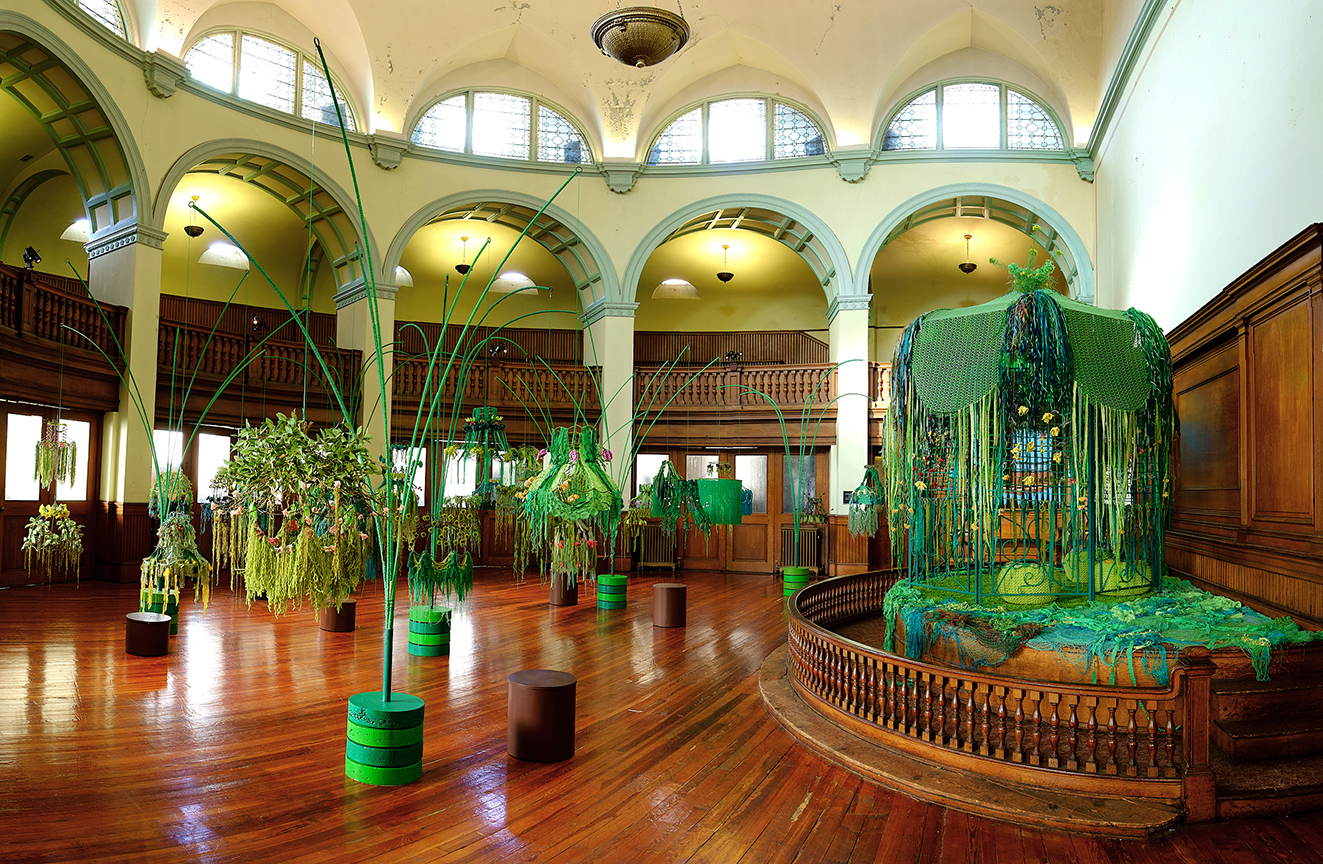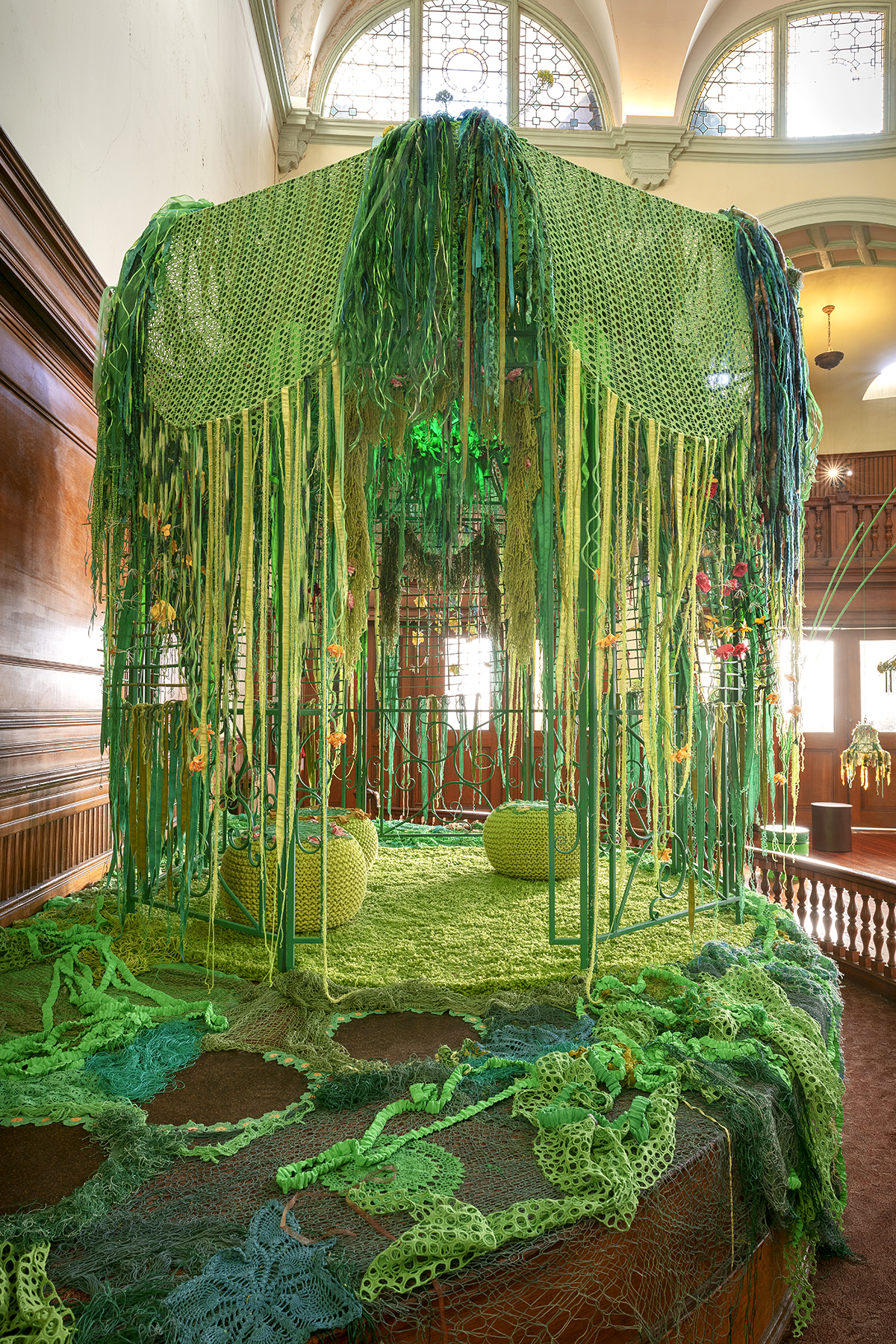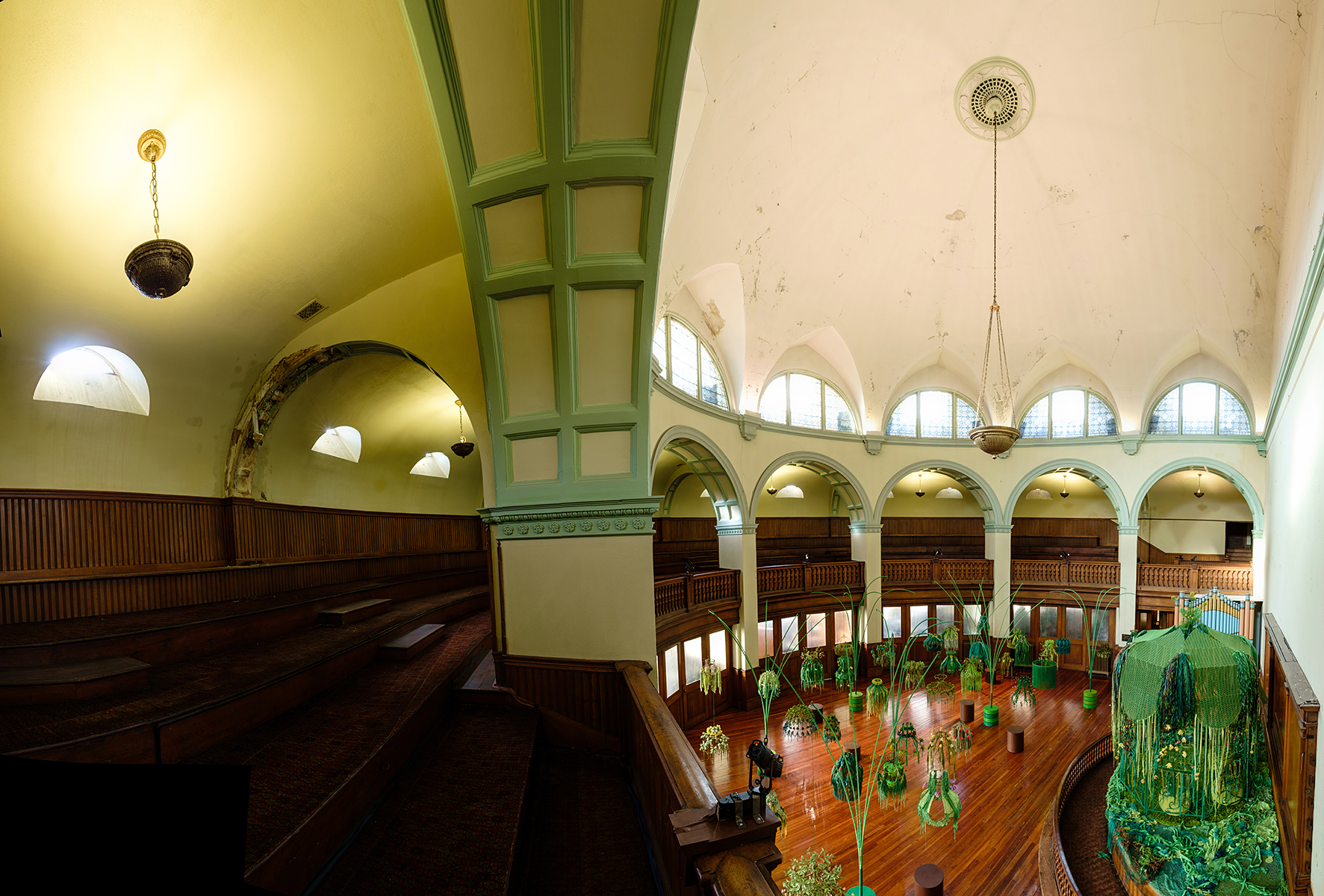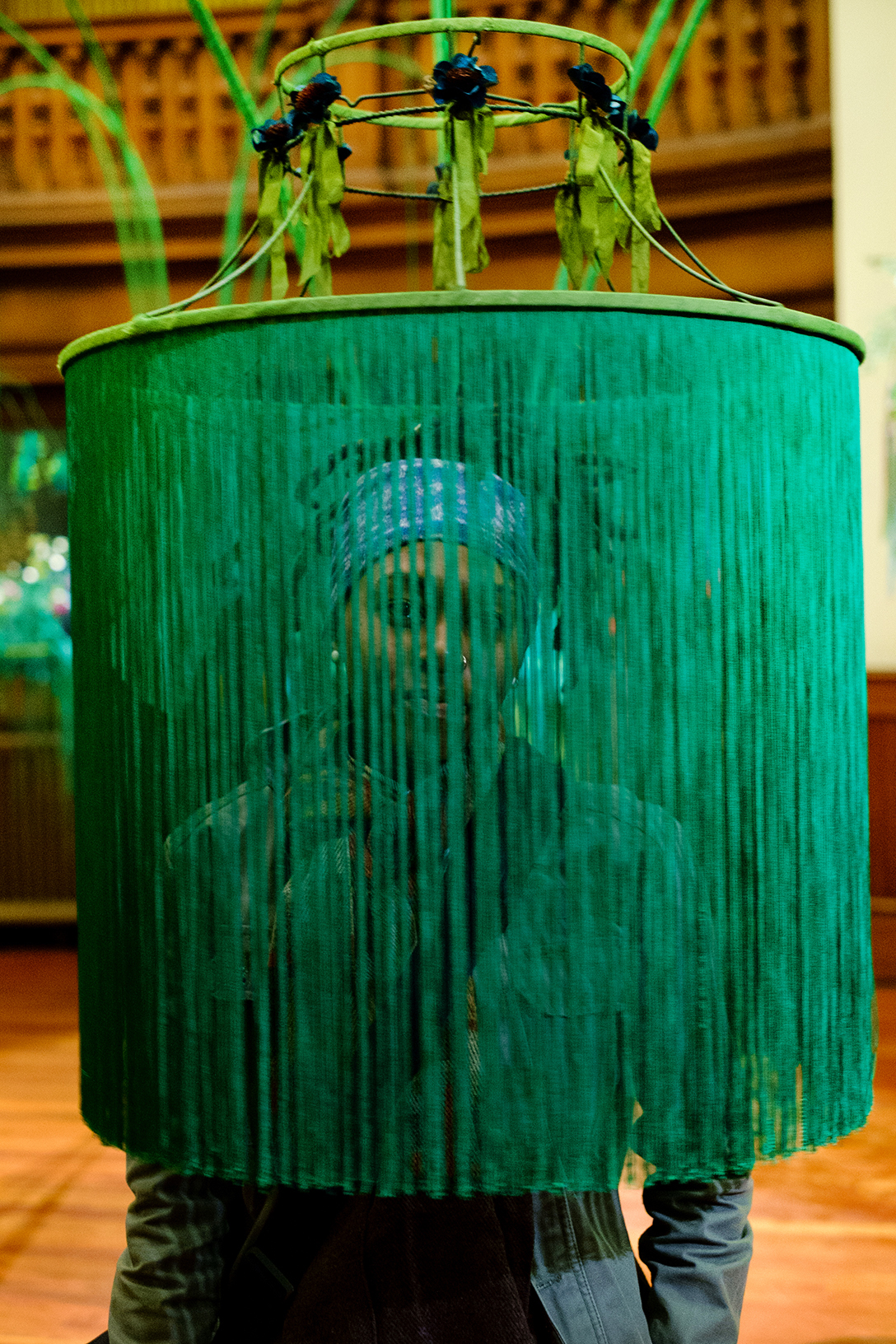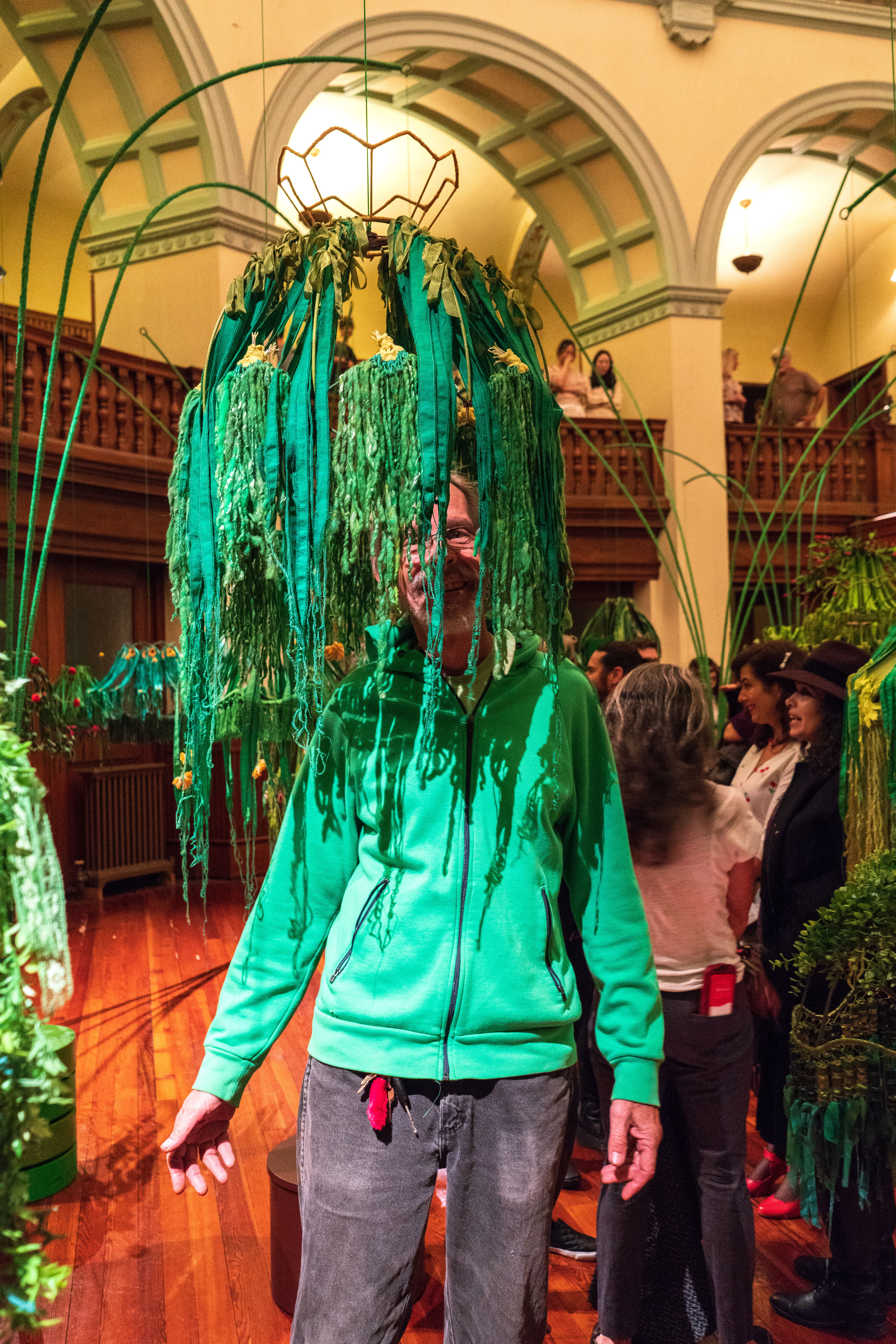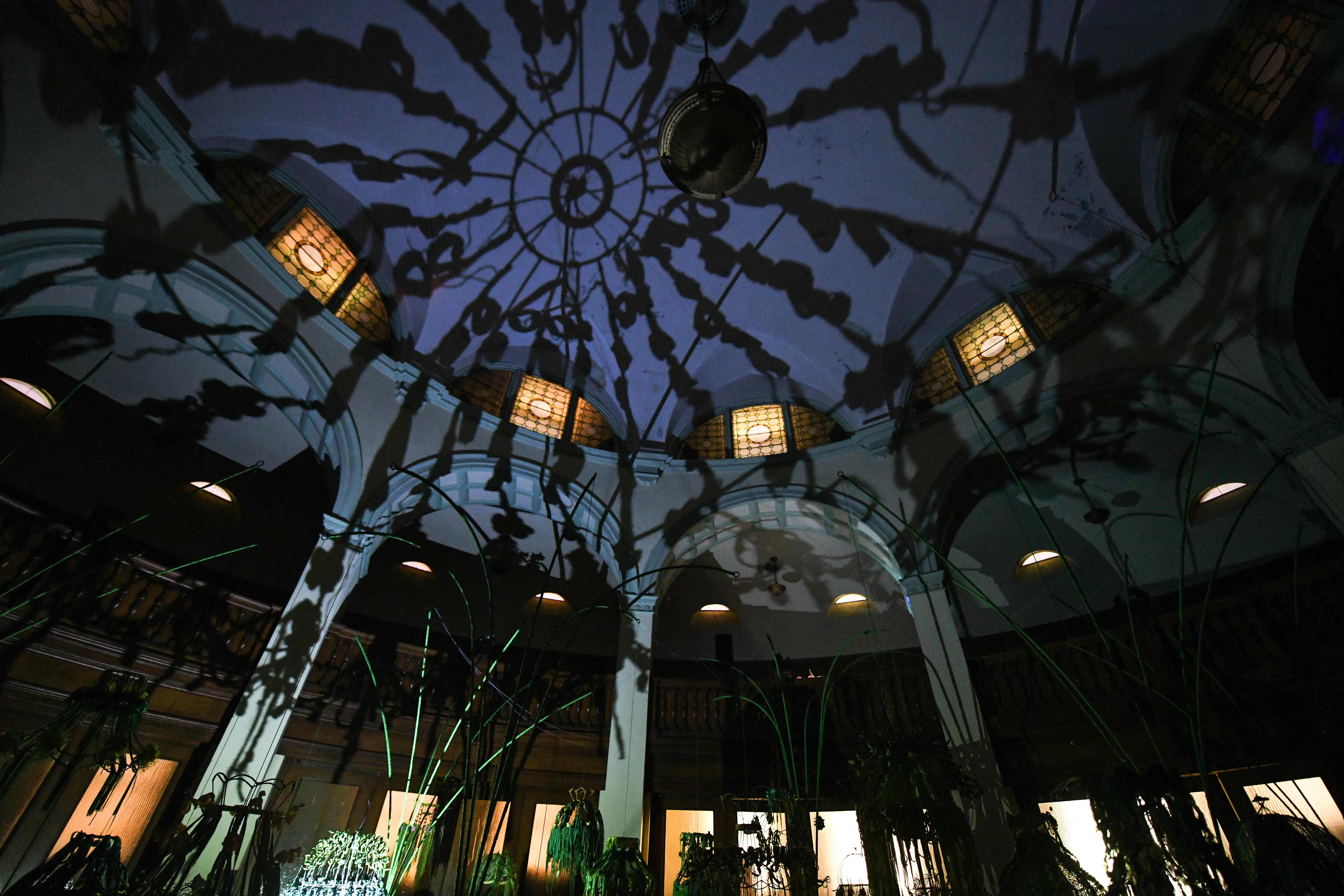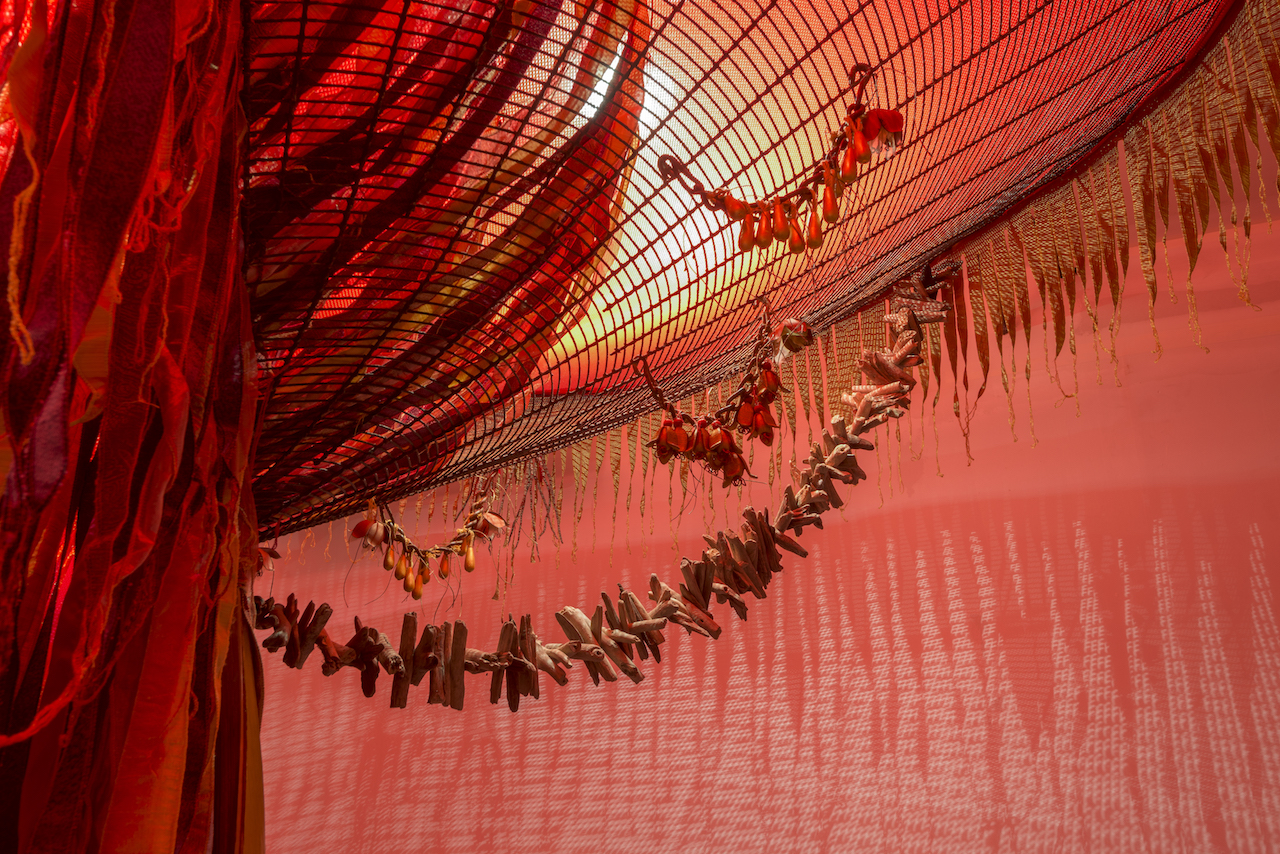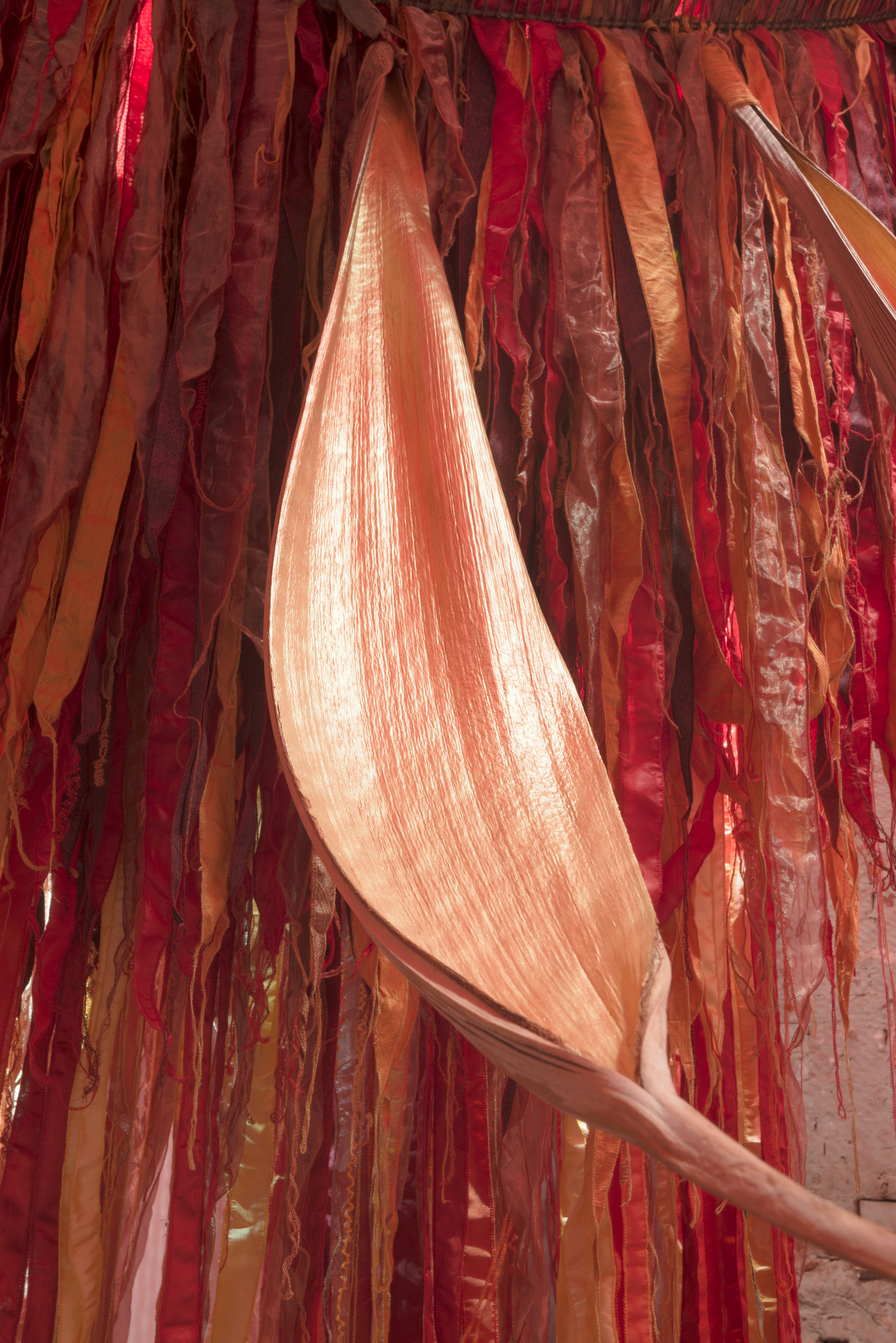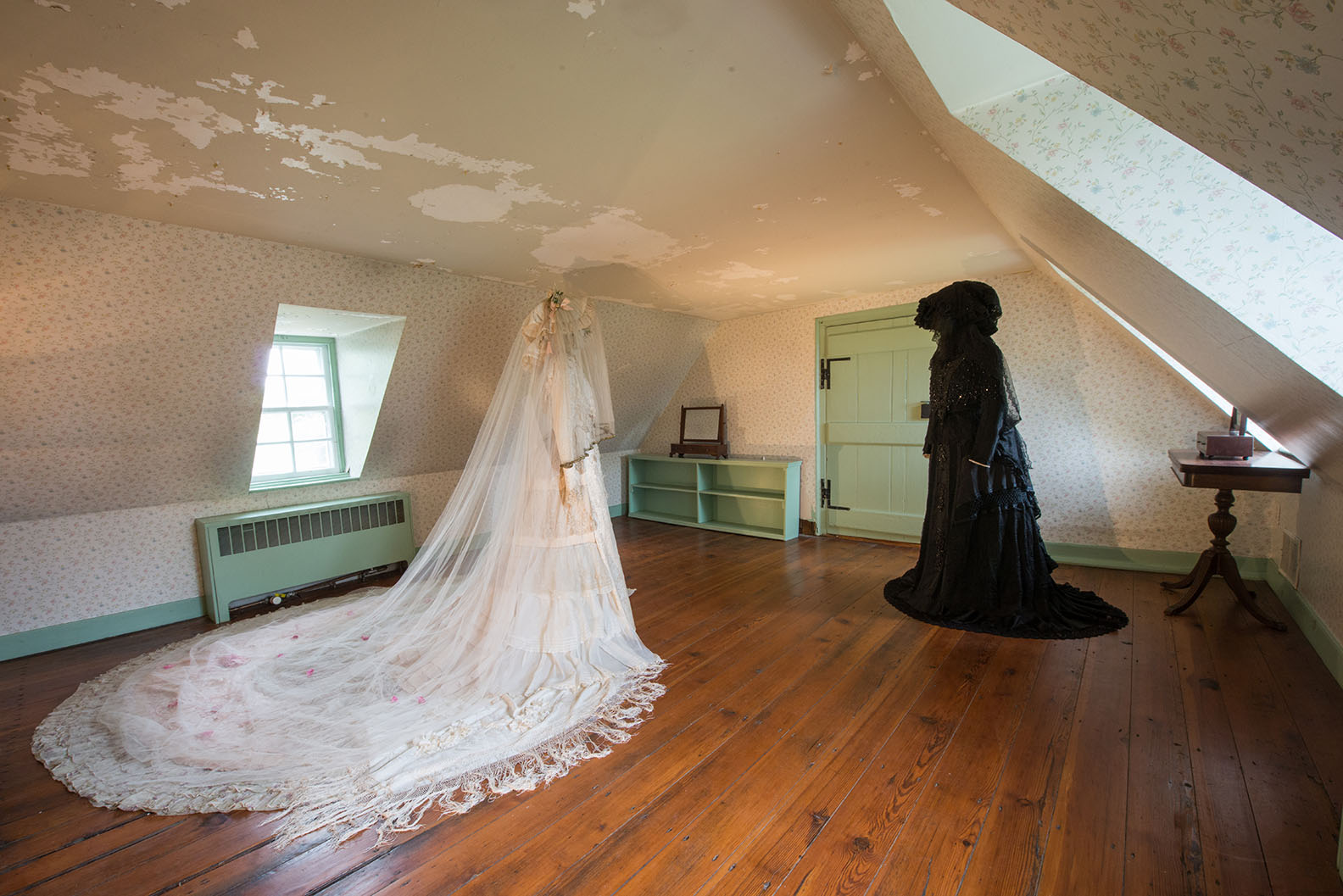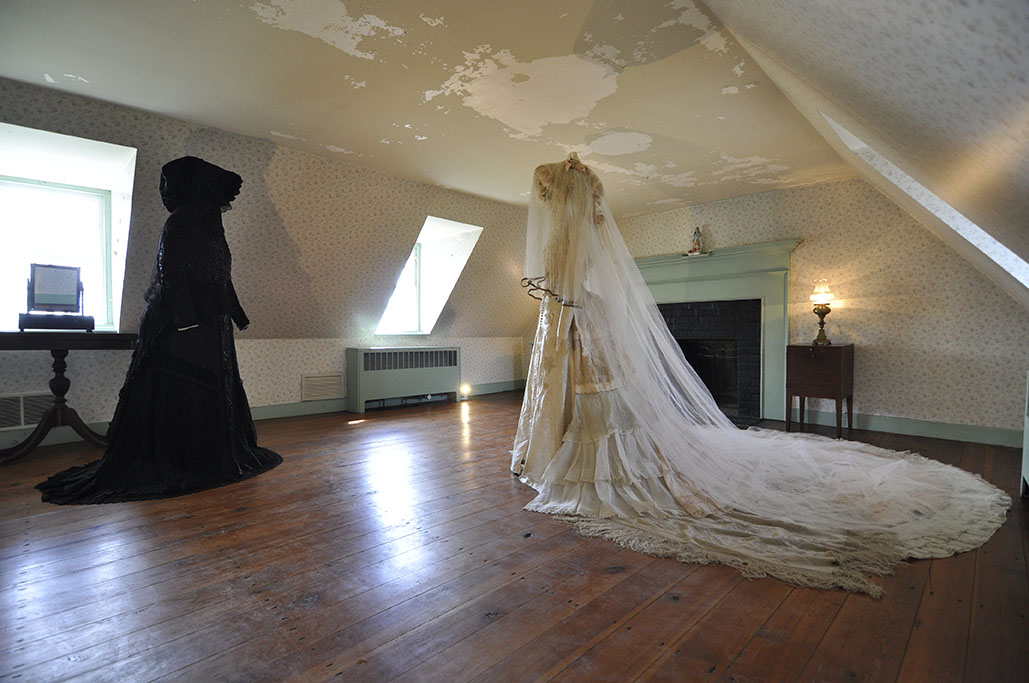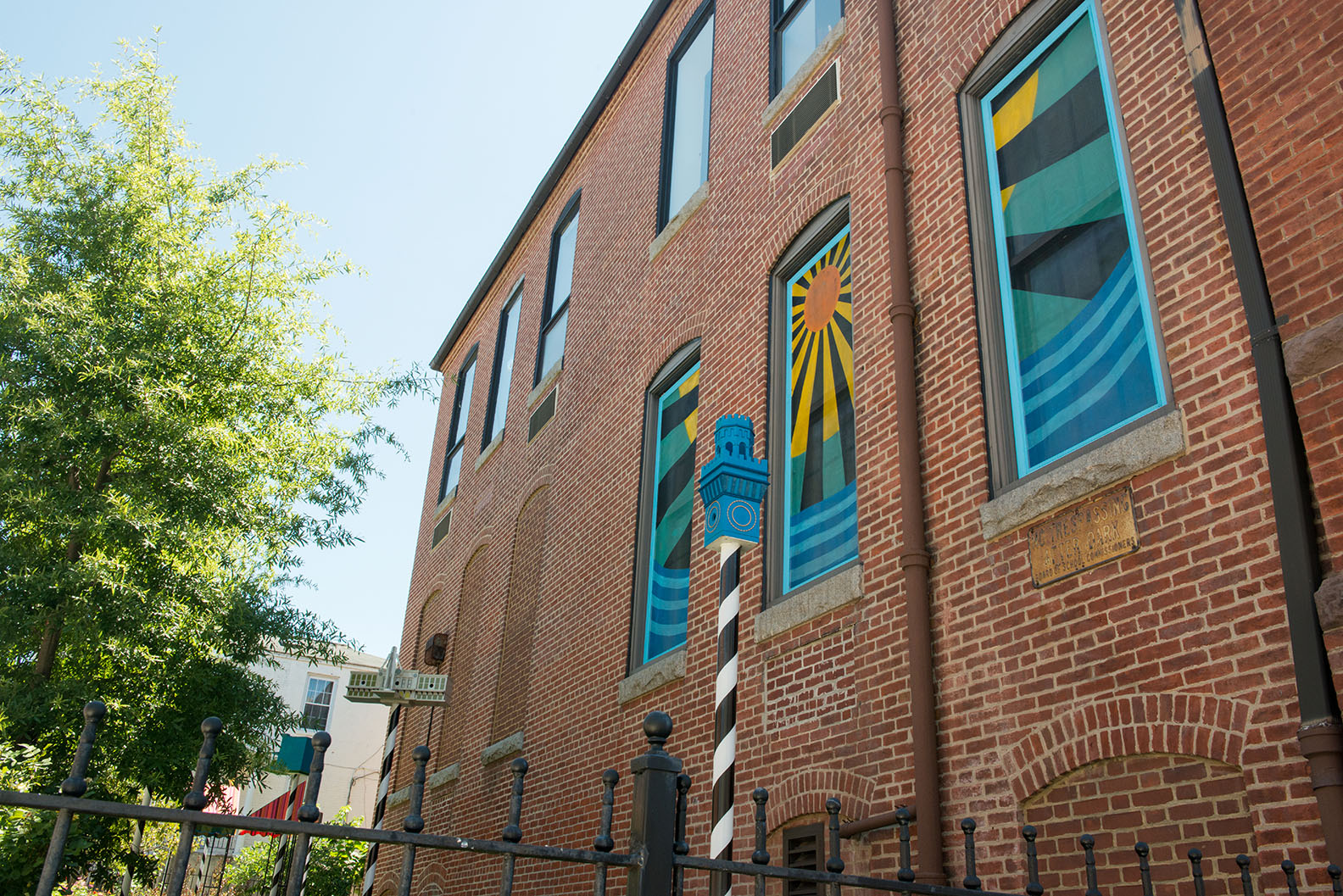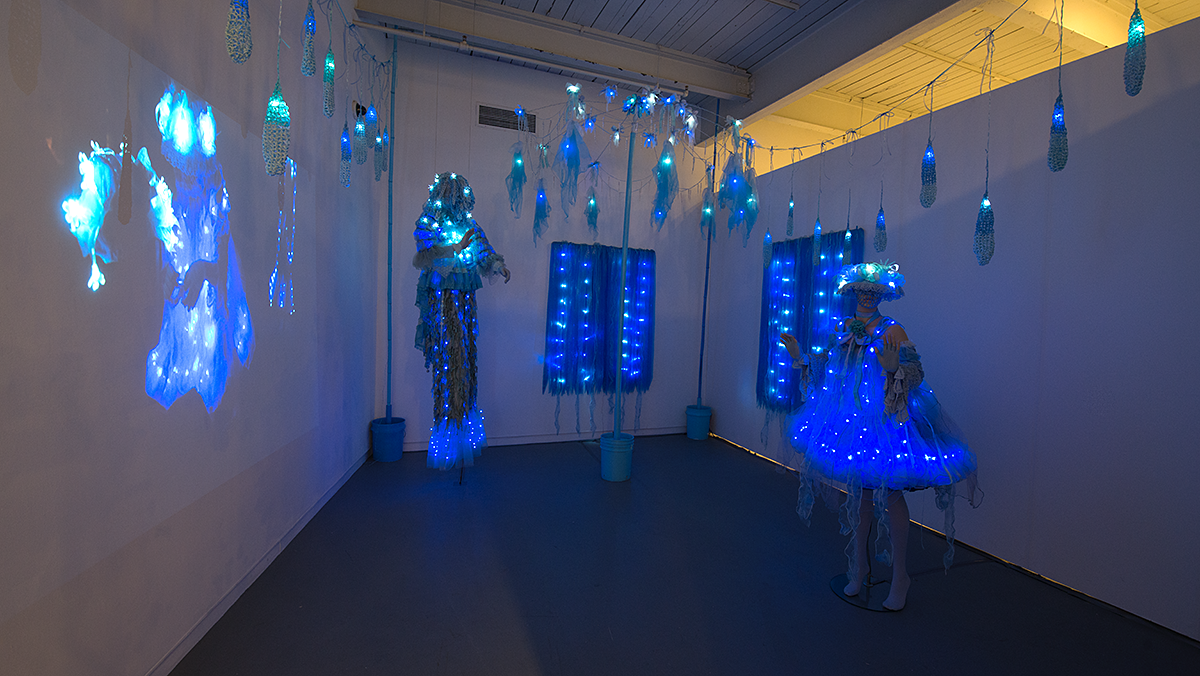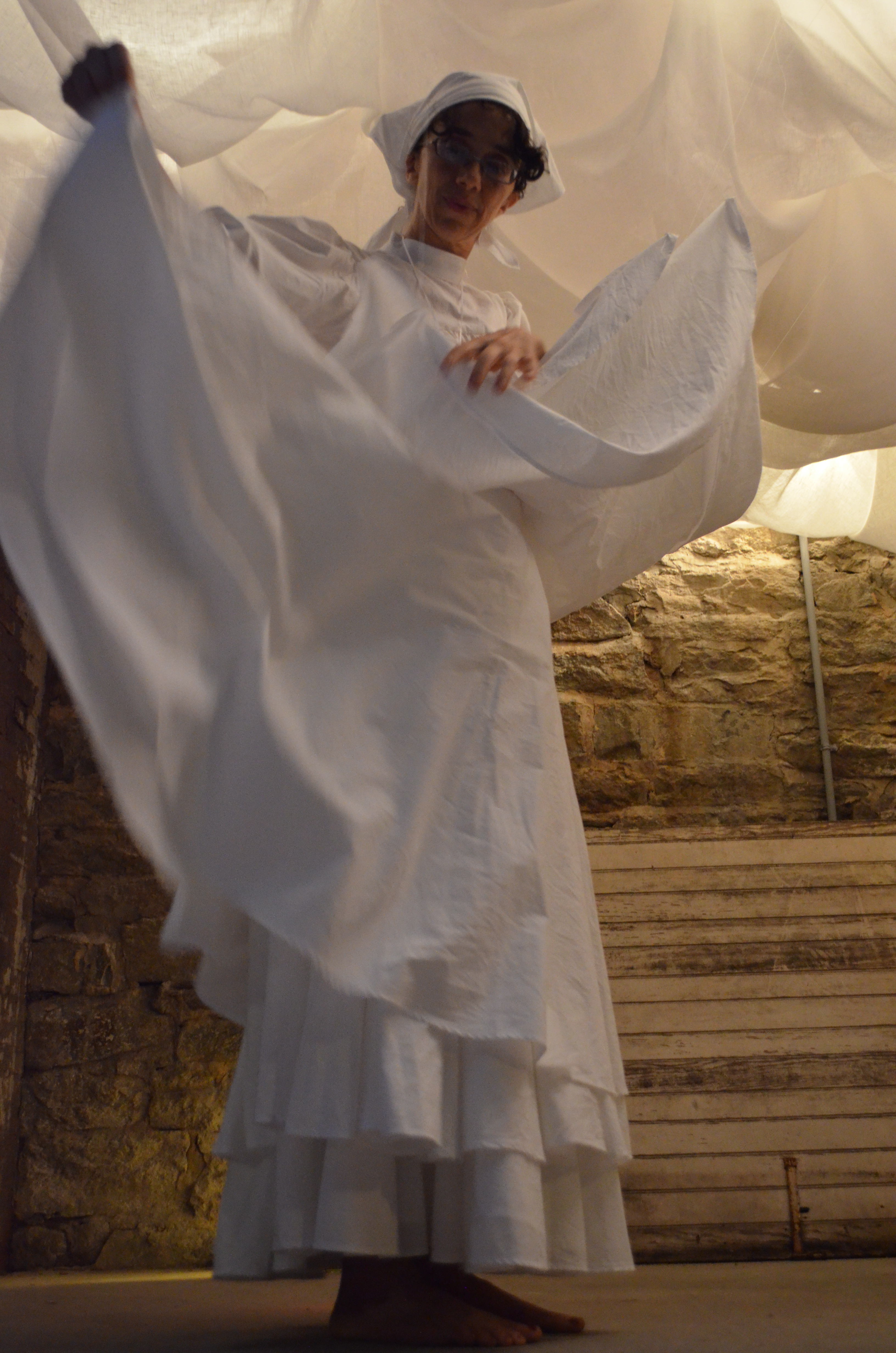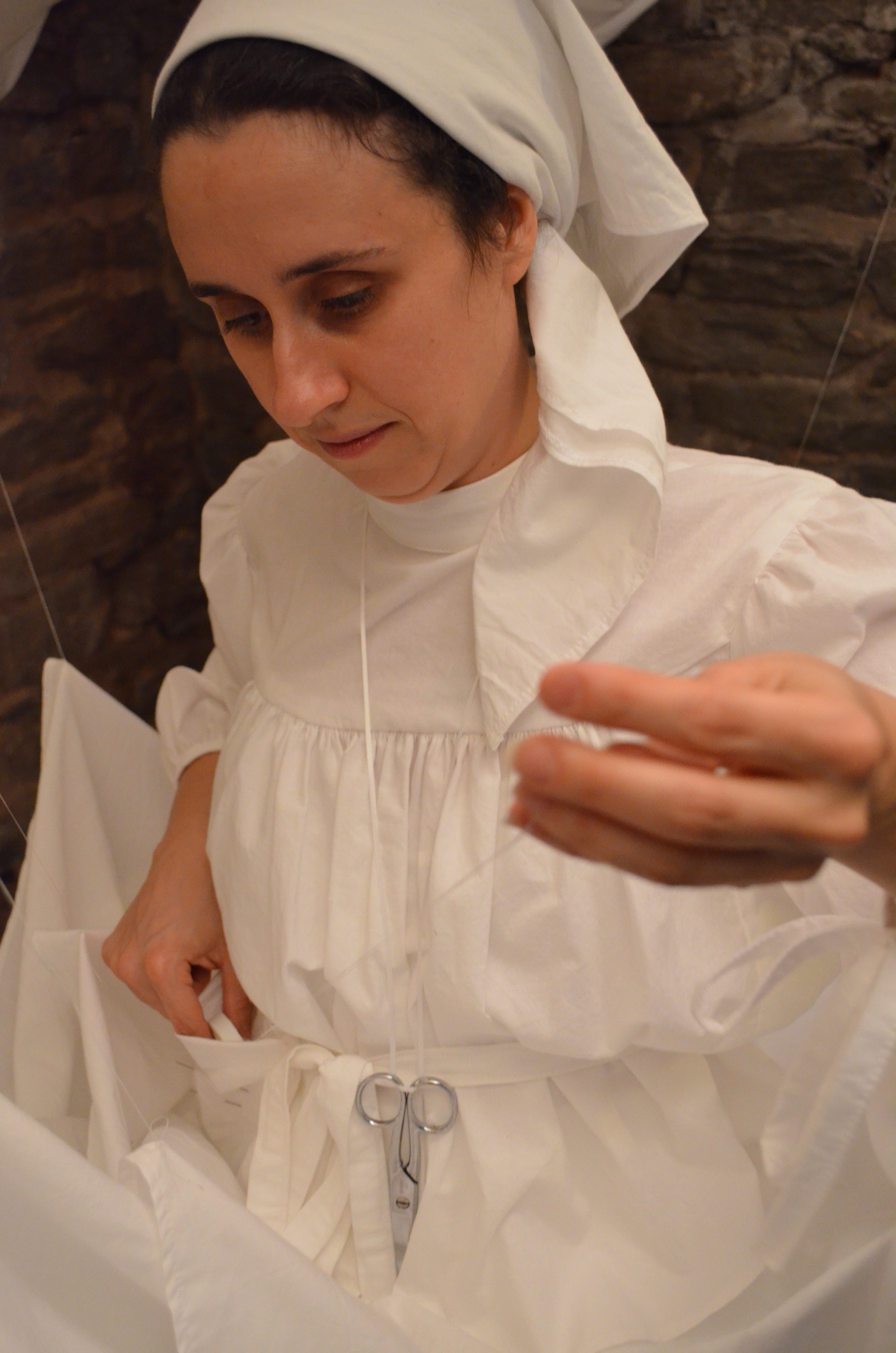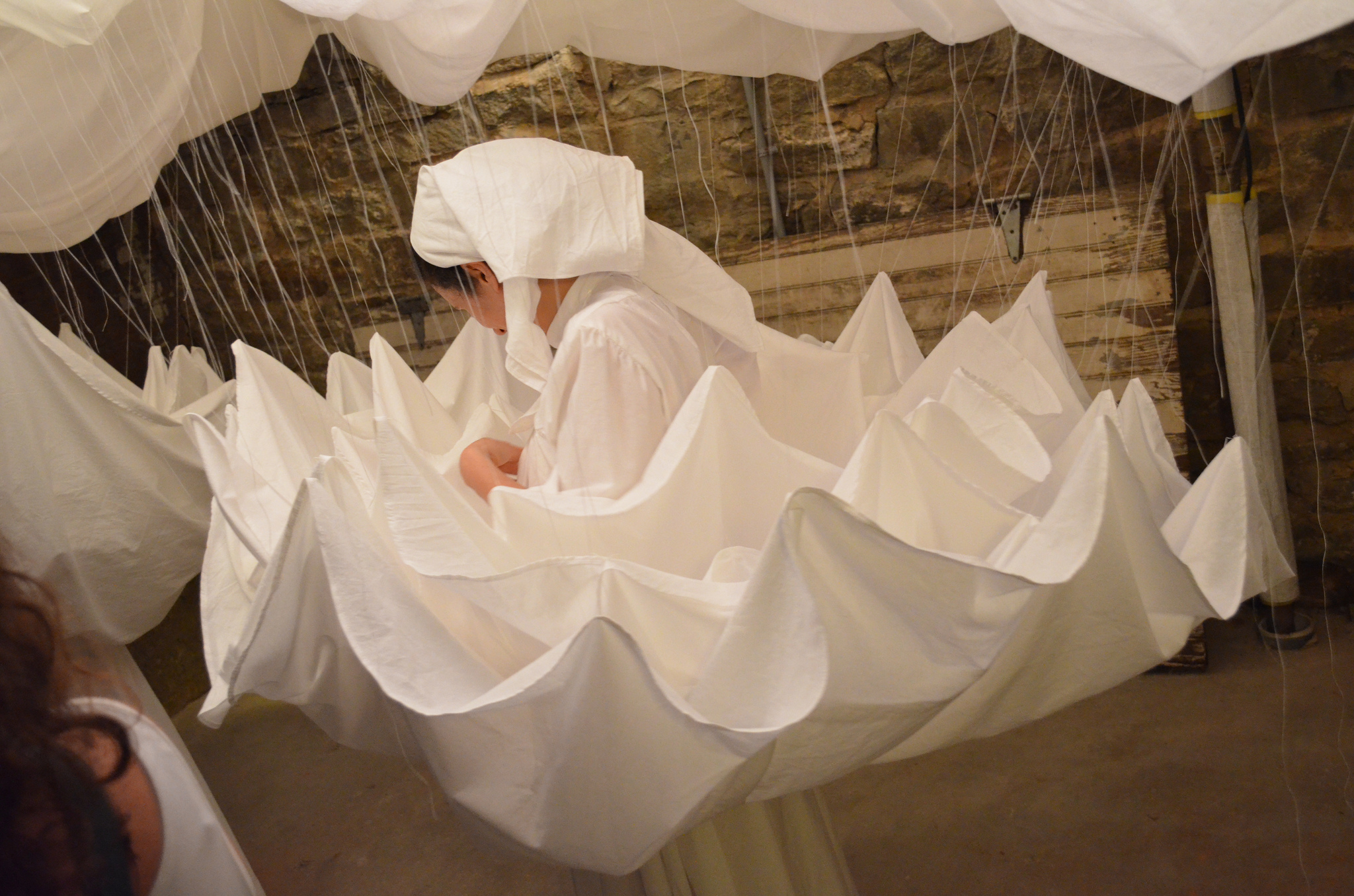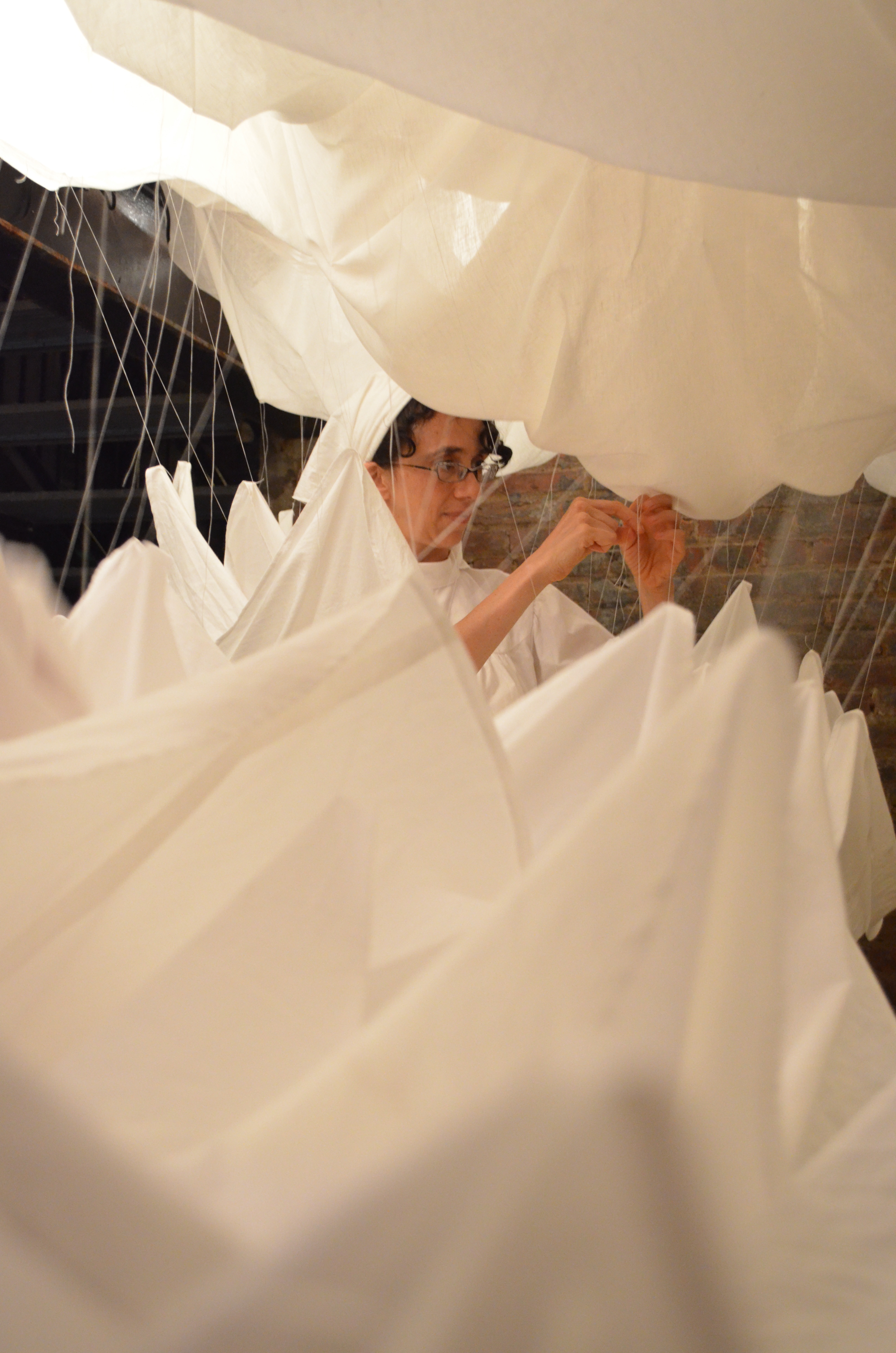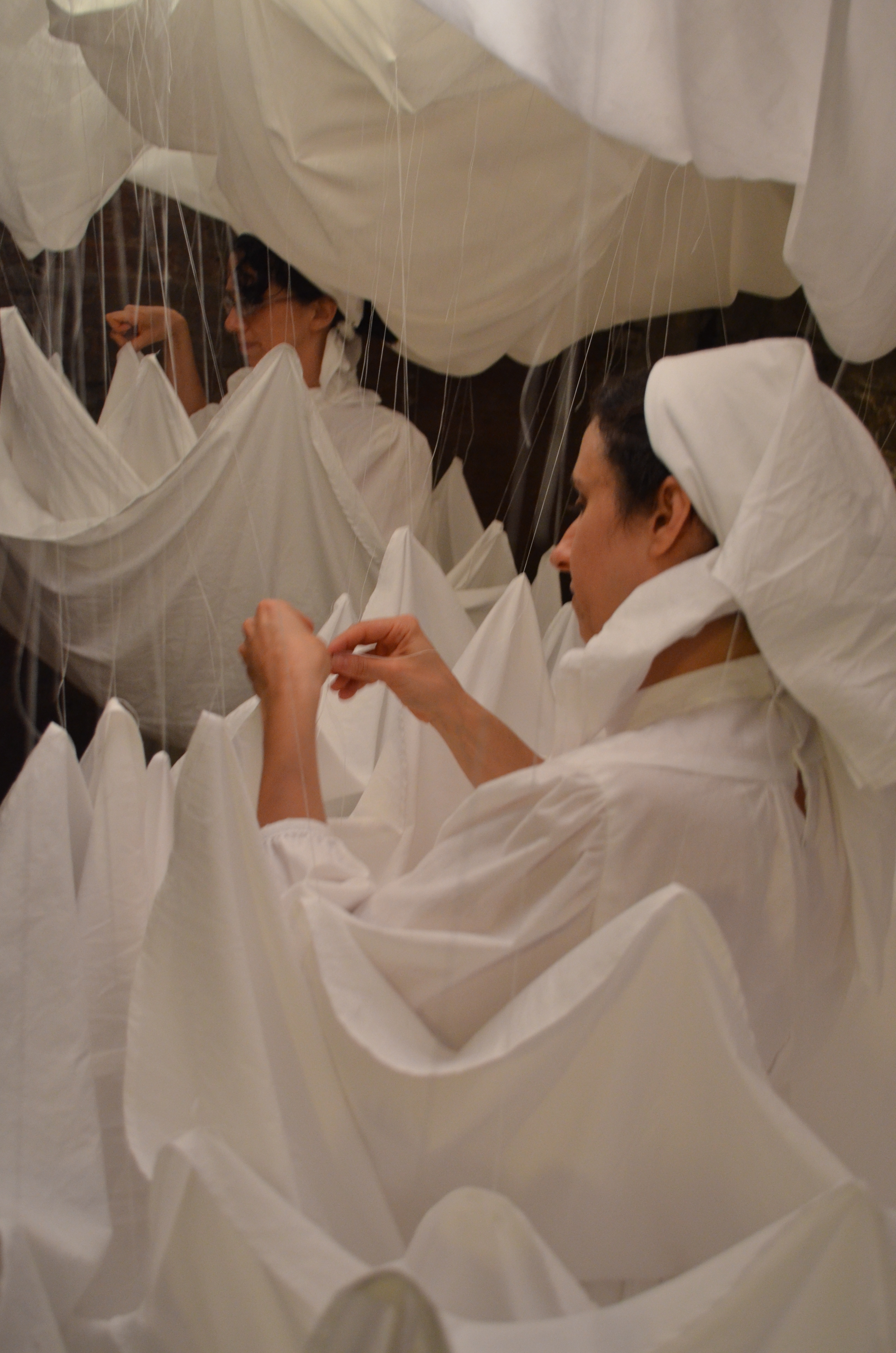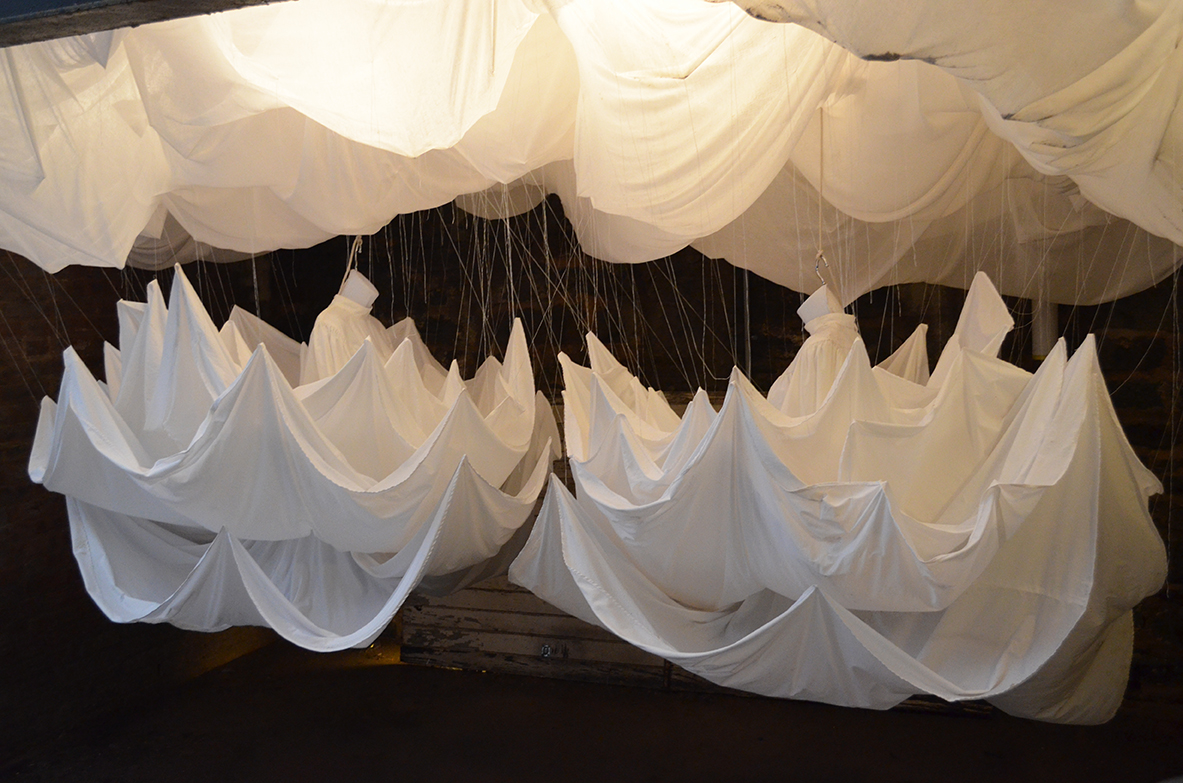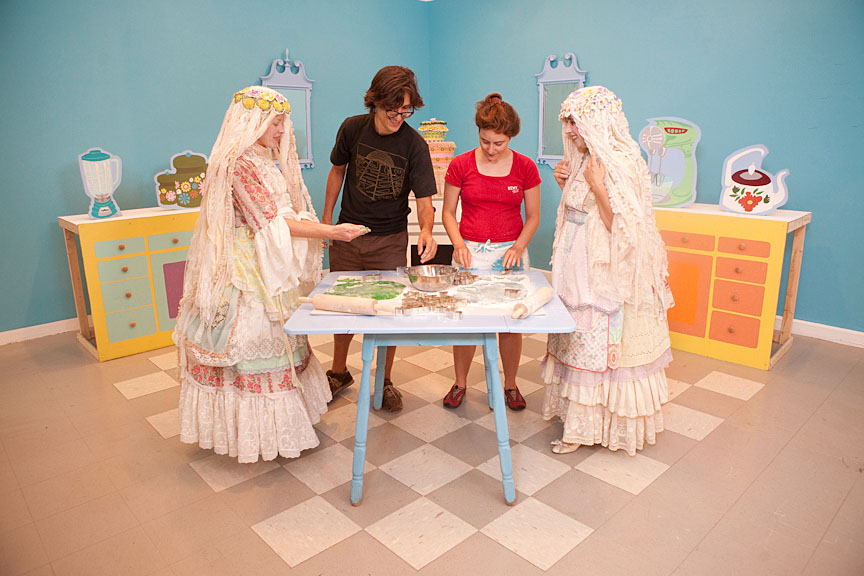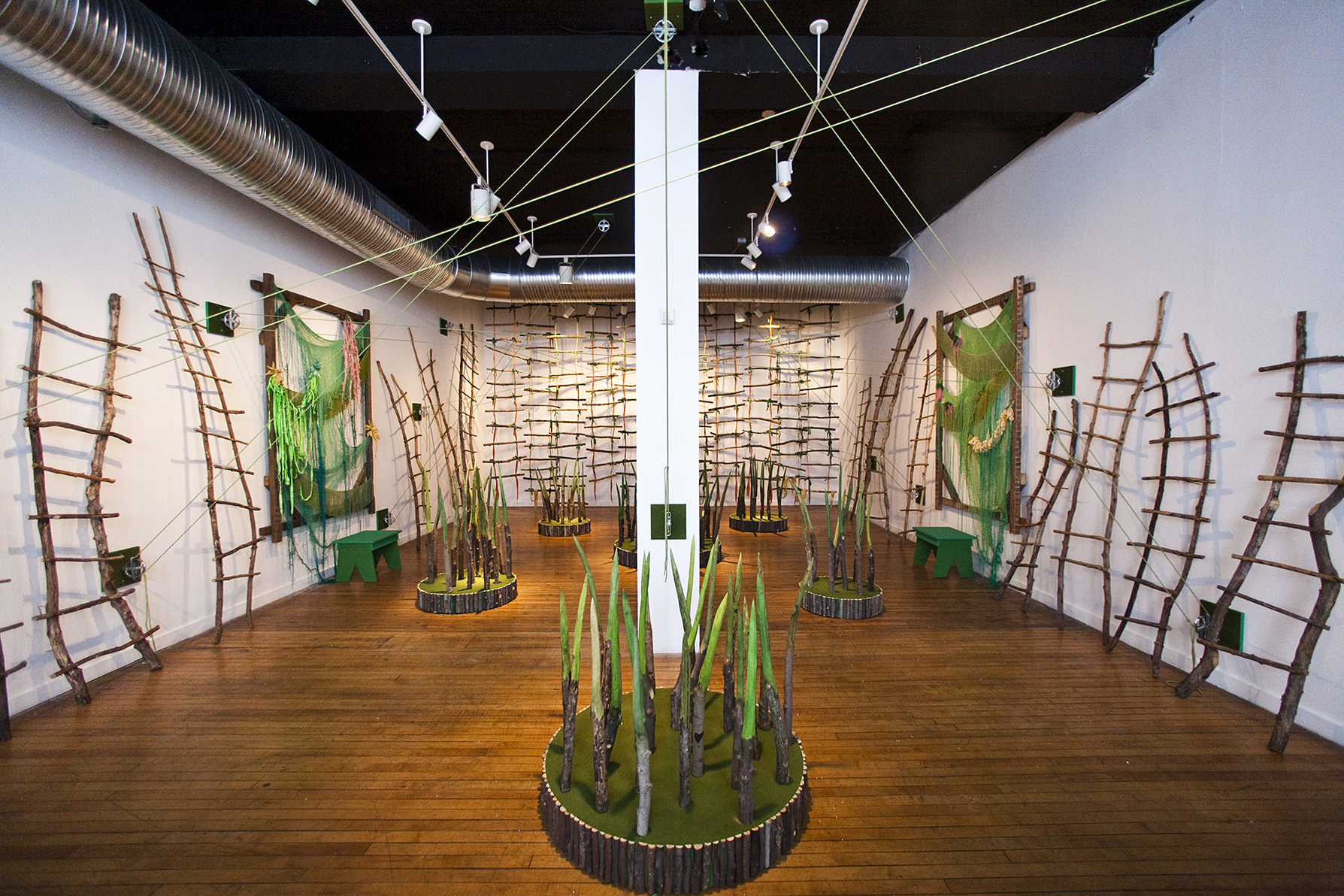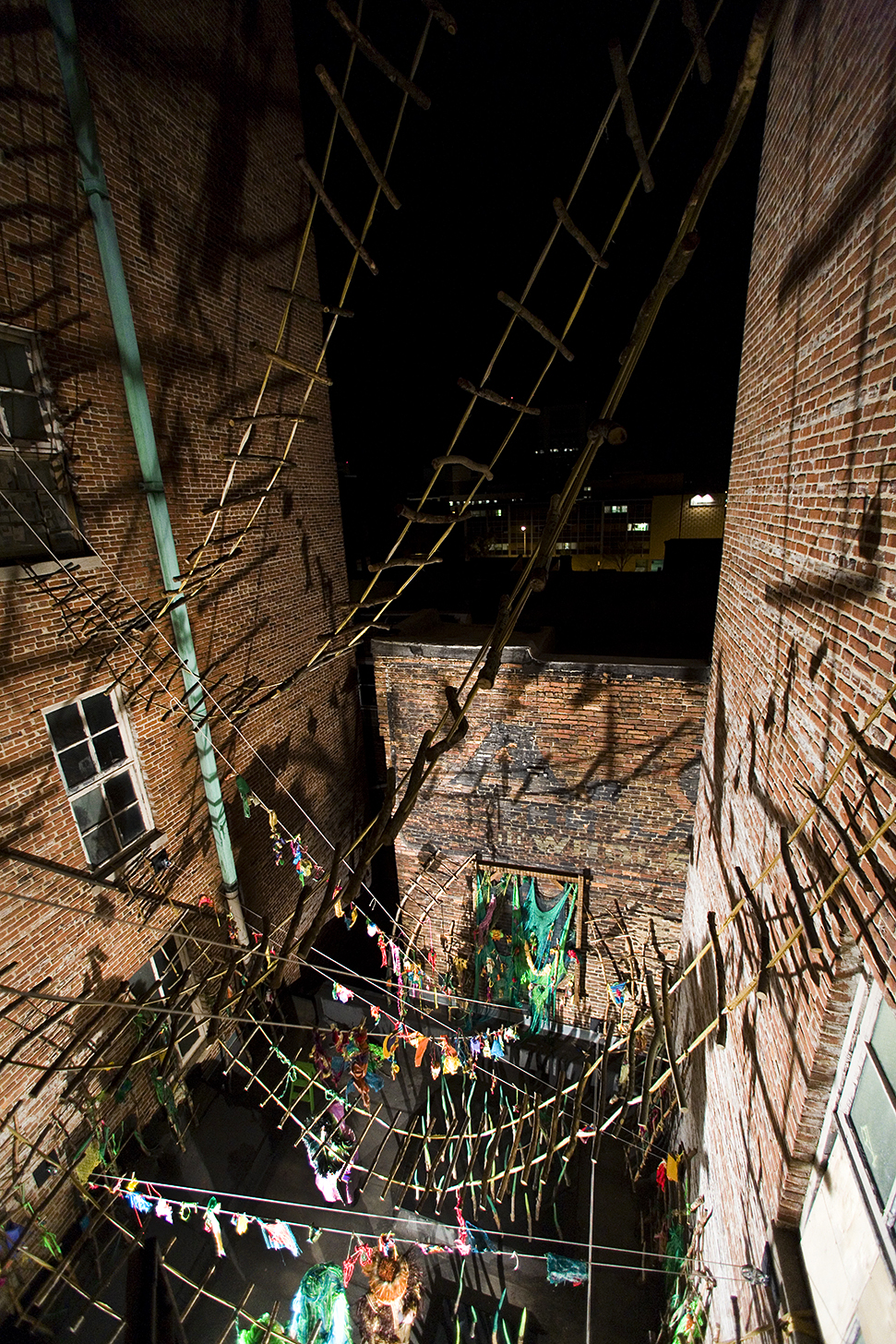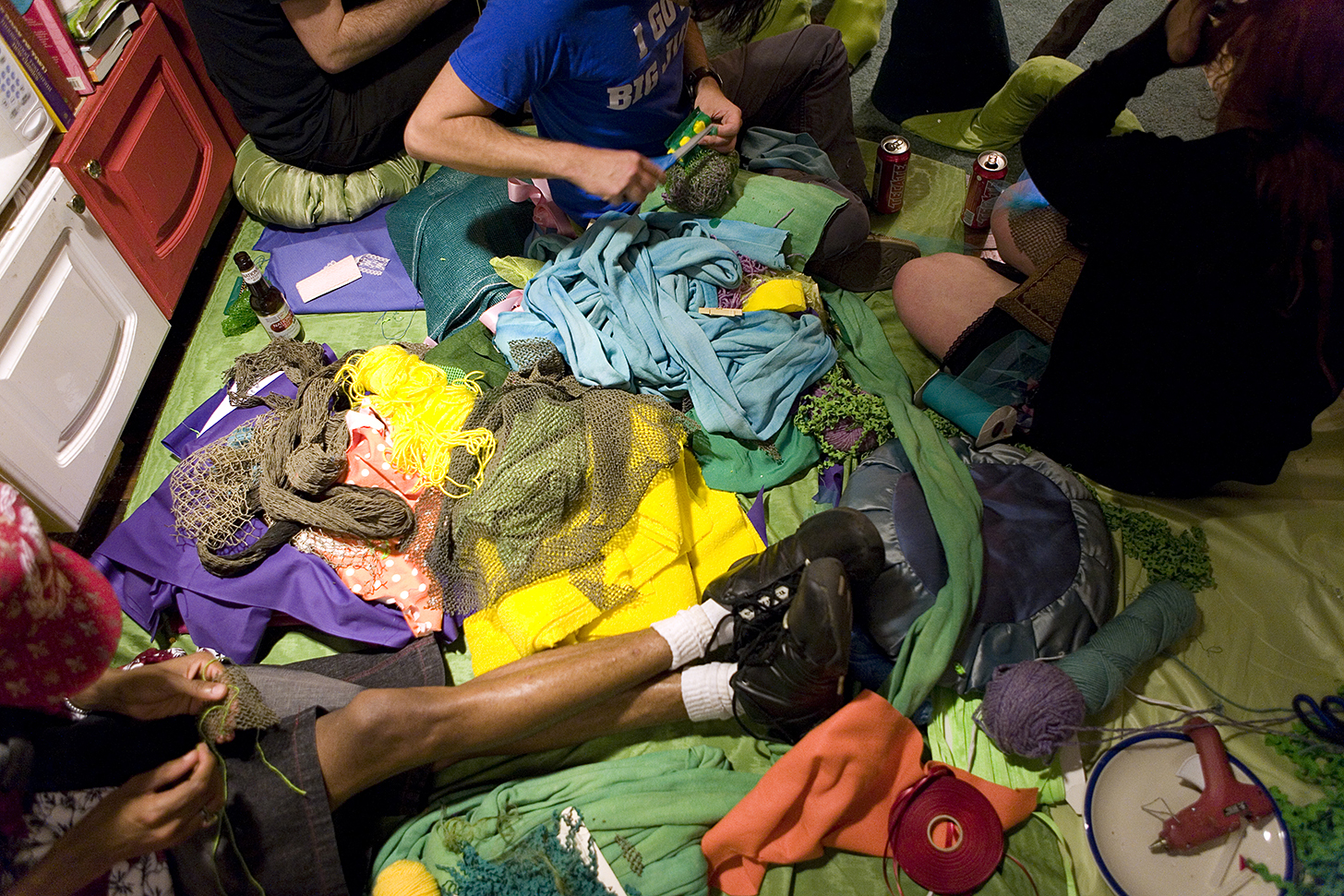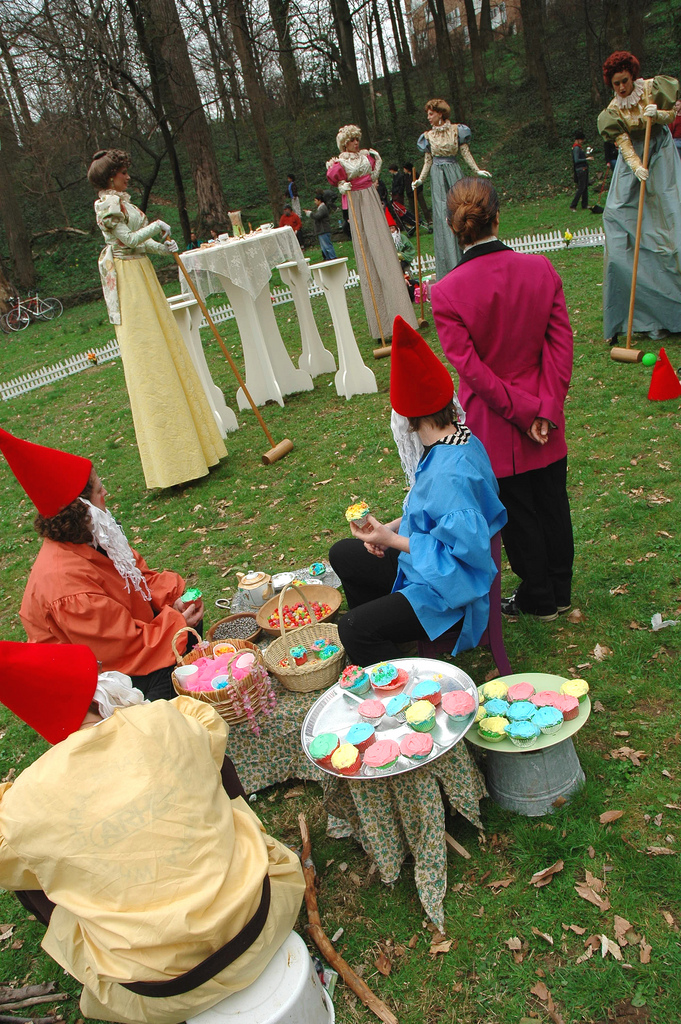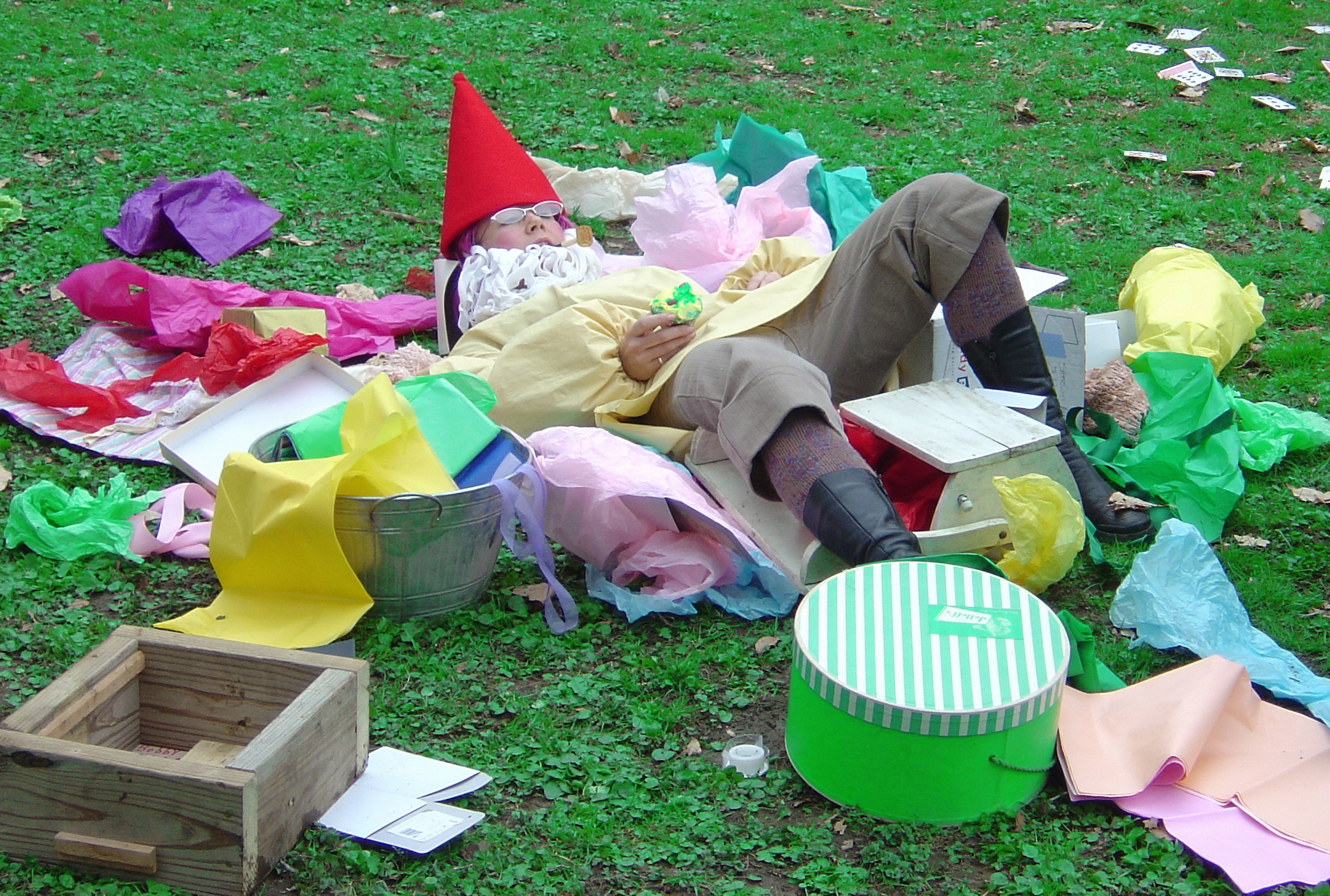Work samples
-
 Proficiencies for Living in RuinsProficiencies for Living in Ruins is a large-scale, site-specific installation by Baltimore-based fiber artist Melissa Webb. This project represents a partnership between the artist, the Institute for Contemporary Art, Baltimore, and Lovely Lane United Methodist Church. Situated inside the dramatic architecture of a currently unused chapel in historic Lovely Lane UMC, this interactive environment explores the human endeavor to operate within a society which has distanced itself from nature in an ever-expanding manner. Utilizing an accumulation of handmade, and manipulated found materials, Webb imagines a future where, in the face of deteriorating environmental and societal stability, humankind and the natural world learn new ways to thrive in symbiosis. Viewers are encouraged to consider their bodies in relation to objects and people within the space — alternately obscuring and revealing, isolating and conspiring.
Proficiencies for Living in RuinsProficiencies for Living in Ruins is a large-scale, site-specific installation by Baltimore-based fiber artist Melissa Webb. This project represents a partnership between the artist, the Institute for Contemporary Art, Baltimore, and Lovely Lane United Methodist Church. Situated inside the dramatic architecture of a currently unused chapel in historic Lovely Lane UMC, this interactive environment explores the human endeavor to operate within a society which has distanced itself from nature in an ever-expanding manner. Utilizing an accumulation of handmade, and manipulated found materials, Webb imagines a future where, in the face of deteriorating environmental and societal stability, humankind and the natural world learn new ways to thrive in symbiosis. Viewers are encouraged to consider their bodies in relation to objects and people within the space — alternately obscuring and revealing, isolating and conspiring. -
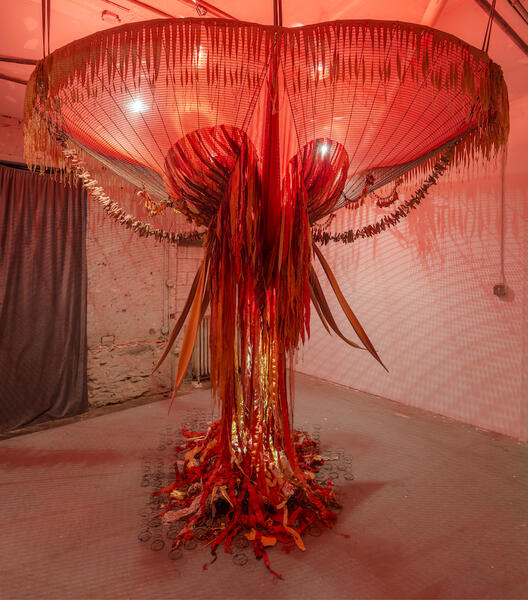 Matters of the Belly and the Brain / A Brutal Action Leading to a Necessary Release / (Feeling in Red)Matters of the Belly and the Brain / A Brutal Action Leading to a Necessary Release / (Feeling in Red) is an immersive installation, originally created for 'sindikit project space in Baltimore in 2017. Mixed Media and found objects. Dimensions variable. 2017.
Matters of the Belly and the Brain / A Brutal Action Leading to a Necessary Release / (Feeling in Red)Matters of the Belly and the Brain / A Brutal Action Leading to a Necessary Release / (Feeling in Red) is an immersive installation, originally created for 'sindikit project space in Baltimore in 2017. Mixed Media and found objects. Dimensions variable. 2017. -
 Front Stoop / Back Yard (Detail of Charles Village Painted Ladies Birdhouse)Front Stoop / Back Yard (Detail of Charles Village Painted Ladies Birdhouse). In 2013, along with Baltimore artists Linda Depalma, Kelley Bell, and School 33 Art Center, Melissa received a Robert Rauschenberg Foundation Artistic Innovation and Collaboration grant. The resulting outdoor, site-specific installation opened in June of 2014. The so-called 'Co-Lab' team's work addressed the building's northern exterior wall and adjoining 1900 square foot vacant lot, which up until that point had suffered from neglect. Linda, Kelley, and Melissa worked together for many months to design and execute this project. They fabricated eight birdhouses, each an ode to a different Baltimore architectural landmark. These were placed upon metal venetian-style poles around the site. The birdhouses include a pair of "Painted Ladies",- colorful townhouses from Baltimore's Charles Village neigborhood- and Penn Station, complete with oversized Man / Woman sculpture, both designed and fabricated by Melissa. The Patterson Park Pagoda, Bromo-Seltzer Tower, and replica of School 33 Art Center were designed and built by Linda DePalma, and three cast formstone-esque brick constructions, designed and built by Kelley Bell. All became potential homes for birds. Two sets of concrete steps, cast to resemble marble, and colorful awning structures above them serve as shade structures and seating area for visitors. Six 3' x 9' painted screen panels, inspired by Baltimore screen-painters, were designed and painted by Jessie Unterhalter and Katie Truhn. The installation is on view indefinitely at the entrance of School 33 Art Center.
Front Stoop / Back Yard (Detail of Charles Village Painted Ladies Birdhouse)Front Stoop / Back Yard (Detail of Charles Village Painted Ladies Birdhouse). In 2013, along with Baltimore artists Linda Depalma, Kelley Bell, and School 33 Art Center, Melissa received a Robert Rauschenberg Foundation Artistic Innovation and Collaboration grant. The resulting outdoor, site-specific installation opened in June of 2014. The so-called 'Co-Lab' team's work addressed the building's northern exterior wall and adjoining 1900 square foot vacant lot, which up until that point had suffered from neglect. Linda, Kelley, and Melissa worked together for many months to design and execute this project. They fabricated eight birdhouses, each an ode to a different Baltimore architectural landmark. These were placed upon metal venetian-style poles around the site. The birdhouses include a pair of "Painted Ladies",- colorful townhouses from Baltimore's Charles Village neigborhood- and Penn Station, complete with oversized Man / Woman sculpture, both designed and fabricated by Melissa. The Patterson Park Pagoda, Bromo-Seltzer Tower, and replica of School 33 Art Center were designed and built by Linda DePalma, and three cast formstone-esque brick constructions, designed and built by Kelley Bell. All became potential homes for birds. Two sets of concrete steps, cast to resemble marble, and colorful awning structures above them serve as shade structures and seating area for visitors. Six 3' x 9' painted screen panels, inspired by Baltimore screen-painters, were designed and painted by Jessie Unterhalter and Katie Truhn. The installation is on view indefinitely at the entrance of School 33 Art Center. -
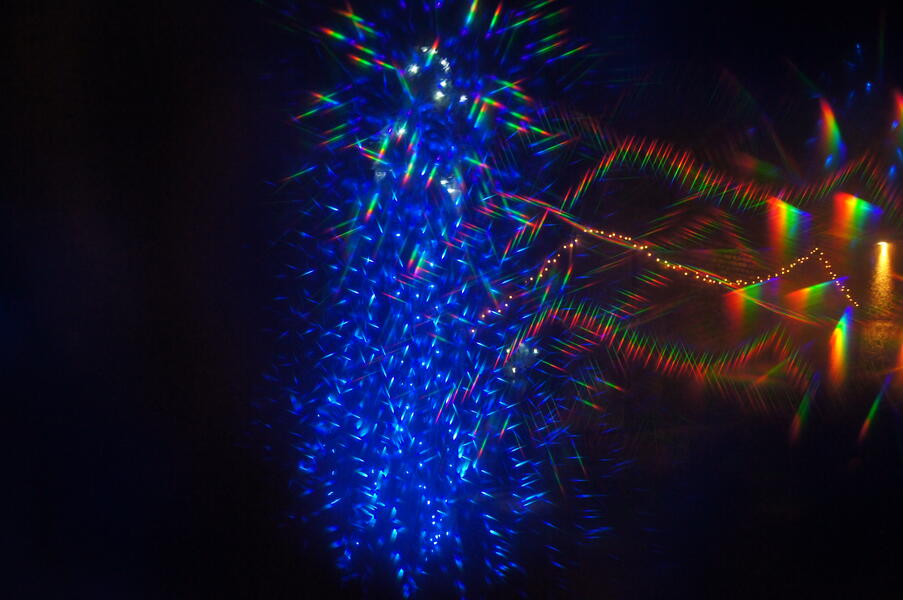 In BetweenIn Between was a participatory performance and site-specific light installation, which took place at the 2012 Transmodern Festival as part of "Alley Oops!" curated by Laure Drogoul. In this piece, 2 characters, played by Autumn Breaud and Melissa Webb, moved about the nighttime alley space, which was transformed by sculptural objects filled with blue light. They interacted with the audience, guiding up to 3 people at a time by the hand to sit upon round pillows, where they were each given light-eminating head pieces, as well as light-refracting glasses with which to watch the performers and take in the surrounding environment. Pictured: A view of refracted light from "In Between", as seen through the special glasses provided.
In BetweenIn Between was a participatory performance and site-specific light installation, which took place at the 2012 Transmodern Festival as part of "Alley Oops!" curated by Laure Drogoul. In this piece, 2 characters, played by Autumn Breaud and Melissa Webb, moved about the nighttime alley space, which was transformed by sculptural objects filled with blue light. They interacted with the audience, guiding up to 3 people at a time by the hand to sit upon round pillows, where they were each given light-eminating head pieces, as well as light-refracting glasses with which to watch the performers and take in the surrounding environment. Pictured: A view of refracted light from "In Between", as seen through the special glasses provided.
About Melissa
Baltimore City
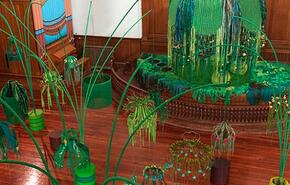
Melissa Webb is a fiber artist working in the areas of site-specific installation, large-scale participatory environments, and performance. She is a three-time Janet and Walter Sondheim Prize semi-finalist and the recipient of a Robert Rauschenberg Artistic Innovation and Collaboration Grant. Her work has been featured at venues such as sindikit projects, Vis-Arts Rockville, School 33 Art Center, The Maryland Institute, College of Art, The Creative Alliance, The Baltimore Museum of Art,… more
Jump to a project:
Proficiencies for Living in Ruins
Situated inside the dramatic architecture of a currently unused chapel in historic Lovely Lane United Methodist Church in Baltimore's Old Goucher neighborhood, this interactive environment explored the human endeavor to operate within a society which has distanced itself from nature in an ever-expanding manner. Utilizing an accumulation of handmade, and manipulated found materials, Webb imagines a future where, in the face of deteriorating environmental and societal stability, humankind and the natural world learn new ways to thrive in symbiosis. Viewers were encouraged to consider their bodies in relation to objects and people within the space — alternately obscuring and revealing, isolating and conspiring.
Advertising and staffing support for Proficiencies for Living in Ruins was provided by the Institute for Contemporary Art, Baltimore, and Lovely Lane UMC.
Proficiencies for Living in Ruins
Large-scale, site-specific sculptural installation
Hot rolled steel, cast concrete, fabric, found objects
2018 - Dimensions variable- Lovely Lane Chapel space 50' diameter x 50' ceiling height.
Advertising and staffing support for Proficiencies for Living in Ruins was provided by the Institute for Contemporary Art, Baltimore, and Lovely Lane UMC.
Proficiencies for Living in Ruins
Large-scale, site-specific sculptural installation
Hot rolled steel, cast concrete, fabric, found objects
2018 - Dimensions variable- Lovely Lane Chapel space 50' diameter x 50' ceiling height.
-
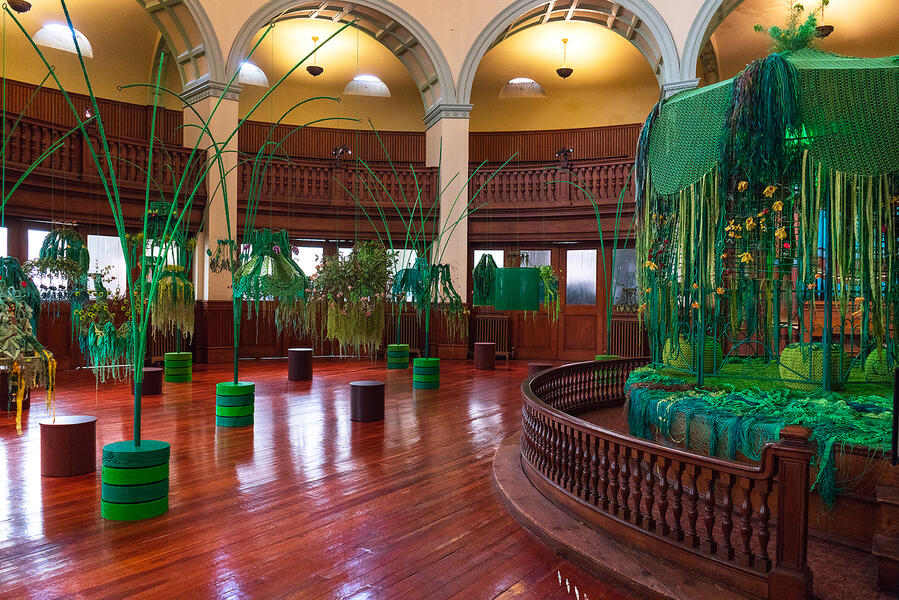 Proficiencies for Living in RuinsOverview of installation. Photography by Liz Donadio
Proficiencies for Living in RuinsOverview of installation. Photography by Liz Donadio -
 Proficiencies for Living in RuinsPhotography by Joe Hyde
Proficiencies for Living in RuinsPhotography by Joe Hyde -
 Proficiencies for Living in RuinsOverview - Photo by Ryan Stevenson
Proficiencies for Living in RuinsOverview - Photo by Ryan Stevenson -
 Proficiencies for Living in Ruins (Detail)Gazebo exterior. Photo by Joe Hyde
Proficiencies for Living in Ruins (Detail)Gazebo exterior. Photo by Joe Hyde -
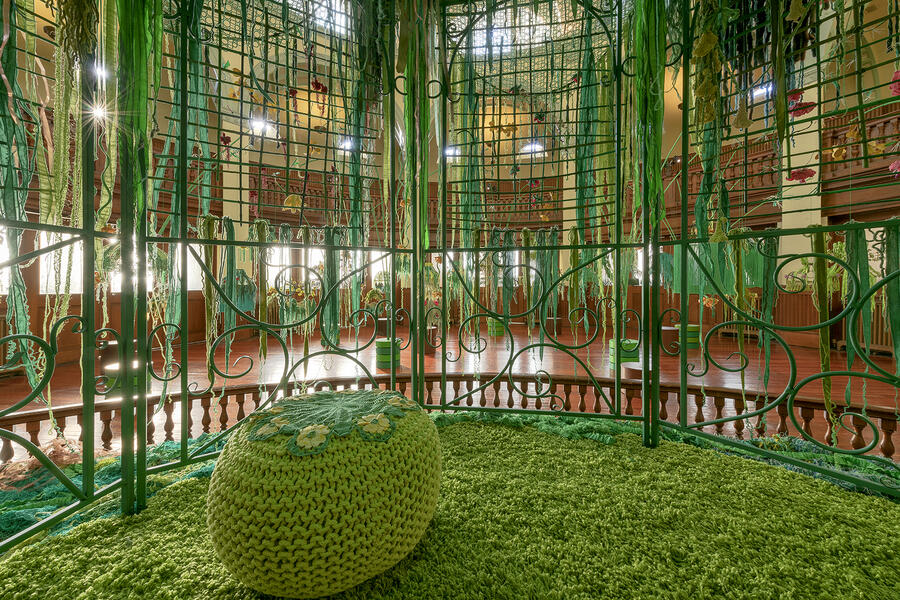 Proficiencies for Living in Ruins (Detail)Gazebo interior. Photo by Joe Hyde
Proficiencies for Living in Ruins (Detail)Gazebo interior. Photo by Joe Hyde -
 Proficiencies for Living in Ruins (Detail)Detail of gazebo exterior. Photo by Liz Donadio
Proficiencies for Living in Ruins (Detail)Detail of gazebo exterior. Photo by Liz Donadio -
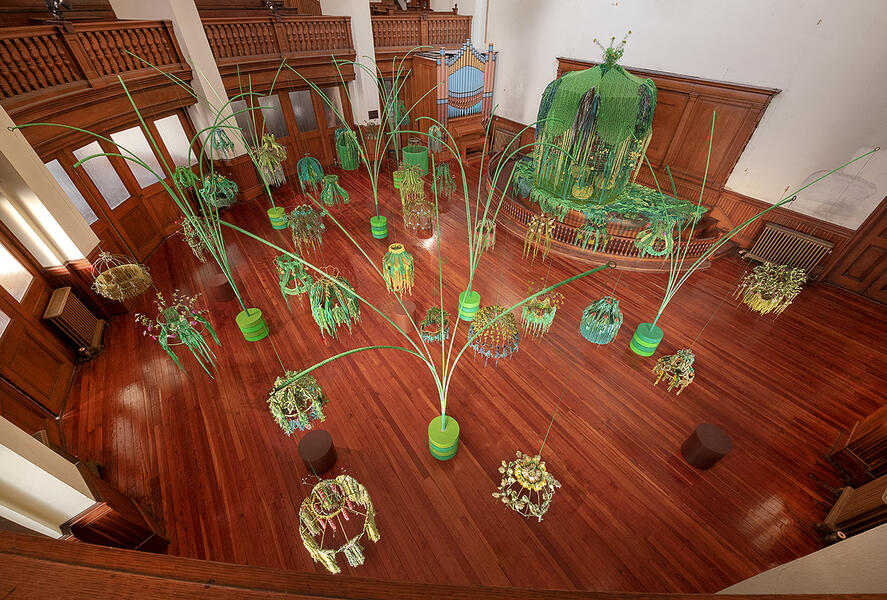 Proficiencies for Living in RuinsOverview from balcony. Photo by Joe Hyde
Proficiencies for Living in RuinsOverview from balcony. Photo by Joe Hyde -
 Proficiencies for Living in RuinsPhotography by Ryan Stevenson
Proficiencies for Living in RuinsPhotography by Ryan Stevenson -
 Proficiencies for Living in Ruins (Detail)Photography by Ryan Stevenson
Proficiencies for Living in Ruins (Detail)Photography by Ryan Stevenson -
 Proficiencies for Living in Ruins (Detail)Photography by Liz Donadio
Proficiencies for Living in Ruins (Detail)Photography by Liz Donadio
Proficiencies for Living in Ruins: Performative Reactions
During the two months that Proficiencies for Living in Ruins was on view at Lovely Lane United Methodist Church in Baltimore, several artists working in the areas of sound, music, and performance art reacted to the installation through the presentation of new, site responsive works. A series of evening and weekend events featured Baltimore-based artists Carrie Fucile, Stephanie Barber, and Tom Boram.
Melissa engaged each of these artists with a prior knowlege of their past works / working styles, and tasked them with creating a new work in response to the installation. Their reactions, performed within the installation, were as follows:
1. Proficiencies for Living in Ruins: Reconcilliation: A sound-based performance by Carrie Fucile.
Fucile's 20 minute performance resembled a lonely ceremony or meditation. The sound element featured the sounds of songbirds, and 5 performers rung church bells from the balcony at multiple points. This artist has a unique style which combines sound creation, body movement, and object manipulation, creating a measured, contemplative result.
Reconciliation is a performance of longing, grief, reckoning, and hope. This ritual looks to the past and prays for the future. It grapples with both personal and collective history while gently attempting to exorcise.
__________ 2. Proficiencies for Living in Ruins: Contemplative Opera: Written and organized by Stephanie Barber.
During this one hour, continuous performance, 30 performers, dressed in green, were asked to sing a series of phrases. They gathered in groups with others who were tasked with the same phrase, allowing the resulting melodies to change over time.
A chorus of contemplators will fill the chapel with song, improvising harmonies and counterpoint to melodic lines about the bontanicality of art, humans, and our changing planet.
- The sun goes down on every perspective. The sun indulges our trust in sight.
- What's tentacular when one direction holds the promise of success?
- Green green green, grass leaves and hope...
- Earth holds verticality to expectations, mocking the horizon's perspective.
- How much further from our fingers?
____________
3. Proficiencies for Living in Ruins: Green Frequencies: A pipe organ and light-based performance by Tom Boram.
Boram, an experimental musician and visual artist, utilized the pipe organ in Lovely Lane Chapel, which has been in the church since the building's completion in 1884. He pre-recorded himself playing the organ, then manipulating the resulting sound. He programmed super-bright LEDs using an arduino. These hung inside several of the hanging forms, dimming and flashing in response to the pre-recorded music as he simultaneously played the organ live. The LEDs projected a large shadow through the forms and onto the dome above as he played.
A performance of pipe organ, computer, light, and shadow, Green Frequencies intends to consider the sensual qualities of green as radiant energy - resonating around 550 terahertz. The year 1983 saw the release of both the Misfits' "Earth AD", and the sountrack to the environmentalist art film Koyaanisqatsi, composed by Phillip Glass. The most important tracks from each off these albums are, respectively, "Green Hell", and the main theme, "Koyaanisqatsi". These share a common theme of humans living on an Earth they've poisoned. However, they both suggest a new growth pattern arising from a perspective that this contrived hell on Earth is still defiantly green. A lyric from "Green Hell" asserts that within this greenness we can seek the "Genie of Death" - aka nature - finding each other anew in the pall of technology. _____________ Proficiencies for Living in Ruins is large-scale, site-specific installation by Baltimore-based fiber artist Melissa Webb, Proficiencies for Living in Ruins represents a partnership between the artist, the Institute for Contemporary Art, Baltimore, and Lovely Lane United Methodist Church. Situated inside the dramatic architecture of a currently unused chapel in historic Lovely Lane UMC, this interactive environment explores the human endeavor to operate within a society which has distanced itself from nature in an ever-expanding manner. Utilizing an accumulation of handmade, and manipulated found materials, Webb imagines a future where, in the face of deteriorating environmental and societal stability, humankind and the natural world learn new ways to thrive in symbiosis. Viewers are encouraged to consider their bodies in relation to objects and people within the space — alternately obscuring and revealing, isolating and conspiring.
-
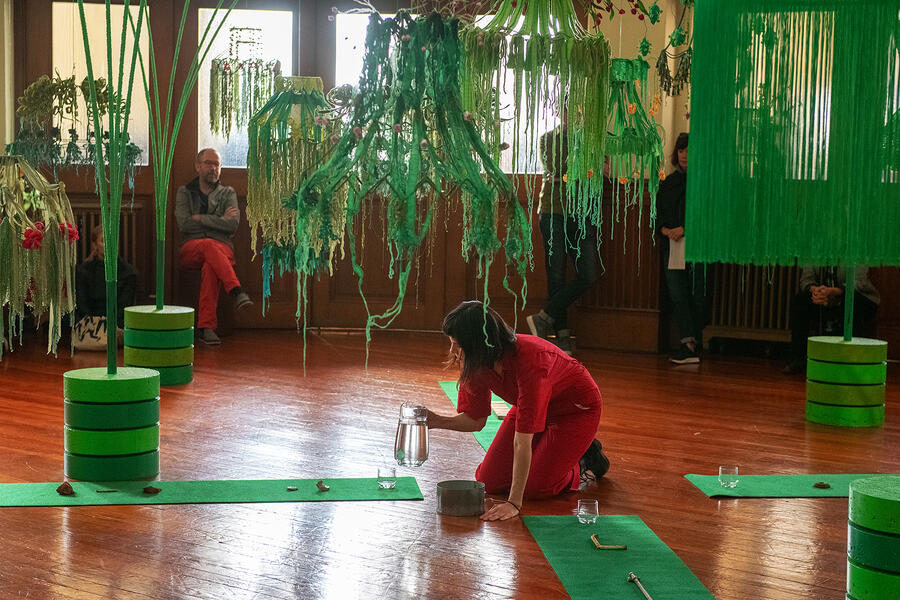 Proficiencies for Living in Ruins: ReconcilliationA Sound-Based Performance by Carrie Fucile . "Reconciliation is a performance of longing, grief, reckoning, and hope. This ritual looks to the past and prays for the future. It grapples with both personal and collective history while gently attempting to exorcise." Carrie Fucile is an interdisciplinary artist focused on sound, installation, and performance. Her work explores bodily memory, territorial boundaries, and global capital. Everyday objects are her primary tools. She has exhibited and performed at numerous venues in the United States and abroad including The Walters Art Museum/Baltimore, High Zero Festival/Baltimore, the (e)merge Art Fair/Washington, DC, IA&A at Hillyer/Washington, DC, Vox Populi/Philadelphia, Casa Contemporânea/ São Paulo, Brazil, VMK – Gönczi Gallery/ Zalaegerszeg, Hungary, and the Director’s Lounge/Berlin, Germany. She lives and works in Baltimore, Maryland. Photography by Theresa Keil.
Proficiencies for Living in Ruins: ReconcilliationA Sound-Based Performance by Carrie Fucile . "Reconciliation is a performance of longing, grief, reckoning, and hope. This ritual looks to the past and prays for the future. It grapples with both personal and collective history while gently attempting to exorcise." Carrie Fucile is an interdisciplinary artist focused on sound, installation, and performance. Her work explores bodily memory, territorial boundaries, and global capital. Everyday objects are her primary tools. She has exhibited and performed at numerous venues in the United States and abroad including The Walters Art Museum/Baltimore, High Zero Festival/Baltimore, the (e)merge Art Fair/Washington, DC, IA&A at Hillyer/Washington, DC, Vox Populi/Philadelphia, Casa Contemporânea/ São Paulo, Brazil, VMK – Gönczi Gallery/ Zalaegerszeg, Hungary, and the Director’s Lounge/Berlin, Germany. She lives and works in Baltimore, Maryland. Photography by Theresa Keil. -
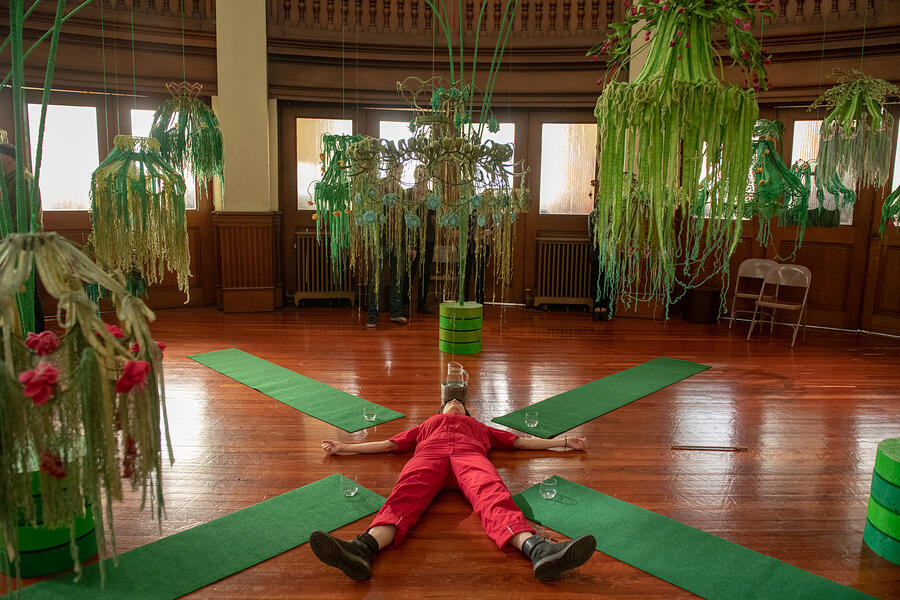 Proficiencies for Living in Ruins: ReconciliationA Sound-Based Performance by Carrie Fucile . "Reconciliation is a performance of longing, grief, reckoning, and hope. This ritual looks to the past and prays for the future. It grapples with both personal and collective history while gently attempting to exorcise." Carrie Fucile is an interdisciplinary artist focused on sound, installation, and performance. Her work explores bodily memory, territorial boundaries, and global capital. Everyday objects are her primary tools. She has exhibited and performed at numerous venues in the United States and abroad including The Walters Art Museum/Baltimore, High Zero Festival/Baltimore, the (e)merge Art Fair/Washington, DC, IA&A at Hillyer/Washington, DC, Vox Populi/Philadelphia, Casa Contemporânea/ São Paulo, Brazil, VMK – Gönczi Gallery/ Zalaegerszeg, Hungary, and the Director’s Lounge/Berlin, Germany. She lives and works in Baltimore, Maryland. Photography by Theresa Keil.
Proficiencies for Living in Ruins: ReconciliationA Sound-Based Performance by Carrie Fucile . "Reconciliation is a performance of longing, grief, reckoning, and hope. This ritual looks to the past and prays for the future. It grapples with both personal and collective history while gently attempting to exorcise." Carrie Fucile is an interdisciplinary artist focused on sound, installation, and performance. Her work explores bodily memory, territorial boundaries, and global capital. Everyday objects are her primary tools. She has exhibited and performed at numerous venues in the United States and abroad including The Walters Art Museum/Baltimore, High Zero Festival/Baltimore, the (e)merge Art Fair/Washington, DC, IA&A at Hillyer/Washington, DC, Vox Populi/Philadelphia, Casa Contemporânea/ São Paulo, Brazil, VMK – Gönczi Gallery/ Zalaegerszeg, Hungary, and the Director’s Lounge/Berlin, Germany. She lives and works in Baltimore, Maryland. Photography by Theresa Keil. -
 Proficiencies for Living in Ruins: ReconciliationA Sound-Based Performance by Carrie Fucile . "Reconciliation is a performance of longing, grief, reckoning, and hope. This ritual looks to the past and prays for the future. It grapples with both personal and collective history while gently attempting to exorcise." Carrie Fucile is an interdisciplinary artist focused on sound, installation, and performance. Her work explores bodily memory, territorial boundaries, and global capital. Everyday objects are her primary tools. She has exhibited and performed at numerous venues in the United States and abroad including The Walters Art Museum/Baltimore, High Zero Festival/Baltimore, the (e)merge Art Fair/Washington, DC, IA&A at Hillyer/Washington, DC, Vox Populi/Philadelphia, Casa Contemporânea/ São Paulo, Brazil, VMK – Gönczi Gallery/ Zalaegerszeg, Hungary, and the Director’s Lounge/Berlin, Germany. She lives and works in Baltimore, Maryland. Photography by Theresa Keil.
Proficiencies for Living in Ruins: ReconciliationA Sound-Based Performance by Carrie Fucile . "Reconciliation is a performance of longing, grief, reckoning, and hope. This ritual looks to the past and prays for the future. It grapples with both personal and collective history while gently attempting to exorcise." Carrie Fucile is an interdisciplinary artist focused on sound, installation, and performance. Her work explores bodily memory, territorial boundaries, and global capital. Everyday objects are her primary tools. She has exhibited and performed at numerous venues in the United States and abroad including The Walters Art Museum/Baltimore, High Zero Festival/Baltimore, the (e)merge Art Fair/Washington, DC, IA&A at Hillyer/Washington, DC, Vox Populi/Philadelphia, Casa Contemporânea/ São Paulo, Brazil, VMK – Gönczi Gallery/ Zalaegerszeg, Hungary, and the Director’s Lounge/Berlin, Germany. She lives and works in Baltimore, Maryland. Photography by Theresa Keil. -
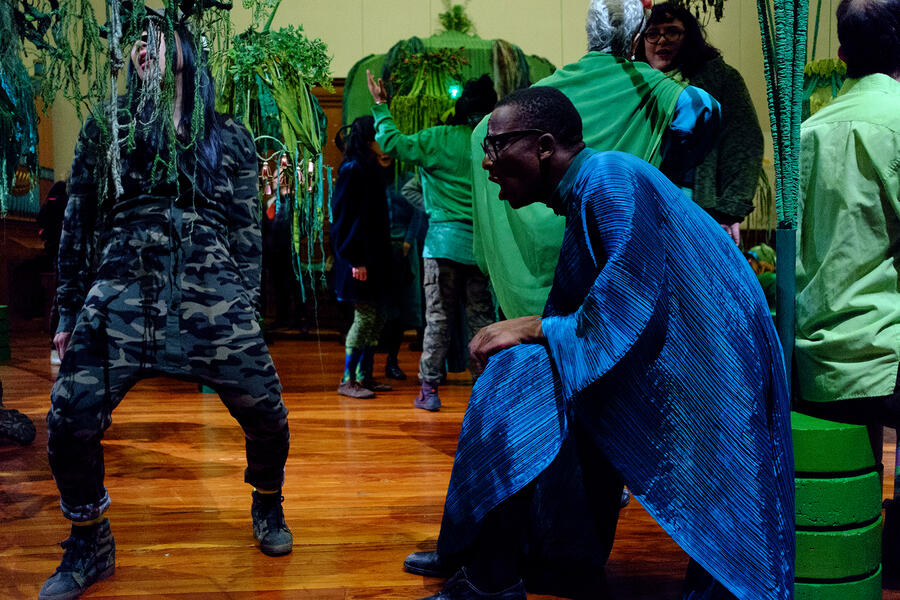 Proficiencies for Living in Ruins: Contemplative Operaroficiencies for Living in Ruins: "Contemplative Opera" Written and organized by Stephanie Barber A chorus of contemplators will fill the chapel with song, improvising harmonies and counterpoint to melodic lines about the botanicality of art, humans and our changing planet. Stephanie Barber is an American writer and artist. She has created a poetic, conceptual and philosophical body of work in a variety of media. Her videos are concerned with the content, musicality and experiential qualities of language and her language is concerned with the emotional impact of moments and ideas. Each ferry viewers through philosophical inquiry with the unexpected oars of empathy, play, story and humor. The 'Chorus of Contemplators' - Lauren Bender / Erick Antonio Benitez / Catherine Borg / Theresa Columbus / Sarada Conaway / Suzanne Doogan / Liz Downing / John Eaton / Eric Franklin / Linda Franklin / Olivia Fite / Phaan Howng / Sarah Jacklin / Tami Jacobs / Megan Livingston / Doyun Lee / Jorge Martins / Megan McShea / David Mitchell / Alicia Puglionesi / Erin Stellmon / Kristen Toedtman / Bob Wagner / Karen Yasinsky / Dan Zink +++ Photography by Eboni Sellers
Proficiencies for Living in Ruins: Contemplative Operaroficiencies for Living in Ruins: "Contemplative Opera" Written and organized by Stephanie Barber A chorus of contemplators will fill the chapel with song, improvising harmonies and counterpoint to melodic lines about the botanicality of art, humans and our changing planet. Stephanie Barber is an American writer and artist. She has created a poetic, conceptual and philosophical body of work in a variety of media. Her videos are concerned with the content, musicality and experiential qualities of language and her language is concerned with the emotional impact of moments and ideas. Each ferry viewers through philosophical inquiry with the unexpected oars of empathy, play, story and humor. The 'Chorus of Contemplators' - Lauren Bender / Erick Antonio Benitez / Catherine Borg / Theresa Columbus / Sarada Conaway / Suzanne Doogan / Liz Downing / John Eaton / Eric Franklin / Linda Franklin / Olivia Fite / Phaan Howng / Sarah Jacklin / Tami Jacobs / Megan Livingston / Doyun Lee / Jorge Martins / Megan McShea / David Mitchell / Alicia Puglionesi / Erin Stellmon / Kristen Toedtman / Bob Wagner / Karen Yasinsky / Dan Zink +++ Photography by Eboni Sellers -
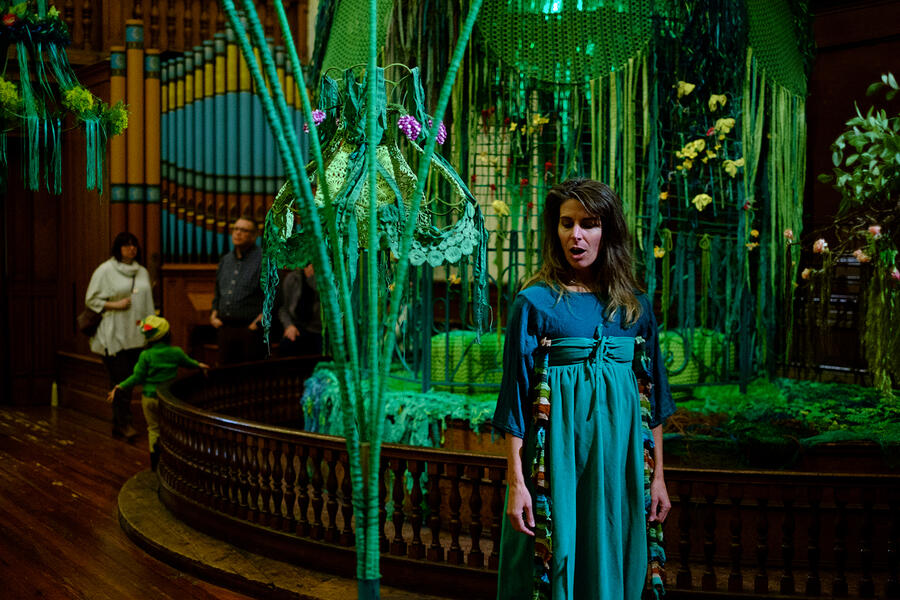 Proficiencies for Living in Ruins: Contemplative OperaWritten and organized by Stephanie Barber A chorus of contemplators will fill the chapel with song, improvising harmonies and counterpoint to melodic lines about the botanicality of art, humans and our changing planet. Stephanie Barber is an American writer and artist. She has created a poetic, conceptual and philosophical body of work in a variety of media. Her videos are concerned with the content, musicality and experiential qualities of language and her language is concerned with the emotional impact of moments and ideas. Each ferry viewers through philosophical inquiry with the unexpected oars of empathy, play, story and humor. The 'Chorus of Contemplators' - Lauren Bender / Erick Antonio Benitez / Catherine Borg / Theresa Columbus / Sarada Conaway / Suzanne Doogan / Liz Downing / John Eaton / Eric Franklin / Linda Franklin / Olivia Fite / Phaan Howng / Sarah Jacklin / Tami Jacobs / Megan Livingston / Doyun Lee / Jorge Martins / Megan McShea / David Mitchell / Alicia Puglionesi / Erin Stellmon / Kristen Toedtman / Bob Wagner / Karen Yasinsky / Dan Zink +++ Photography by Ryan Stevenson
Proficiencies for Living in Ruins: Contemplative OperaWritten and organized by Stephanie Barber A chorus of contemplators will fill the chapel with song, improvising harmonies and counterpoint to melodic lines about the botanicality of art, humans and our changing planet. Stephanie Barber is an American writer and artist. She has created a poetic, conceptual and philosophical body of work in a variety of media. Her videos are concerned with the content, musicality and experiential qualities of language and her language is concerned with the emotional impact of moments and ideas. Each ferry viewers through philosophical inquiry with the unexpected oars of empathy, play, story and humor. The 'Chorus of Contemplators' - Lauren Bender / Erick Antonio Benitez / Catherine Borg / Theresa Columbus / Sarada Conaway / Suzanne Doogan / Liz Downing / John Eaton / Eric Franklin / Linda Franklin / Olivia Fite / Phaan Howng / Sarah Jacklin / Tami Jacobs / Megan Livingston / Doyun Lee / Jorge Martins / Megan McShea / David Mitchell / Alicia Puglionesi / Erin Stellmon / Kristen Toedtman / Bob Wagner / Karen Yasinsky / Dan Zink +++ Photography by Ryan Stevenson -
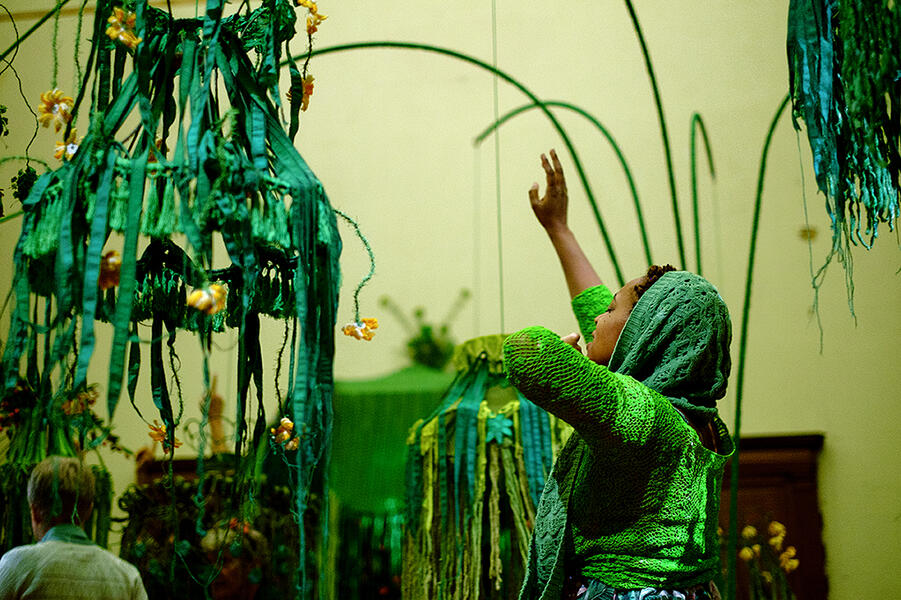 Proficiencies for Living in Ruins: Contemplative OperaWritten and organized by Stephanie Barber. A chorus of contemplators will fill the chapel with song, improvising harmonies and counterpoint to melodic lines about the botanicality of art, humans and our changing planet. Stephanie Barber is an American writer and artist. She has created a poetic, conceptual and philosophical body of work in a variety of media. Her videos are concerned with the content, musicality and experiential qualities of language and her language is concerned with the emotional impact of moments and ideas. Each ferry viewers through philosophical inquiry with the unexpected oars of empathy, play, story and humor. The 'Chorus of Contemplators' - Lauren Bender / Erick Antonio Benitez / Catherine Borg / Theresa Columbus / Sarada Conaway / Suzanne Doogan / Liz Downing / John Eaton / Eric Franklin / Linda Franklin / Olivia Fite / Phaan Howng / Sarah Jacklin / Tami Jacobs / Megan Livingston / Doyun Lee / Jorge Martins / Megan McShea / David Mitchell / Alicia Puglionesi / Erin Stellmon / Kristen Toedtman / Bob Wagner / Karen Yasinsky / Dan Zink +++ Photography by Eboni Sellers
Proficiencies for Living in Ruins: Contemplative OperaWritten and organized by Stephanie Barber. A chorus of contemplators will fill the chapel with song, improvising harmonies and counterpoint to melodic lines about the botanicality of art, humans and our changing planet. Stephanie Barber is an American writer and artist. She has created a poetic, conceptual and philosophical body of work in a variety of media. Her videos are concerned with the content, musicality and experiential qualities of language and her language is concerned with the emotional impact of moments and ideas. Each ferry viewers through philosophical inquiry with the unexpected oars of empathy, play, story and humor. The 'Chorus of Contemplators' - Lauren Bender / Erick Antonio Benitez / Catherine Borg / Theresa Columbus / Sarada Conaway / Suzanne Doogan / Liz Downing / John Eaton / Eric Franklin / Linda Franklin / Olivia Fite / Phaan Howng / Sarah Jacklin / Tami Jacobs / Megan Livingston / Doyun Lee / Jorge Martins / Megan McShea / David Mitchell / Alicia Puglionesi / Erin Stellmon / Kristen Toedtman / Bob Wagner / Karen Yasinsky / Dan Zink +++ Photography by Eboni Sellers -
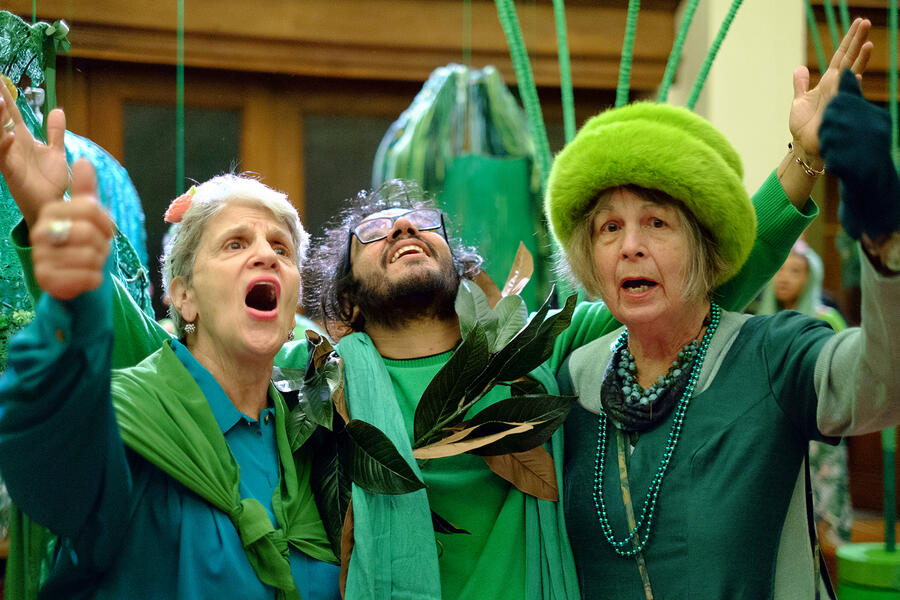 Proficiencies for Living in Ruins: Contemplative Operaroficiencies for Living in Ruins: "Contemplative Opera" Written and organized by Stephanie Barber A chorus of contemplators will fill the chapel with song, improvising harmonies and counterpoint to melodic lines about the botanicality of art, humans and our changing planet. Stephanie Barber is an American writer and artist. She has created a poetic, conceptual and philosophical body of work in a variety of media. Her videos are concerned with the content, musicality and experiential qualities of language and her language is concerned with the emotional impact of moments and ideas. Each ferry viewers through philosophical inquiry with the unexpected oars of empathy, play, story and humor. The 'Chorus of Contemplators' - Lauren Bender / Erick Antonio Benitez / Catherine Borg / Theresa Columbus / Sarada Conaway / Suzanne Doogan / Liz Downing / John Eaton / Eric Franklin / Linda Franklin / Olivia Fite / Phaan Howng / Sarah Jacklin / Tami Jacobs / Megan Livingston / Doyun Lee / Jorge Martins / Megan McShea / David Mitchell / Alicia Puglionesi / Erin Stellmon / Kristen Toedtman / Bob Wagner / Karen Yasinsky / Dan Zink +++ Photography by Eboni Sellers
Proficiencies for Living in Ruins: Contemplative Operaroficiencies for Living in Ruins: "Contemplative Opera" Written and organized by Stephanie Barber A chorus of contemplators will fill the chapel with song, improvising harmonies and counterpoint to melodic lines about the botanicality of art, humans and our changing planet. Stephanie Barber is an American writer and artist. She has created a poetic, conceptual and philosophical body of work in a variety of media. Her videos are concerned with the content, musicality and experiential qualities of language and her language is concerned with the emotional impact of moments and ideas. Each ferry viewers through philosophical inquiry with the unexpected oars of empathy, play, story and humor. The 'Chorus of Contemplators' - Lauren Bender / Erick Antonio Benitez / Catherine Borg / Theresa Columbus / Sarada Conaway / Suzanne Doogan / Liz Downing / John Eaton / Eric Franklin / Linda Franklin / Olivia Fite / Phaan Howng / Sarah Jacklin / Tami Jacobs / Megan Livingston / Doyun Lee / Jorge Martins / Megan McShea / David Mitchell / Alicia Puglionesi / Erin Stellmon / Kristen Toedtman / Bob Wagner / Karen Yasinsky / Dan Zink +++ Photography by Eboni Sellers -
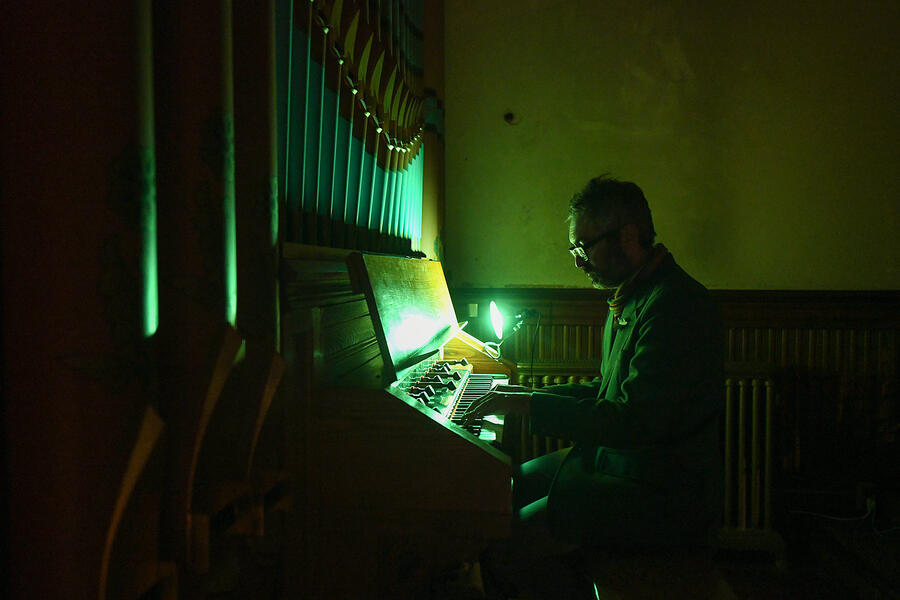 Proficiencies for Living in Ruins: Green FrequenciesA pipe organ and light-based performance by Tom Boram. ""Proficiencies for Living in Ruins: Green Frequencies" is a performance of pipe organ and computer, light and shadow, intended to consider the sensual qualities of green as radiant energy - resonating around 550 terahertz. The year 1983 saw the release of both the Misfits' Earth AD and the soundtrack to the environmentalist art film Koyaanisqatsi, composed by Philip Glass. The most important tracks from each of these albums are, respectively, "Green Hell" and the main theme, "Koyaanisqatsi." These two tracks share a common theme of humans living on an Earth they've poisoned. However, they both suggest a new growth pattern arising from a perspective that this contrived hell on Earth is still defiantly green. A lyric from "Green Hell" asserts that within this greenness we can seek the "Genie of Death" - aka nature - finding each other anew in the pall of technology." Photography by Theresa Keil
Proficiencies for Living in Ruins: Green FrequenciesA pipe organ and light-based performance by Tom Boram. ""Proficiencies for Living in Ruins: Green Frequencies" is a performance of pipe organ and computer, light and shadow, intended to consider the sensual qualities of green as radiant energy - resonating around 550 terahertz. The year 1983 saw the release of both the Misfits' Earth AD and the soundtrack to the environmentalist art film Koyaanisqatsi, composed by Philip Glass. The most important tracks from each of these albums are, respectively, "Green Hell" and the main theme, "Koyaanisqatsi." These two tracks share a common theme of humans living on an Earth they've poisoned. However, they both suggest a new growth pattern arising from a perspective that this contrived hell on Earth is still defiantly green. A lyric from "Green Hell" asserts that within this greenness we can seek the "Genie of Death" - aka nature - finding each other anew in the pall of technology." Photography by Theresa Keil -
 Proficiencies for Living in Ruins: Green FrequenciesA pipe organ and light-based performance by Tom Boram. ""Proficiencies for Living in Ruins: Green Frequencies" is a performance of pipe organ and computer, light and shadow, intended to consider the sensual qualities of green as radiant energy - resonating around 550 terahertz. The year 1983 saw the release of both the Misfits' Earth AD and the soundtrack to the environmentalist art film Koyaanisqatsi, composed by Philip Glass. The most important tracks from each of these albums are, respectively, "Green Hell" and the main theme, "Koyaanisqatsi." These two tracks share a common theme of humans living on an Earth they've poisoned. However, they both suggest a new growth pattern arising from a perspective that this contrived hell on Earth is still defiantly green. A lyric from "Green Hell" asserts that within this greenness we can seek the "Genie of Death" - aka nature - finding each other anew in the pall of technology." Photography by Theresa Keil
Proficiencies for Living in Ruins: Green FrequenciesA pipe organ and light-based performance by Tom Boram. ""Proficiencies for Living in Ruins: Green Frequencies" is a performance of pipe organ and computer, light and shadow, intended to consider the sensual qualities of green as radiant energy - resonating around 550 terahertz. The year 1983 saw the release of both the Misfits' Earth AD and the soundtrack to the environmentalist art film Koyaanisqatsi, composed by Philip Glass. The most important tracks from each of these albums are, respectively, "Green Hell" and the main theme, "Koyaanisqatsi." These two tracks share a common theme of humans living on an Earth they've poisoned. However, they both suggest a new growth pattern arising from a perspective that this contrived hell on Earth is still defiantly green. A lyric from "Green Hell" asserts that within this greenness we can seek the "Genie of Death" - aka nature - finding each other anew in the pall of technology." Photography by Theresa Keil -
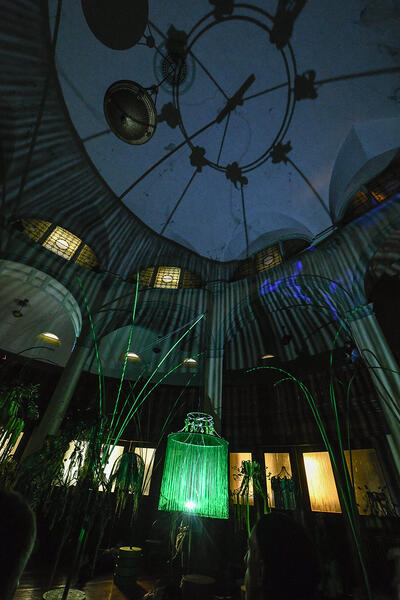 Proficiencies for Living in Ruins: Green FrequenciesProficiencies for Living in Ruins: Green Frequencies" is a performance of pipe organ and computer, light and shadow, intended to consider the sensual qualities of green as radiant energy - resonating around 550 terahertz. The year 1983 saw the release of both the Misfits' Earth AD and the soundtrack to the environmentalist art film Koyaanisqatsi, composed by Philip Glass. The most important tracks from each of these albums are, respectively, "Green Hell" and the main theme, "Koyaanisqatsi." These two tracks share a common theme of humans living on an Earth they've poisoned. However, they both suggest a new growth pattern arising from a perspective that this contrived hell on Earth is still defiantly green. A lyric from "Green Hell" asserts that within this greenness we can seek the "Genie of Death" - aka nature - finding each other anew in the pall of technology. Photography by Theresa Keil
Proficiencies for Living in Ruins: Green FrequenciesProficiencies for Living in Ruins: Green Frequencies" is a performance of pipe organ and computer, light and shadow, intended to consider the sensual qualities of green as radiant energy - resonating around 550 terahertz. The year 1983 saw the release of both the Misfits' Earth AD and the soundtrack to the environmentalist art film Koyaanisqatsi, composed by Philip Glass. The most important tracks from each of these albums are, respectively, "Green Hell" and the main theme, "Koyaanisqatsi." These two tracks share a common theme of humans living on an Earth they've poisoned. However, they both suggest a new growth pattern arising from a perspective that this contrived hell on Earth is still defiantly green. A lyric from "Green Hell" asserts that within this greenness we can seek the "Genie of Death" - aka nature - finding each other anew in the pall of technology. Photography by Theresa Keil
Matters of the Belly and the Brain / A Brutal Action Leading to a Necessary Release / (Feeling in Red)
Matters of the Belly and the Brain / A Brutal Action Leading to a Necessary Release/ (Feeling in Red) is an immersive installation, created for 'sindikit project space in Baltimore.
Mixed media & found objects. Dimensions variable. 2017.
Photography by Joe Hyde
Mixed media & found objects. Dimensions variable. 2017.
Photography by Joe Hyde
-
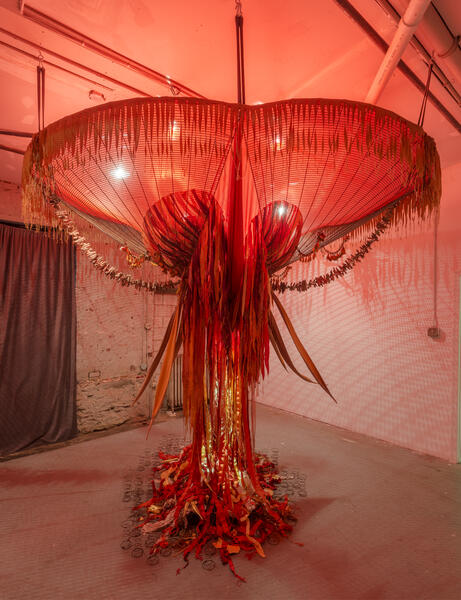 Matters of the Belly and the Brain / A Brutal Action Leading to a Necessary Release / (Feeling in Red)Matters of the Belly and the Brain / A Brutal Action Leading to a Necessary Release/ (Feeling in Red) is an immersive installation, created for 'sindikit project space in Baltimore. Mixed media & found objects. Dimensions variable. 2017. Photography by Joe Hyde
Matters of the Belly and the Brain / A Brutal Action Leading to a Necessary Release / (Feeling in Red)Matters of the Belly and the Brain / A Brutal Action Leading to a Necessary Release/ (Feeling in Red) is an immersive installation, created for 'sindikit project space in Baltimore. Mixed media & found objects. Dimensions variable. 2017. Photography by Joe Hyde -
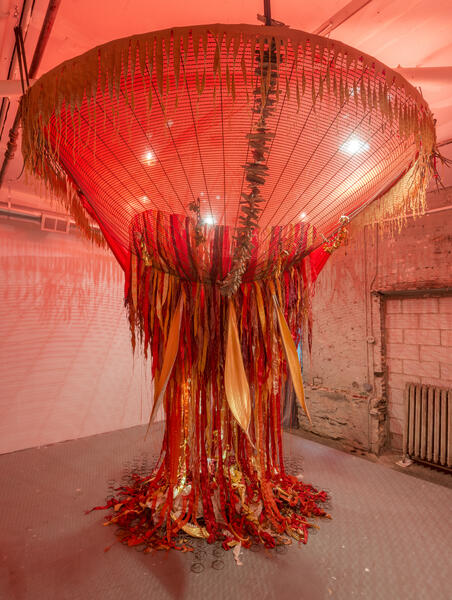 Matters of the Belly and the Brain / A Brutal Action Leading to a Necessary Release / Feeling In Red OverviewAn immersive installation, originally created for 'sindikit project space in Baltimore in 2017. Mixed Media and found objects. Dimensions variable. 2017.
Matters of the Belly and the Brain / A Brutal Action Leading to a Necessary Release / Feeling In Red OverviewAn immersive installation, originally created for 'sindikit project space in Baltimore in 2017. Mixed Media and found objects. Dimensions variable. 2017. -
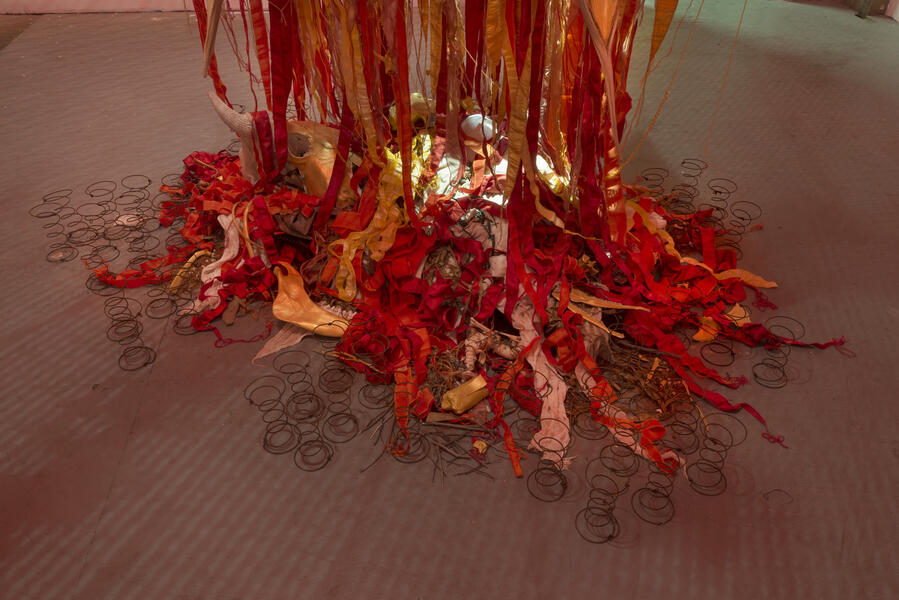 Matters of the Belly and the Brain / A Brutal Action Leading to a Necessary Release / (Feeling in Red) (Detail)Matters of the Belly and the Brain / A Brutal Action Leading to a Necessary Release/ (Feeling in Red) is an immersive installation, created for 'sindikit project space in Baltimore. Mixed media & found objects. Dimensions variable. 2017. Photography by Joe Hyde
Matters of the Belly and the Brain / A Brutal Action Leading to a Necessary Release / (Feeling in Red) (Detail)Matters of the Belly and the Brain / A Brutal Action Leading to a Necessary Release/ (Feeling in Red) is an immersive installation, created for 'sindikit project space in Baltimore. Mixed media & found objects. Dimensions variable. 2017. Photography by Joe Hyde -
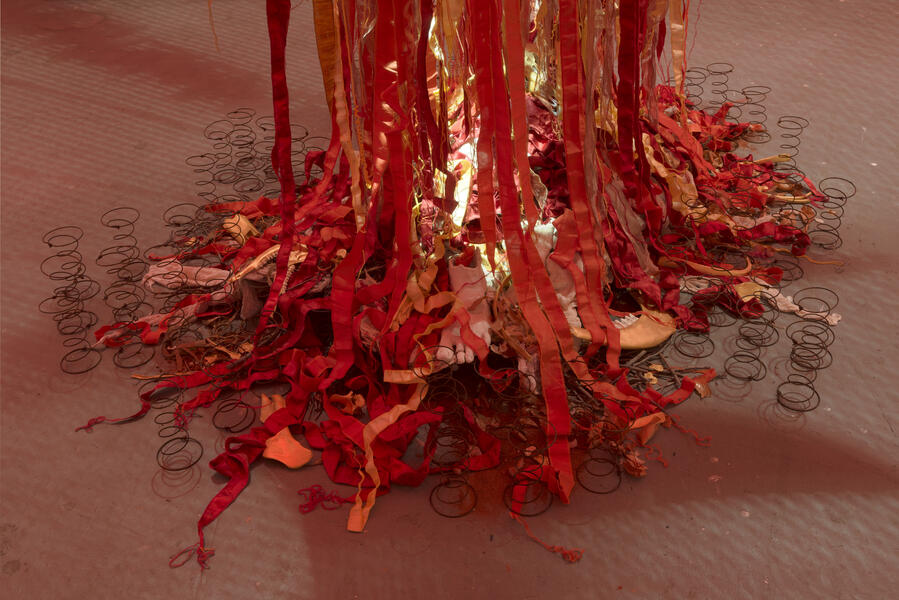 Matters of the Belly and the Brain / A Brutal Action Leading to a Necessary Release / (Feeling in Red) (Detail)Matters of the Belly and the Brain / A Brutal Action Leading to a Necessary Release / (Feeling in Red) is an immersive installation created for 'sindikit project space in Baltimore. Mixed Media and found objects. Size variable. 2017. Photography by Joe Hyde.
Matters of the Belly and the Brain / A Brutal Action Leading to a Necessary Release / (Feeling in Red) (Detail)Matters of the Belly and the Brain / A Brutal Action Leading to a Necessary Release / (Feeling in Red) is an immersive installation created for 'sindikit project space in Baltimore. Mixed Media and found objects. Size variable. 2017. Photography by Joe Hyde. -
 Matters of the Belly and the Brain / A Brutal Action Leading to a Necessary Release / (Feeling in Red) (Detail)Matters of the Belly and the Brain / A Brutal Action Leading to a Necessary Release / (Feeling in Red) is an immersive installation created for 'sindikit project space in Baltimore. Mixed Media and found objects. Size variable. 2017. Photography by Joe Hyde.
Matters of the Belly and the Brain / A Brutal Action Leading to a Necessary Release / (Feeling in Red) (Detail)Matters of the Belly and the Brain / A Brutal Action Leading to a Necessary Release / (Feeling in Red) is an immersive installation created for 'sindikit project space in Baltimore. Mixed Media and found objects. Size variable. 2017. Photography by Joe Hyde. -
 Matters of the Belly and the Brain / A Brutal Action Leading to a Necessary Release / (Feeling in Red) (Detail)An immersive installation created for 'sindikit project space in Baltimore in 2017. Mixed Media and found objects. Dimensions variable. 2017. Photography by Joe Hyde.
Matters of the Belly and the Brain / A Brutal Action Leading to a Necessary Release / (Feeling in Red) (Detail)An immersive installation created for 'sindikit project space in Baltimore in 2017. Mixed Media and found objects. Dimensions variable. 2017. Photography by Joe Hyde. -
 Matters of the Belly and the Brain / A Brutal Action Leading to a Necessary Release / (Feeling in Red) (Detail)Matters of the Belly and the Brain / A Brutal Action Leading to a Necessary Release / (Feeling in Red) is an immersive installation created for 'sindikit project space in Baltimore. Mixed Media and found objects. Size variable. 2017. Photography by Joe Hyde.
Matters of the Belly and the Brain / A Brutal Action Leading to a Necessary Release / (Feeling in Red) (Detail)Matters of the Belly and the Brain / A Brutal Action Leading to a Necessary Release / (Feeling in Red) is an immersive installation created for 'sindikit project space in Baltimore. Mixed Media and found objects. Size variable. 2017. Photography by Joe Hyde. -
 Matters of the Belly and the Brain / A Brutal Action Leading to a Necessary Release / (Feeling in Red) (Detail)Matters of the Belly and the Brain / A Brutal Action Leading to a Necessary Release / (Feeling in Red) is an immersive installation created for 'sindikit project space in Baltimore. Mixed Media and found objects. Size variable. 2017. Photography by Joe Hyde.
Matters of the Belly and the Brain / A Brutal Action Leading to a Necessary Release / (Feeling in Red) (Detail)Matters of the Belly and the Brain / A Brutal Action Leading to a Necessary Release / (Feeling in Red) is an immersive installation created for 'sindikit project space in Baltimore. Mixed Media and found objects. Size variable. 2017. Photography by Joe Hyde.
Clermont Forum II: "The Family Veil"
Clermont Forum II: Interpreting Clermont’s History Through Art, was an exhibition curated by The Rotating History Project, at Clermont Farm, a beautiful state-owned architectural study site in Berryville, Virginia. As a selected artist, I was entrusted with many pieces of clothing, fabric, trimmings, and accessories left behind by previous owners of Clermont, dating between 1870-1960. I utilized these historic pieces to create The Family Veil, a site-specific installation in an upstairs bedroom of the original, 1755 house.
During the course of building the piece, I published an 85 page, full-color, 12 x 12" book called Seam by Seam: A Study of the Historical Garments of Clermont Farm, which can be found here:
http://www.blurb.com/books/5166325-seam-by-seam-a-study-of-the-historical-garments-of
More information about the exhibition:
The Rotating History Project, in cooperation with The Clermont Foundation and the Virginia Department of Historic Resources presented an exhibition entitled The Clermont Forum II: Interpreting Clermont’s History Through Art. The six week show opened Sunday, April 12, 2014, in the historic buildings on the grounds of Clermont, an 18th century 360-acre farmstead in Clarke County, Virginia, in the northern Shenandoah Valley. The exhibition was seen as a means to imaginatively engage the public with the history of the site.
Clermont Farm is a well-preserved complex of buildings ranging in date from 1755 to the mid-twentieth century. Formerly in the hands of only four families since its original survey by an 18-year old George Washington in 1750, and previously used by Native Americans for game production and hunting lands, the farm is now owned by the Virginia Department of Historic Resources and managed by The Clermont Foundation. Clermont remains a working farm, involved with local food production and agricultural education, as well as a state historic site currently under intensive study.
The history of Clermont is a continuous history of various peoples using and living on the land, sometimes peacefully and sometimes in violent conflict, a micro-history of America. The exhibition seeks to explore a period of time beginning with the settlement of the Atlantic coast by Europeans, the last period when native Americans were still the primary inhabitants, and still shaping the landscape, a place taken by Europeans, who in turn brought enslaved Africans to the same landscape. The goal of The Clermont Forum II: Interpreting Clermont’s History Through Art is to invite artists to explore and create site-specific works that draw on any number of the topics specific to Clermont’s history, such as the roles of women and African Americans, agriculture and rural life, and the architectural and material culture of the homestead and its surrounding communities.
During the course of building the piece, I published an 85 page, full-color, 12 x 12" book called Seam by Seam: A Study of the Historical Garments of Clermont Farm, which can be found here:
http://www.blurb.com/books/5166325-seam-by-seam-a-study-of-the-historical-garments-of
More information about the exhibition:
The Rotating History Project, in cooperation with The Clermont Foundation and the Virginia Department of Historic Resources presented an exhibition entitled The Clermont Forum II: Interpreting Clermont’s History Through Art. The six week show opened Sunday, April 12, 2014, in the historic buildings on the grounds of Clermont, an 18th century 360-acre farmstead in Clarke County, Virginia, in the northern Shenandoah Valley. The exhibition was seen as a means to imaginatively engage the public with the history of the site.
Clermont Farm is a well-preserved complex of buildings ranging in date from 1755 to the mid-twentieth century. Formerly in the hands of only four families since its original survey by an 18-year old George Washington in 1750, and previously used by Native Americans for game production and hunting lands, the farm is now owned by the Virginia Department of Historic Resources and managed by The Clermont Foundation. Clermont remains a working farm, involved with local food production and agricultural education, as well as a state historic site currently under intensive study.
The history of Clermont is a continuous history of various peoples using and living on the land, sometimes peacefully and sometimes in violent conflict, a micro-history of America. The exhibition seeks to explore a period of time beginning with the settlement of the Atlantic coast by Europeans, the last period when native Americans were still the primary inhabitants, and still shaping the landscape, a place taken by Europeans, who in turn brought enslaved Africans to the same landscape. The goal of The Clermont Forum II: Interpreting Clermont’s History Through Art is to invite artists to explore and create site-specific works that draw on any number of the topics specific to Clermont’s history, such as the roles of women and African Americans, agriculture and rural life, and the architectural and material culture of the homestead and its surrounding communities.
-
 The Family VeilInstallation overview
The Family VeilInstallation overview -
 The Family VeilThe Family Veil. Featured as part of Clermont Forum II: Interpreting Clermont’s History Through Art”, an exhibition curated by The Rotating History Project, at Clermont Farm, a beautiful state-owned architectural study site in Berryville, Virginia. As a selected artist, I was entrusted with many pieces of clothing, fabric, trimmings, and accessories left behind by previous owners of Clermont, dating between 1870-1960. I utilized these historic pieces to create a site-specific installation in an upstairs bedroom of the original, 1755 house.
The Family VeilThe Family Veil. Featured as part of Clermont Forum II: Interpreting Clermont’s History Through Art”, an exhibition curated by The Rotating History Project, at Clermont Farm, a beautiful state-owned architectural study site in Berryville, Virginia. As a selected artist, I was entrusted with many pieces of clothing, fabric, trimmings, and accessories left behind by previous owners of Clermont, dating between 1870-1960. I utilized these historic pieces to create a site-specific installation in an upstairs bedroom of the original, 1755 house. -
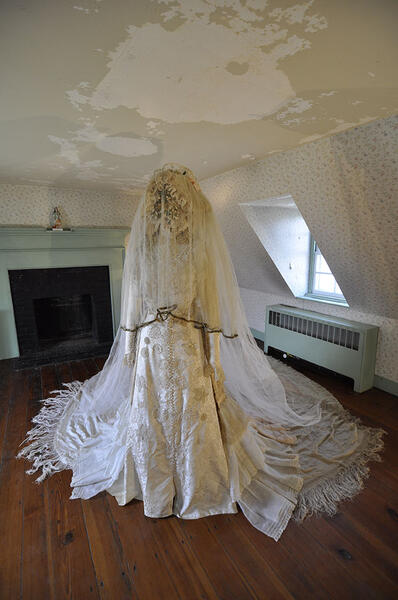 The Family Veil (Bride Figure)The base garment of this piece is a silk brocade wedding gown, which was worn by two generations of Clermont women, in 1939, then again in 1979. Both veils worn by each of the women, one silk tulle, one synthetic, were also integrated into the piece, along with many other garments and trimmings found at Clermont.
The Family Veil (Bride Figure)The base garment of this piece is a silk brocade wedding gown, which was worn by two generations of Clermont women, in 1939, then again in 1979. Both veils worn by each of the women, one silk tulle, one synthetic, were also integrated into the piece, along with many other garments and trimmings found at Clermont. -
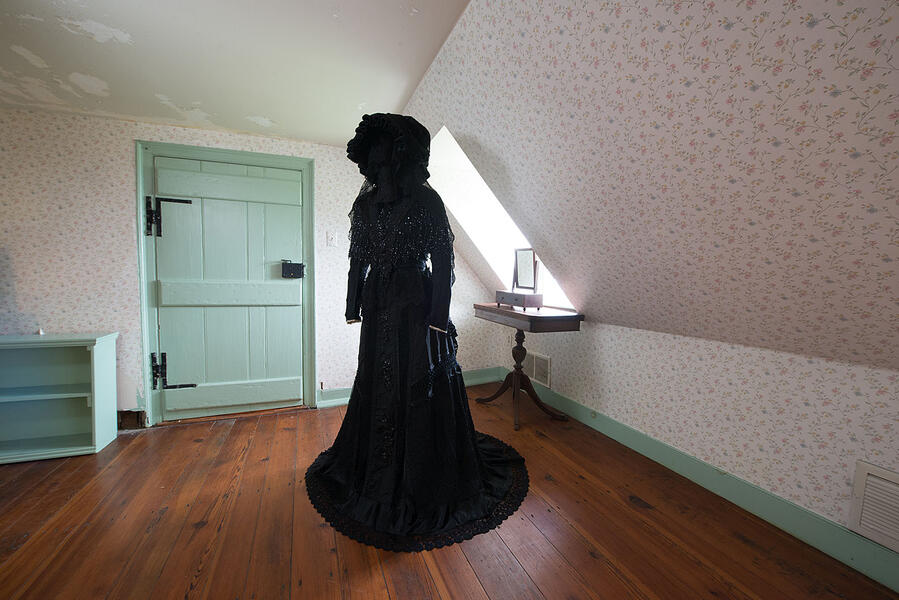 The Family Veil (Mourning Figure)The base garment for this figure was a black satin bodice and skirt, trimmed with braid, circa 1905, intended for wearing during a period of deep mourning for a loved one. Many such Victorian era garments were found on the site. A jet bead capelet, and many other trimmings found at Clermont were also integrated into the garment, as well as buttons from a bodice dated from 1856.
The Family Veil (Mourning Figure)The base garment for this figure was a black satin bodice and skirt, trimmed with braid, circa 1905, intended for wearing during a period of deep mourning for a loved one. Many such Victorian era garments were found on the site. A jet bead capelet, and many other trimmings found at Clermont were also integrated into the garment, as well as buttons from a bodice dated from 1856. -
 The Family VeilDetail of 'Bride Figure'
The Family VeilDetail of 'Bride Figure' -
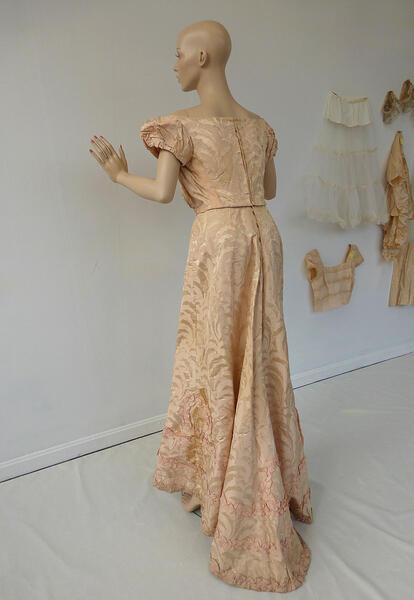 Seam by Seam: The Historical Garments of Clermont FarmDetail from book: http://www.blurb.com/books/5166325-seam-by-seam-a-study-of-the-historical-garments-of Shows a pink damask bodice and skirt with ribbon applique', originally made circa 1900, but later altered and worn as a formal evening dress in the 1940s. This garment, along with many others, was documented, deconstructed, and integrated into "The Family Veil".
Seam by Seam: The Historical Garments of Clermont FarmDetail from book: http://www.blurb.com/books/5166325-seam-by-seam-a-study-of-the-historical-garments-of Shows a pink damask bodice and skirt with ribbon applique', originally made circa 1900, but later altered and worn as a formal evening dress in the 1940s. This garment, along with many others, was documented, deconstructed, and integrated into "The Family Veil". -
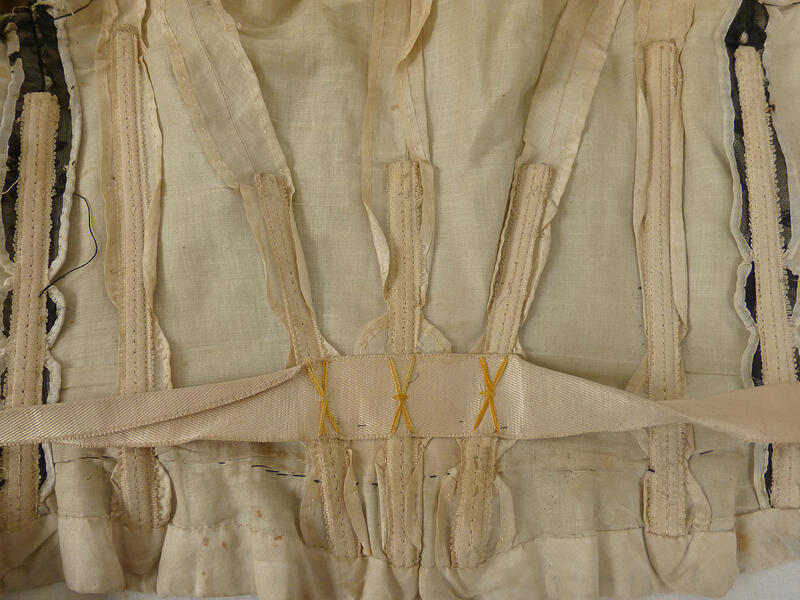 Seam by Seam: The Historical Garments of Clermont FarmThe inside of a bodice, circa 1900... showing the 'stays' or 'bones', made of flexible whale bone.
Seam by Seam: The Historical Garments of Clermont FarmThe inside of a bodice, circa 1900... showing the 'stays' or 'bones', made of flexible whale bone. -
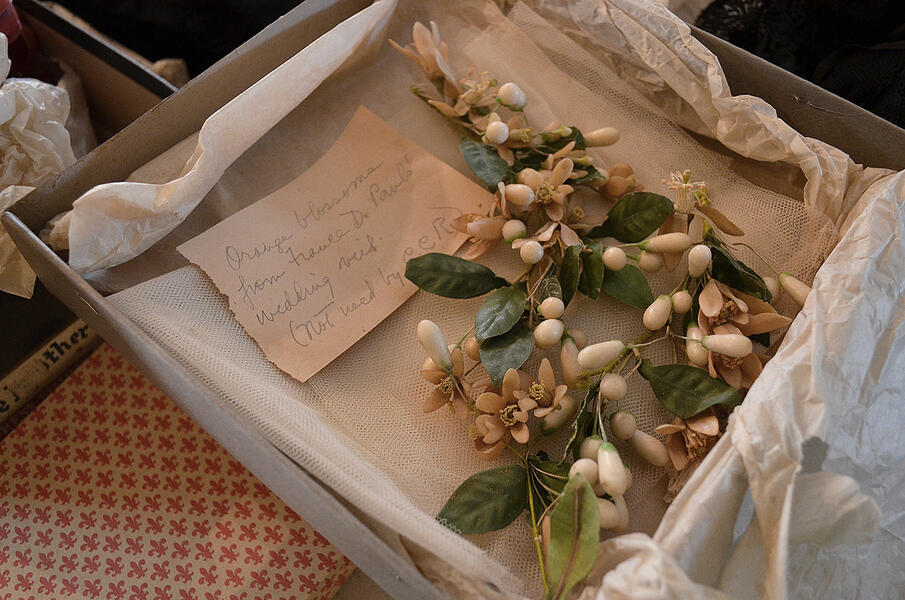 Historical Garment DetailThe women in Clermont's history diligently preserved many important garments by carefully wrapping them in tissue, boxing them, and creating notations outlining the significance of items such as children's clothes, military uniforms, and wedding and funerary dresses. Pictured: Victorian era bridal wax 'Orange blossoms'.
Historical Garment DetailThe women in Clermont's history diligently preserved many important garments by carefully wrapping them in tissue, boxing them, and creating notations outlining the significance of items such as children's clothes, military uniforms, and wedding and funerary dresses. Pictured: Victorian era bridal wax 'Orange blossoms'. -
 Clermont Farm 'Main House'The Clermont Farm homestead is under intensive architectural study due to the many changes and updates it has undergone during it's centuries of existence, and the incredible preservation of these buildings.
Clermont Farm 'Main House'The Clermont Farm homestead is under intensive architectural study due to the many changes and updates it has undergone during it's centuries of existence, and the incredible preservation of these buildings. -
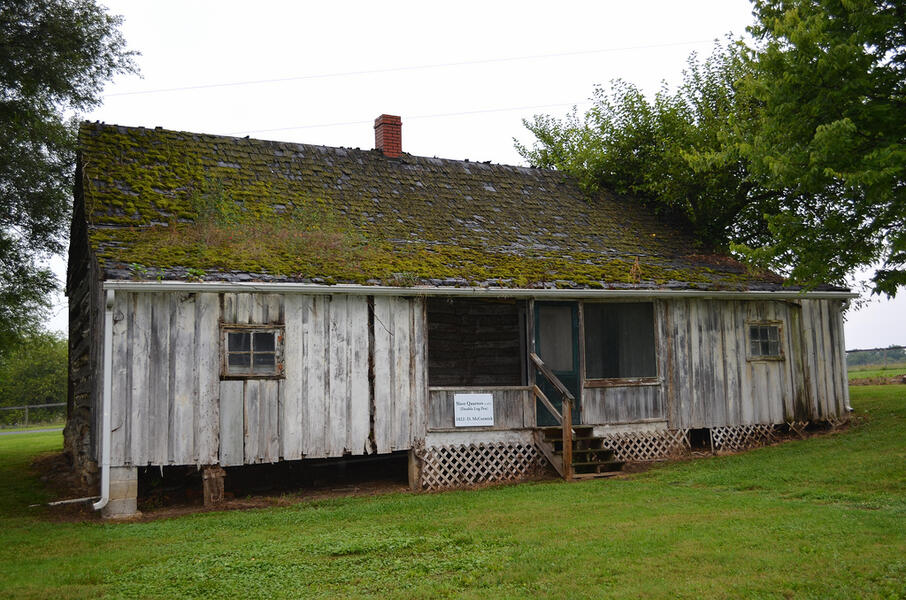 Clermont's Former Slave QuartersThe original slave quarters on Clermont's land still stands. The interior is an intense and chilling space. Ever since entering this building I have questioned it's separateness from the energy of the 'Main House', and the comparative opulence experienced by the slave owners of that particular historical period.
Clermont's Former Slave QuartersThe original slave quarters on Clermont's land still stands. The interior is an intense and chilling space. Ever since entering this building I have questioned it's separateness from the energy of the 'Main House', and the comparative opulence experienced by the slave owners of that particular historical period.
"Front Stoop / Back Yard" Co-Lab(oration)
In 2013, along with Baltimore artists Linda Depalma, Kelley Bell, and School 33 Art Center, Melissa received a Robert Rauschenberg Foundation Artistic Innovation and Collaboration grant. The resulting outdoor, site-specific installation opened in June of 2014. The Co-Lab team's work addressed the building's northern exterior wall and adjoining 1900 square foot vacant lot, which up until now has suffered from neglect.
Linda, Kelley, and I worked for many months to design and execute this project. We fabricated eight birdhouses, each an ode to a different Baltimore architectural landmark. These were placed upon metal venetian-style poles around the site, including a pair of Charles Village "Painted Ladies" and Penn Station, complete with Man / Woman sculpture (designed and built by me), The Patterson Park Pagoda, Bromo-Seltzer Tower, and replica of School 33 Art Center (designed and built by Linda DePalma), and three cast formstone-esque brick constructions (designed and built by Kelley Bell) all became potential homes for birds.
Two sets of concrete steps, cast to resemble marble, and colorful awning structures above them serve as shade structures and seating area for visitors. Six 3' x 9' painted screen panels, inspired by Baltimore screen-painters, were designed and painted by Jessie Underhalter and Katie Truhn.
Linda, Kelley, and I worked for many months to design and execute this project. We fabricated eight birdhouses, each an ode to a different Baltimore architectural landmark. These were placed upon metal venetian-style poles around the site, including a pair of Charles Village "Painted Ladies" and Penn Station, complete with Man / Woman sculpture (designed and built by me), The Patterson Park Pagoda, Bromo-Seltzer Tower, and replica of School 33 Art Center (designed and built by Linda DePalma), and three cast formstone-esque brick constructions (designed and built by Kelley Bell) all became potential homes for birds.
Two sets of concrete steps, cast to resemble marble, and colorful awning structures above them serve as shade structures and seating area for visitors. Six 3' x 9' painted screen panels, inspired by Baltimore screen-painters, were designed and painted by Jessie Underhalter and Katie Truhn.
-
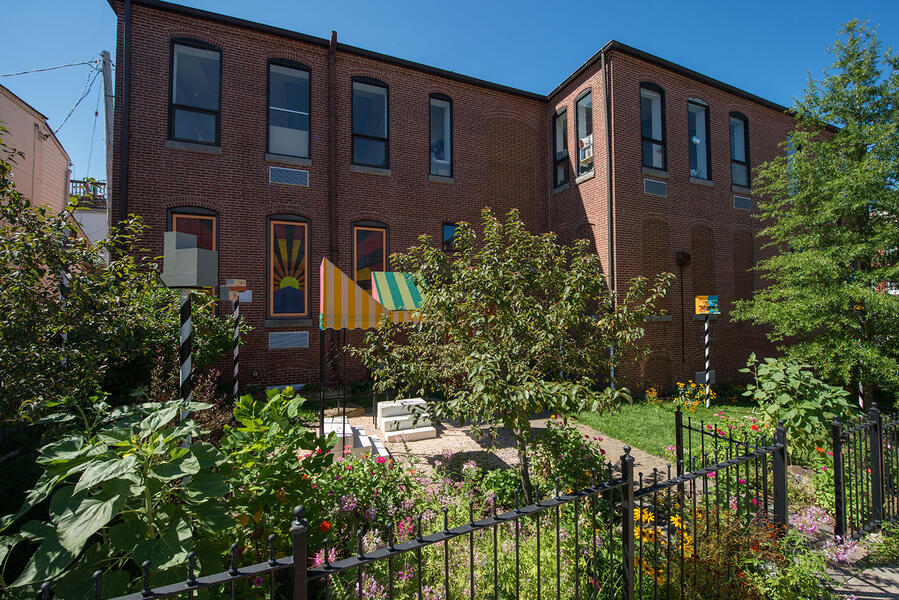 Front Stoop / Back YardView of part of the installation from the Clement Street side.
Front Stoop / Back YardView of part of the installation from the Clement Street side. -
 Front Stoop / Back Yard (Detail of Charles Village Painted Ladies Birdhouse)Front Stoop / Back Yard (Detail of Charles Village Painted Ladies Birdhouse). In 2013, along with Baltimore artists Linda Depalma, Kelley Bell, and School 33 Art Center, Melissa received a Robert Rauschenberg Foundation Artistic Innovation and Collaboration grant. The resulting outdoor, site-specific installation opened in June of 2014. The so-called 'Co-Lab' team's work addressed the building's northern exterior wall and adjoining 1900 square foot vacant lot, which up until that point had suffered from neglect. Linda, Kelley, and Melissa worked together for many months to design and execute this project. They fabricated eight birdhouses, each an ode to a different Baltimore architectural landmark. These were placed upon metal venetian-style poles around the site. The birdhouses include a pair of "Painted Ladies",- colorful townhouses from Baltimore's Charles Village neigborhood- and Penn Station, complete with oversized Man / Woman sculpture, both designed and fabricated by Melissa. The Patterson Park Pagoda, Bromo-Seltzer Tower, and replica of School 33 Art Center were designed and built by Linda DePalma, and three cast formstone-esque brick constructions, designed and built by Kelley Bell. All became potential homes for birds. Two sets of concrete steps, cast to resemble marble, and colorful awning structures above them serve as shade structures and seating area for visitors. Six 3' x 9' painted screen panels, inspired by Baltimore screen-painters, were designed and painted by Jessie Unterhalter and Katie Truhn. The installation is on view indefinitely at the entrance of School 33 Art Center.
Front Stoop / Back Yard (Detail of Charles Village Painted Ladies Birdhouse)Front Stoop / Back Yard (Detail of Charles Village Painted Ladies Birdhouse). In 2013, along with Baltimore artists Linda Depalma, Kelley Bell, and School 33 Art Center, Melissa received a Robert Rauschenberg Foundation Artistic Innovation and Collaboration grant. The resulting outdoor, site-specific installation opened in June of 2014. The so-called 'Co-Lab' team's work addressed the building's northern exterior wall and adjoining 1900 square foot vacant lot, which up until that point had suffered from neglect. Linda, Kelley, and Melissa worked together for many months to design and execute this project. They fabricated eight birdhouses, each an ode to a different Baltimore architectural landmark. These were placed upon metal venetian-style poles around the site. The birdhouses include a pair of "Painted Ladies",- colorful townhouses from Baltimore's Charles Village neigborhood- and Penn Station, complete with oversized Man / Woman sculpture, both designed and fabricated by Melissa. The Patterson Park Pagoda, Bromo-Seltzer Tower, and replica of School 33 Art Center were designed and built by Linda DePalma, and three cast formstone-esque brick constructions, designed and built by Kelley Bell. All became potential homes for birds. Two sets of concrete steps, cast to resemble marble, and colorful awning structures above them serve as shade structures and seating area for visitors. Six 3' x 9' painted screen panels, inspired by Baltimore screen-painters, were designed and painted by Jessie Unterhalter and Katie Truhn. The installation is on view indefinitely at the entrance of School 33 Art Center. -
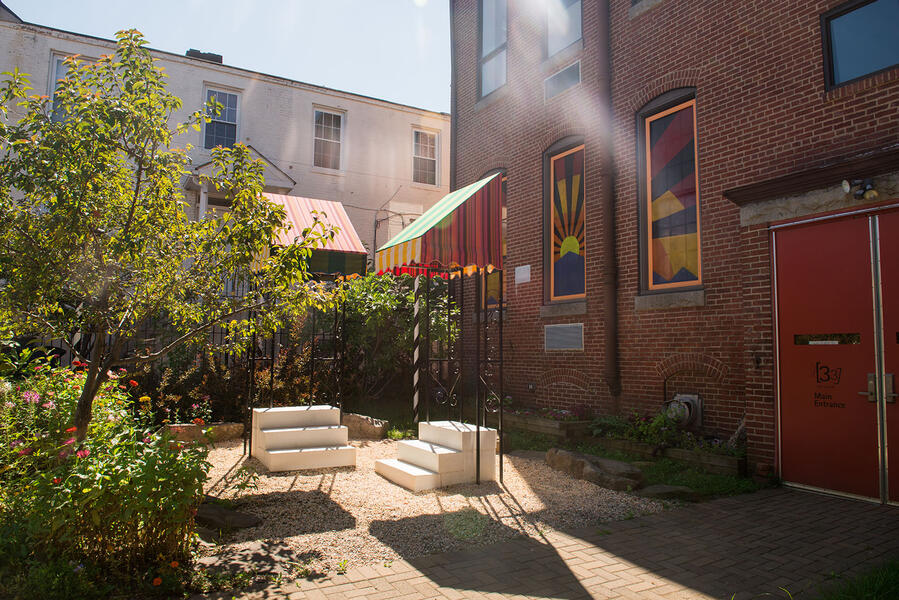 Installation Detail: Front Stoops and Awning Structures / Painted Screens
Installation Detail: Front Stoops and Awning Structures / Painted Screens -
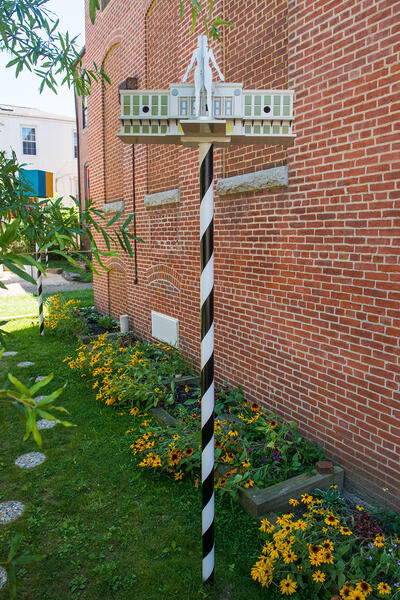 Penn Station Birdhouse
Penn Station Birdhouse -
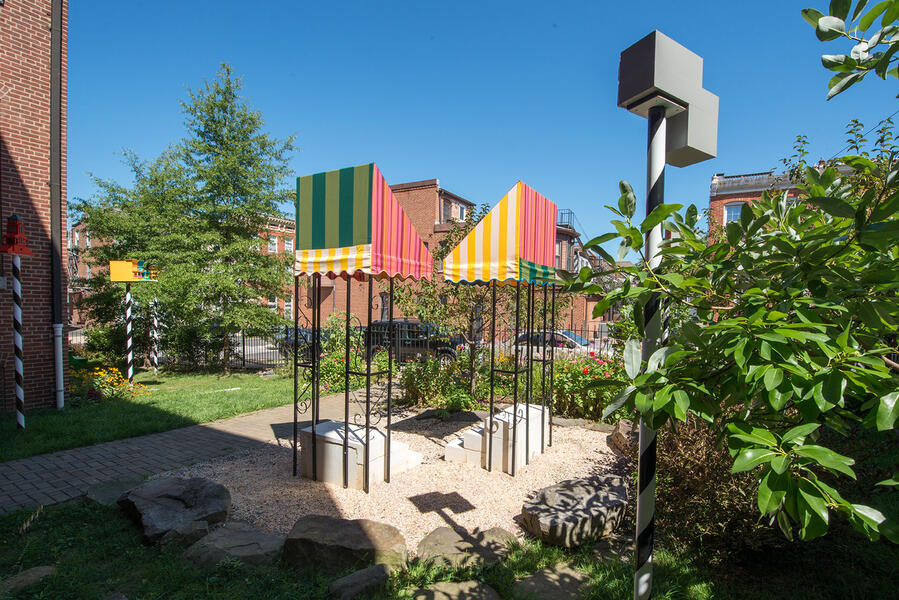 Front Stoops and Awning Structures(Rear view)
Front Stoops and Awning Structures(Rear view) -
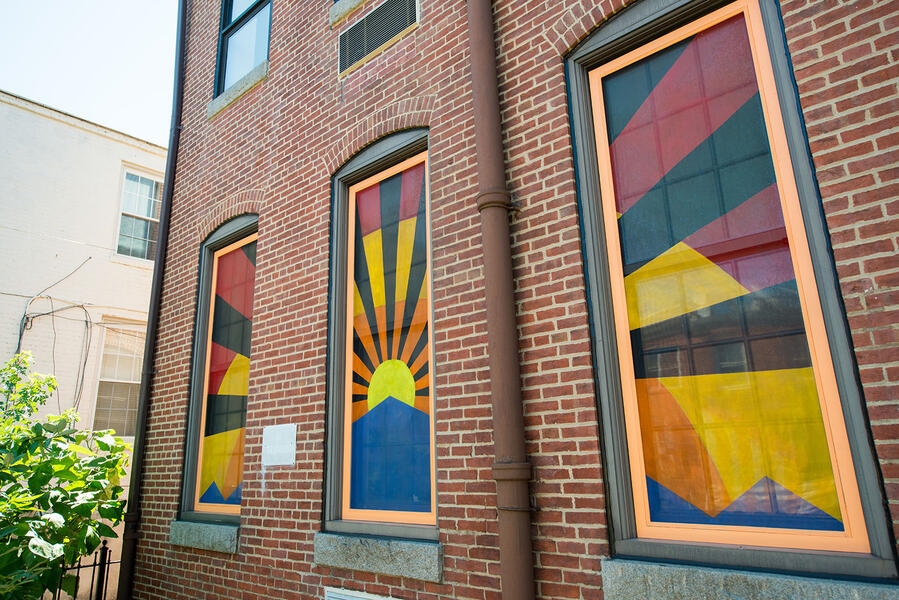 Painted Screens
Painted Screens -
 Painted Screens / Bromo-Seltzer Tower Birdhouse
Painted Screens / Bromo-Seltzer Tower Birdhouse -
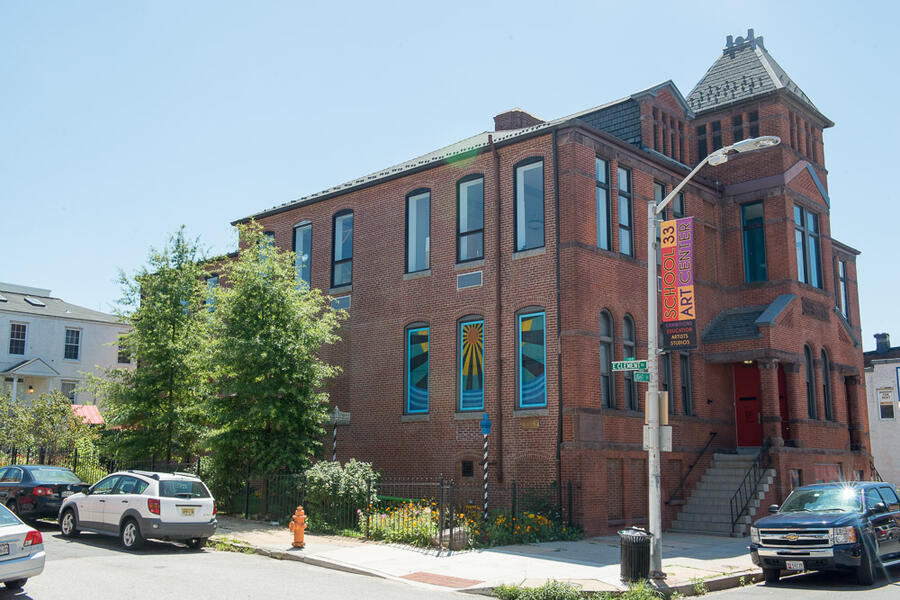 View of School 33 Art Center
View of School 33 Art Center -
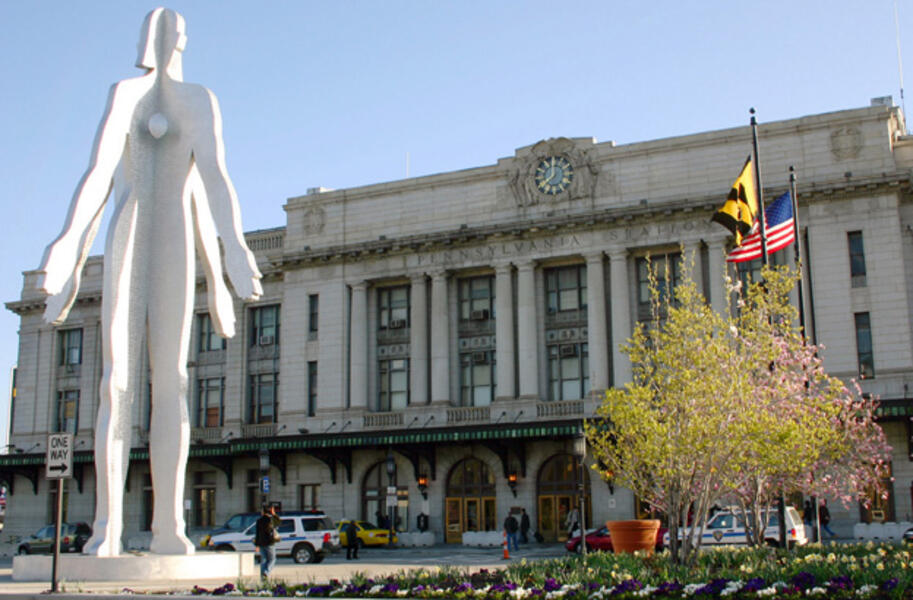 Reference Image: Penn Station
Reference Image: Penn Station -
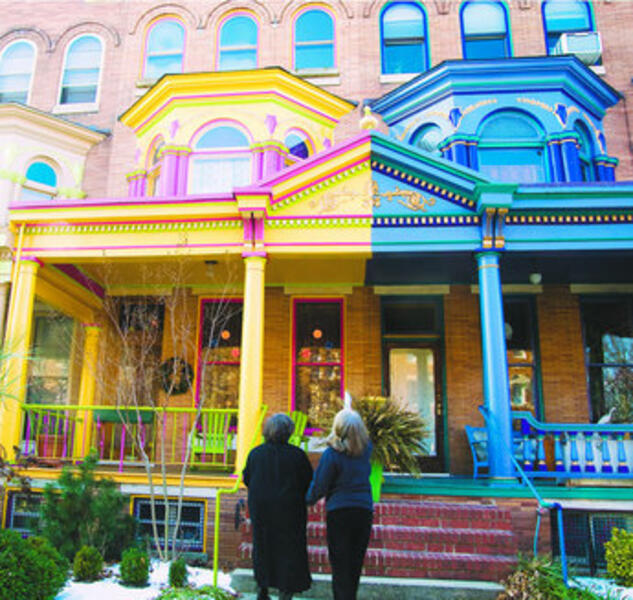 Reference Image: Charles Village Painted LadiesThe Charles Village Painted Lady Birdhouse was inspired by and modeled after this set of painted ladies on Calvert Street, with special attention to the center divide, which on this and many other houses is created by paint of different colors. The neighbors each have their own specific style and color palate.
Reference Image: Charles Village Painted LadiesThe Charles Village Painted Lady Birdhouse was inspired by and modeled after this set of painted ladies on Calvert Street, with special attention to the center divide, which on this and many other houses is created by paint of different colors. The neighbors each have their own specific style and color palate.
In Between
A participatory performance and site-specific light installation, which took place at the 2012 Transmodern Festival as part of "Alley Oops!" curated by Laure Drogoul. In this piece, 2 characters, played by Autumn Breaud and Melissa Webb, moved about the nighttime alley space, which was transformed by sculptural objects filled with blue light. They interacted with the audience, guiding up to 3 people at a time by the hand to sit upon round pillows, where they were each given light-eminating head pieces, as well as light-refracting glasses with which to watch the performers and take in the surrounding environment.
"In Between" was created in memory of Flo McGarrell, a dear, longtime friend and collaborator who died in the Haitian Earthquake on January 12, 2010. It was intended to create a transcendent state within the viewer and to represent the moments experienced immediately following sudden death, as outlined by the Tibetan book of the dead.
"In Between" was created in memory of Flo McGarrell, a dear, longtime friend and collaborator who died in the Haitian Earthquake on January 12, 2010. It was intended to create a transcendent state within the viewer and to represent the moments experienced immediately following sudden death, as outlined by the Tibetan book of the dead.
-
 In BetweenIn Between was a participatory performance and site-specific light installation, which took place at the 2012 Transmodern Festival as part of "Alley Oops!" curated by Laure Drogoul. In this piece, 2 characters, played by Autumn Breaud and Melissa Webb, moved about the nighttime alley space, which was transformed by sculptural objects filled with blue light. They interacted with the audience, guiding up to 3 people at a time by the hand to sit upon round pillows, where they were each given light-eminating head pieces, as well as light-refracting glasses with which to watch the performers and take in the surrounding environment. Pictured: A view of refracted light from "In Between", as seen through the special glasses provided.
In BetweenIn Between was a participatory performance and site-specific light installation, which took place at the 2012 Transmodern Festival as part of "Alley Oops!" curated by Laure Drogoul. In this piece, 2 characters, played by Autumn Breaud and Melissa Webb, moved about the nighttime alley space, which was transformed by sculptural objects filled with blue light. They interacted with the audience, guiding up to 3 people at a time by the hand to sit upon round pillows, where they were each given light-eminating head pieces, as well as light-refracting glasses with which to watch the performers and take in the surrounding environment. Pictured: A view of refracted light from "In Between", as seen through the special glasses provided. -
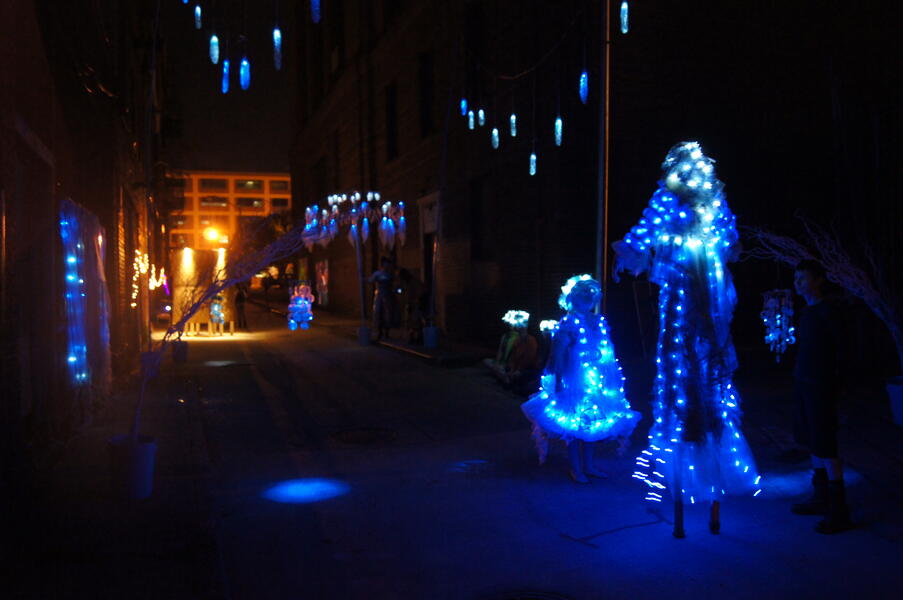 In Between (Original 2012 Performance)
In Between (Original 2012 Performance) -
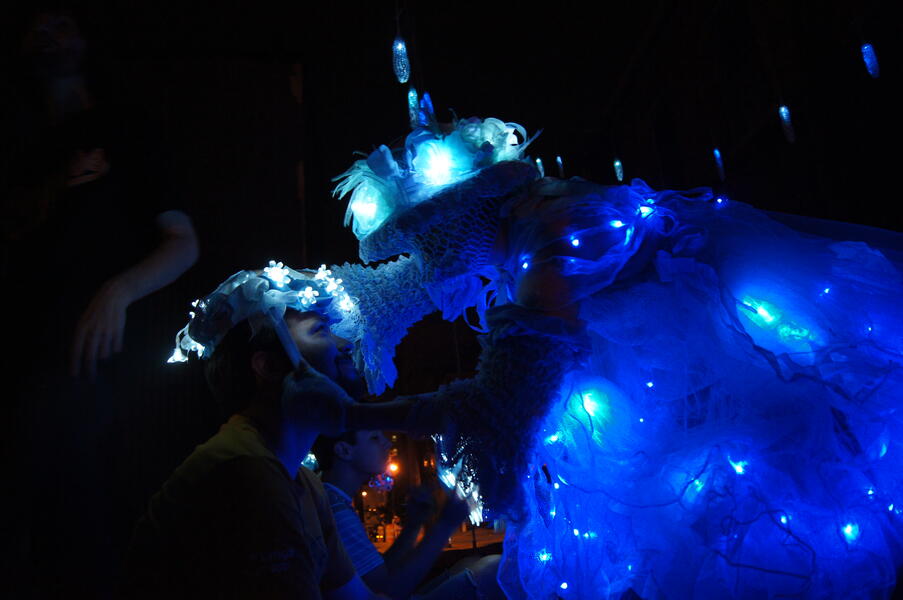 In Between (Performance detail)
In Between (Performance detail) -
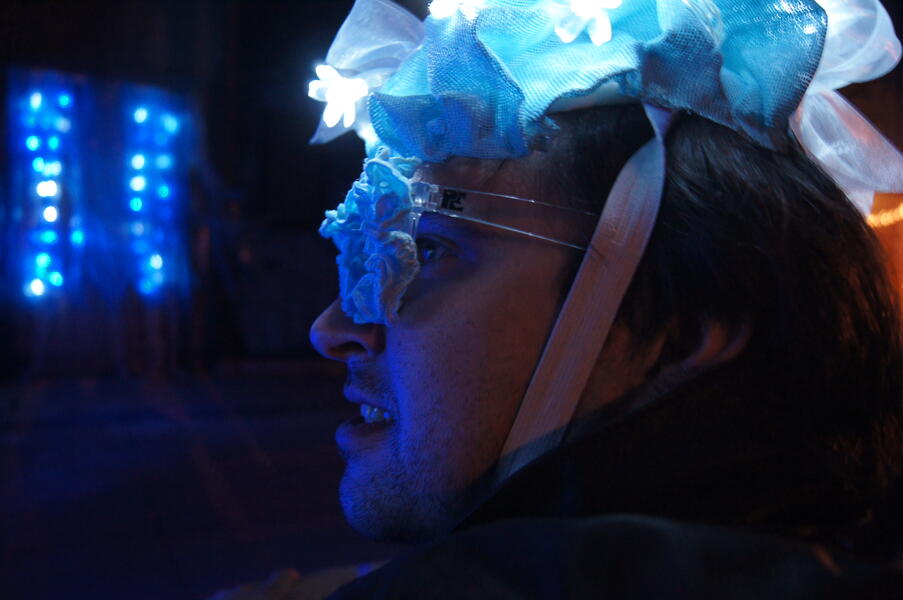 In Between (Participant detail)
In Between (Participant detail) -
 In Between (Performance detail)
In Between (Performance detail) -
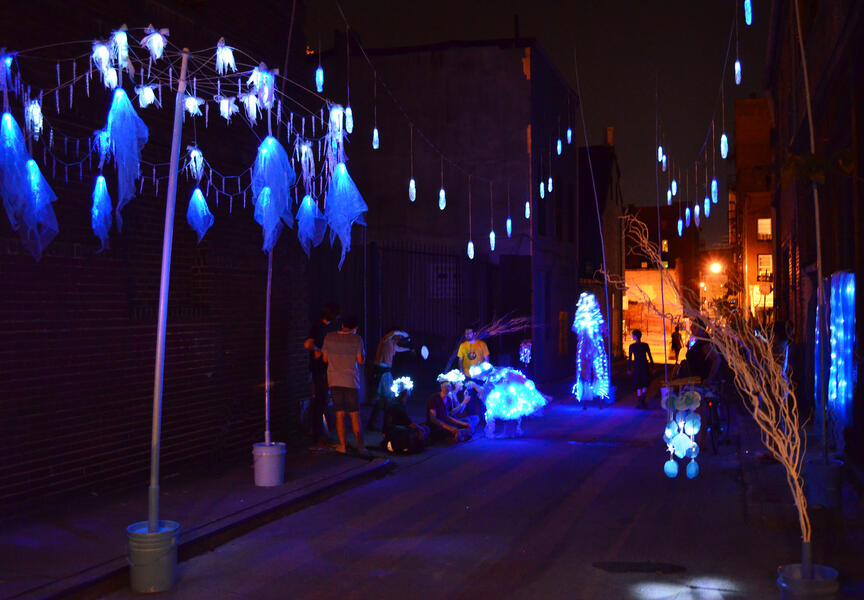 In Between
In Between -
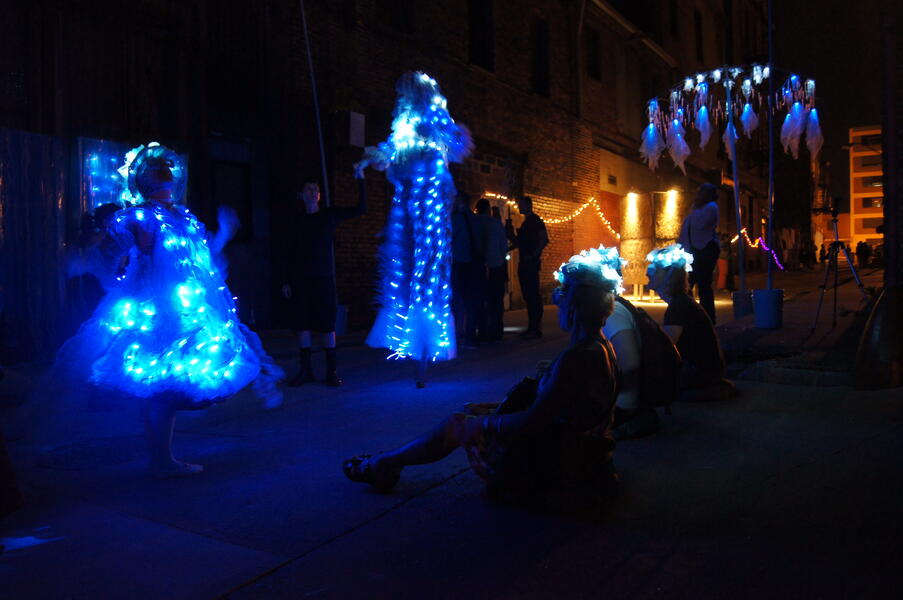 In Between (Performance detail)
In Between (Performance detail) -
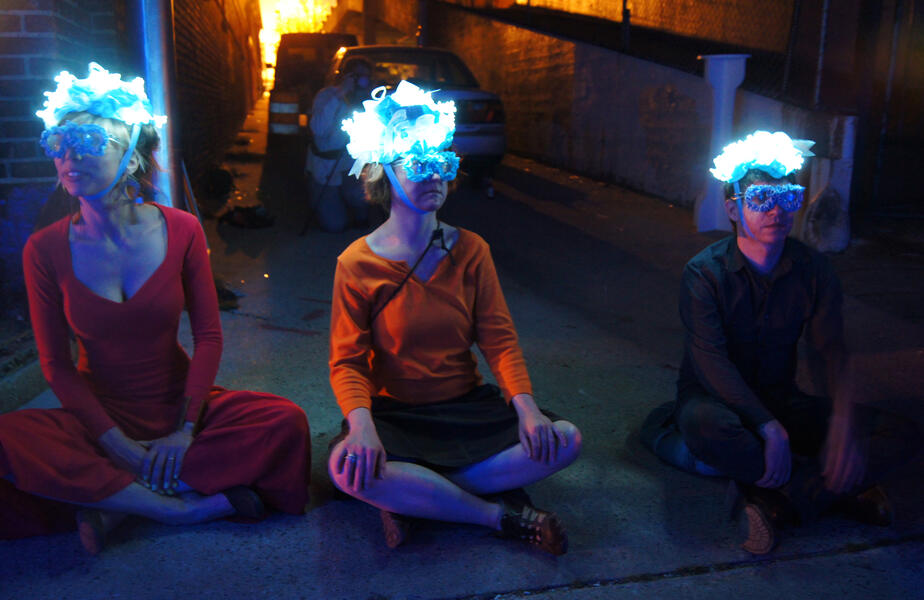 In Between (Participant detail)
In Between (Participant detail) -
In Between (Video- Image animation)
-
 In Between: Relics From The (Not So) Ever AfterAn installation of costume and video from the 2012 live performance, featured at the 2013 Sondheim Semi-Final exhibition at MICA during Artscape.
In Between: Relics From The (Not So) Ever AfterAn installation of costume and video from the 2012 live performance, featured at the 2013 Sondheim Semi-Final exhibition at MICA during Artscape.
Below Street Level
Below Street Level was a site-specific installation and cumulative performance which took place at the EMP Collective, as part of The Rotating History Project's "Down Through The Needle's Eye" exhibition. Performed by Theresa Columbus and Melissa Webb over a period of 2 hours, ladies dressed in early 19th century shirt-waist blouses and many-layered white cotton skirts hand-sewed themselves into their environment...Stitching into several points around the edge of each skirt, and connecting each strand of thread into the light-filled, cloud-like billowing fabric treatment above their heads. Over time this action caused the garments to form a lotus-like form around each of the performers.
Here is my artist statement for the show:
"Below Street Level is a site-specific installation utilizing the outdoor, arched and recessed areas at the bottom of the Faust building to explore themes of labor, mass production, and accumulation. As a longtime Baltimore resident and maker of garments, costumes, and other custom fabric goods as both a means of employment and as a primary aspect of her art, Melissa has become increasingly interested in the history of the once booming garment trade in our city. Specifically, the industrial shift from custom tailoring to mass factory and sweat shop production during the 1800's, driven in large measure by changes in the style and function of clothing, the invention of the sewing machine, as well as ever-increasing consumer demand. This work interlaces the struggles faced by garment workers of this time period with the excitement of innovation, commerce and success experienced by business owners and pioneers of the needle trades."
Here is my artist statement for the show:
"Below Street Level is a site-specific installation utilizing the outdoor, arched and recessed areas at the bottom of the Faust building to explore themes of labor, mass production, and accumulation. As a longtime Baltimore resident and maker of garments, costumes, and other custom fabric goods as both a means of employment and as a primary aspect of her art, Melissa has become increasingly interested in the history of the once booming garment trade in our city. Specifically, the industrial shift from custom tailoring to mass factory and sweat shop production during the 1800's, driven in large measure by changes in the style and function of clothing, the invention of the sewing machine, as well as ever-increasing consumer demand. This work interlaces the struggles faced by garment workers of this time period with the excitement of innovation, commerce and success experienced by business owners and pioneers of the needle trades."
-
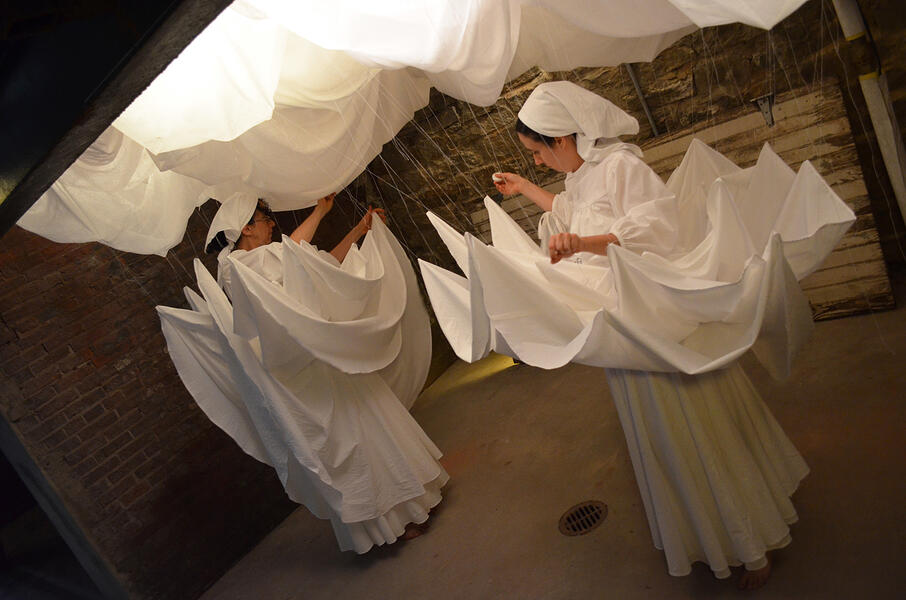 Below Street Level
Below Street Level -
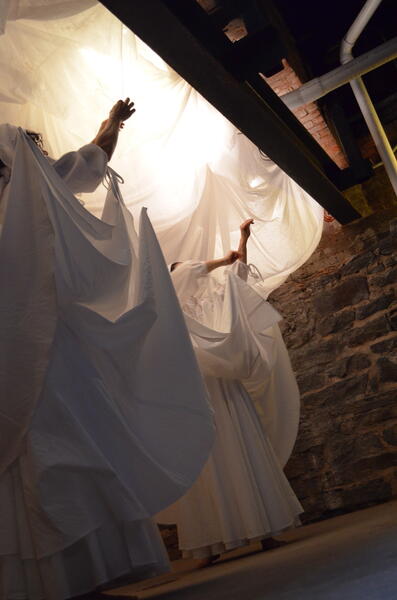 Below Street Level
Below Street Level -
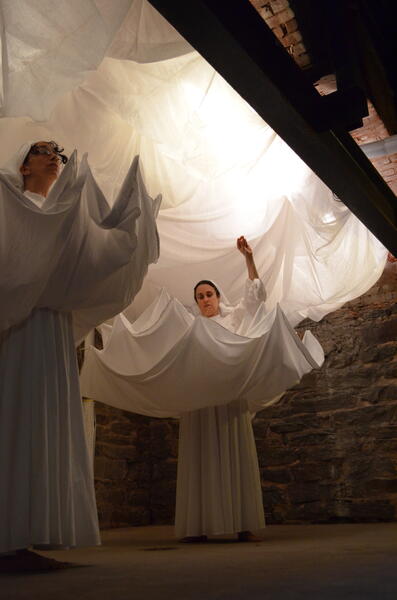 Below Street Level (Performance detail)
Below Street Level (Performance detail) -
 Below Street Level (Performance detail)
Below Street Level (Performance detail) -
 Below Street Level (Performance detail)
Below Street Level (Performance detail) -
 Below Street Level (Performance detail)
Below Street Level (Performance detail) -
 Below Street Level (Performance detail)
Below Street Level (Performance detail) -
 Below Street Level (Performance detail)
Below Street Level (Performance detail) -
 Below Street Level (Post performance installation view)On display for over one month, this outdoor space was vulnerable to rain and dirt falling from above... the piece miraculously held up despite persistent rainfall and winds which swept into the under-stair area.
Below Street Level (Post performance installation view)On display for over one month, this outdoor space was vulnerable to rain and dirt falling from above... the piece miraculously held up despite persistent rainfall and winds which swept into the under-stair area.
Landing of the Magic Flight: The Mysteries of Memory
Shown here at the Sondheim Semi-final Exhibition in the Meyerhoff Gallery at the Maryland Institute, College of Art as both a live performance and a static installation. This participatory performance was first mounted for Copycat Theatre's "The Rooms Play", Spring 2011. Participants entering the space were invited to cut shapes from cookie dough, asked to stand against a wall to measure how much they had grown, and one person in each gathering of viewers was singled out and given a birthday cake, which was shared around the room in sections while the other participants were encouraged to sing to them.
The original intention for creating the piece, within the context of The Rooms Play structure, was to create the illusion of a nostalgic ideal of home, safety, and innocence. Viewers were lured into the comfort of the space created by the sights, smells, and sounds of a loving grandmother's home... but upon closer inspection it was all a false, pre-packaged reality. Kitchen appliances, forest trees, and picket fences were only cardboard flats with obvious wooden stands... if tasted, cookies revealed themselves to be made with only salt, water, and flour, the smell only a store-bought scented candle... and an elaborate birthday cake was made from cardboard and antique doilies.
Photographed by Edward Winter.
The original intention for creating the piece, within the context of The Rooms Play structure, was to create the illusion of a nostalgic ideal of home, safety, and innocence. Viewers were lured into the comfort of the space created by the sights, smells, and sounds of a loving grandmother's home... but upon closer inspection it was all a false, pre-packaged reality. Kitchen appliances, forest trees, and picket fences were only cardboard flats with obvious wooden stands... if tasted, cookies revealed themselves to be made with only salt, water, and flour, the smell only a store-bought scented candle... and an elaborate birthday cake was made from cardboard and antique doilies.
Photographed by Edward Winter.
-
 Landing of the Magic Flight: The Mysteries of Memory (Installation overview)The Sondheim Semi-final Exhibition ran for one month, and was open during Artscape weekend. There were several live participatory performances, with Autumn Breaud and myself in full costume and character. When we were not present in the gallery, mannequins stood in our stead.
Landing of the Magic Flight: The Mysteries of Memory (Installation overview)The Sondheim Semi-final Exhibition ran for one month, and was open during Artscape weekend. There were several live participatory performances, with Autumn Breaud and myself in full costume and character. When we were not present in the gallery, mannequins stood in our stead. -
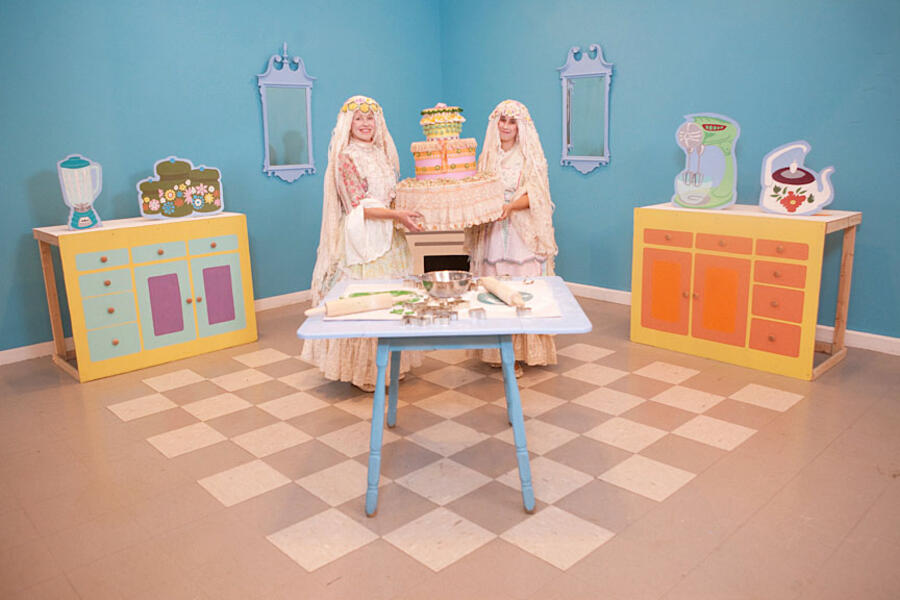 Landing of the Magic Flight: The Mysteries of Memory (Performance detail)
Landing of the Magic Flight: The Mysteries of Memory (Performance detail) -
 It's Your Birthday... I Baked You a Cake...Lucky participants were handed a faux cake covered in doilies and trimmings. The two grandmothers sang "Happy Birthday", encouraging all others in the space at that moment to sing along. Once this action was complete, the cake, having three separate layers, was taken apart and shared with other participants.
It's Your Birthday... I Baked You a Cake...Lucky participants were handed a faux cake covered in doilies and trimmings. The two grandmothers sang "Happy Birthday", encouraging all others in the space at that moment to sing along. Once this action was complete, the cake, having three separate layers, was taken apart and shared with other participants. -
 Landing of the Magic Flight (Partipatory detail)Participants in the space were invited to pick a cookie-cutter shape and press faux cookies from colored salt dough, which were then placed upon cookie sheets.
Landing of the Magic Flight (Partipatory detail)Participants in the space were invited to pick a cookie-cutter shape and press faux cookies from colored salt dough, which were then placed upon cookie sheets. -
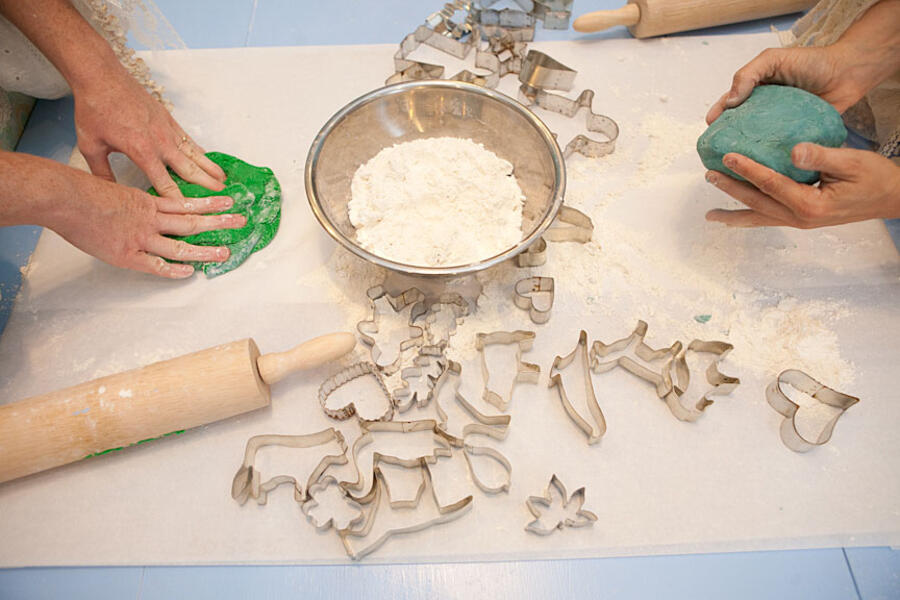 Rolling the DoughIn moments where no one was taking part in the cookie-making, the two grandmother characters would re-roll the dough in preparation.
Rolling the DoughIn moments where no one was taking part in the cookie-making, the two grandmother characters would re-roll the dough in preparation. -
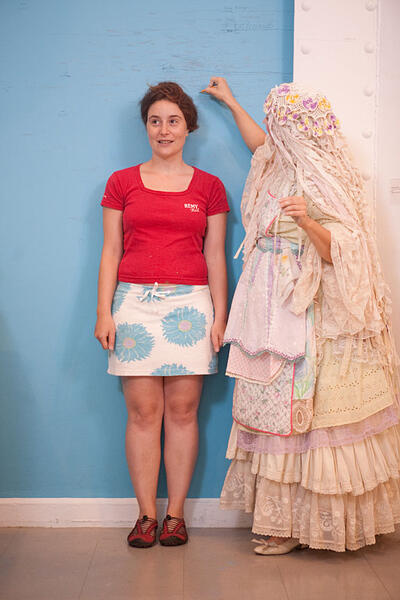 My How You Have Grown...Participants were led to a nearby wall to have their height measured, as though this had been a tradition on each visit to Grandmother's home.
My How You Have Grown...Participants were led to a nearby wall to have their height measured, as though this had been a tradition on each visit to Grandmother's home. -
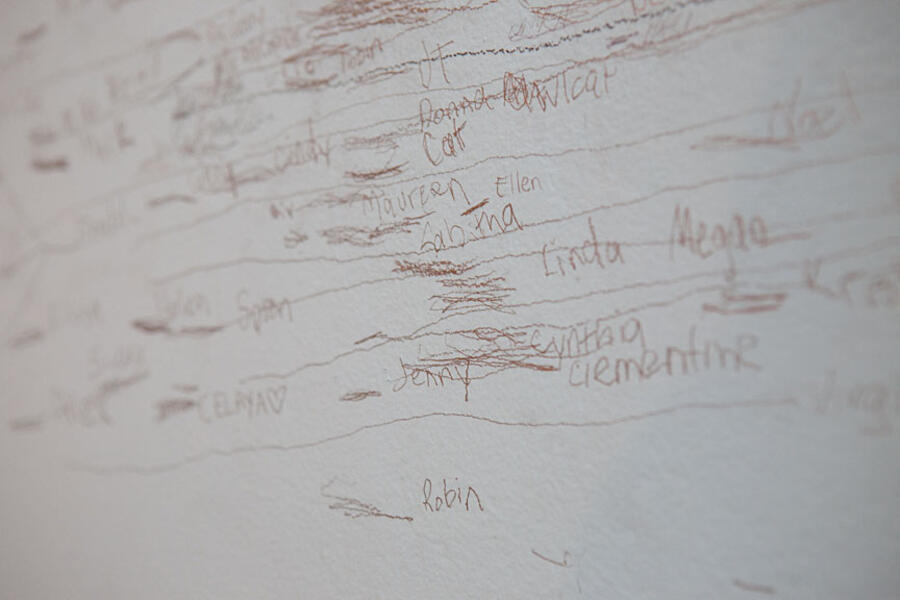 Landing of the Magic Flight (Partipatory residue)Once their height was marked, participants were given a penci and asked to note their name next to the line.
Landing of the Magic Flight (Partipatory residue)Once their height was marked, participants were given a penci and asked to note their name next to the line. -
 Two GrandmothersIn the original "Roomsplay" performances, I performed solo in the space. For the Sondheim exhibition I created a second, or doppleganger "Grandmother" character, played by performer Autumn Breaud. The two of us played off of eachother in the space as we interacted with participants, sometimes taking eachother into account, and sometimes moving along as though the other were not there.
Two GrandmothersIn the original "Roomsplay" performances, I performed solo in the space. For the Sondheim exhibition I created a second, or doppleganger "Grandmother" character, played by performer Autumn Breaud. The two of us played off of eachother in the space as we interacted with participants, sometimes taking eachother into account, and sometimes moving along as though the other were not there.
The Temporary Nature of Ideas
The Temporary Nature of Ideas was a large scale, participatory and performative installation. It was first presented as a site-specific piece at the 2009 Transmodern Festival, and was subsequently mounted as a solo show at School 33 Art Center in 2010.
Viewer/particpants were presented with the following promt:
Feel free to use the space and materials provided to make a personal object in celebration of an unfruitful, unexplored, or abandoned idea. Your object will be a tribute to this idea, once alive and vibrant in your mind's eye, but now retired and unrealized. When you are finished, please use the clothespins and pulleys in the gallery to incorporate your idea into the growing environment.
Below is the artist statement for this series of work:
As a fiber artist, I love the process of making- of obsessively crafting an object, a costume, or an installation, then combining the fruits of these efforts to create entirely new realities through the use of performance and audience participation. I tend to construct detail-oriented, otherworldly scenarios that can be viewed and interacted with in a casual manner, and where the performers are encouraged to react and improvise. The work becomes fully realized through this continuous interaction between the performer, the viewer, and the surrounding environment.
I am interested in removing the separation between the viewer and the work of art, as well as between the audience member and the performer. I want to enable others to become directly involved with the work, and to give them a role in determining the ultimate outcome of each piece. This concept is evident in The Temporary Nature of Ideas, a series of large-scale, living installations that I began in 2009. Viewer / participants, using provided materials, are invited to delve into the process of making with me, and to be a part of the growth taking place over time within the space.
There is an inherent collaborative nature to all of my work. I see interactive and participatory work as collaboration with the audience. I feel that collaboration and intuitive processes go hand and hand because what another individual or in this case, many individuals, can bring to a piece is yet another unknown element, another layer of mystery to unfold. In this way the process continues throughout the life of the piece.
Featured performers were Kelley Bell, Theresa Columbus, Jackie Milad, Monica Mirabile, Spoon Popkin, Nicole Shiflet, Lee Sinowski, and myself. Photography by Edward Winter.
Viewer/particpants were presented with the following promt:
Feel free to use the space and materials provided to make a personal object in celebration of an unfruitful, unexplored, or abandoned idea. Your object will be a tribute to this idea, once alive and vibrant in your mind's eye, but now retired and unrealized. When you are finished, please use the clothespins and pulleys in the gallery to incorporate your idea into the growing environment.
Below is the artist statement for this series of work:
As a fiber artist, I love the process of making- of obsessively crafting an object, a costume, or an installation, then combining the fruits of these efforts to create entirely new realities through the use of performance and audience participation. I tend to construct detail-oriented, otherworldly scenarios that can be viewed and interacted with in a casual manner, and where the performers are encouraged to react and improvise. The work becomes fully realized through this continuous interaction between the performer, the viewer, and the surrounding environment.
I am interested in removing the separation between the viewer and the work of art, as well as between the audience member and the performer. I want to enable others to become directly involved with the work, and to give them a role in determining the ultimate outcome of each piece. This concept is evident in The Temporary Nature of Ideas, a series of large-scale, living installations that I began in 2009. Viewer / participants, using provided materials, are invited to delve into the process of making with me, and to be a part of the growth taking place over time within the space.
There is an inherent collaborative nature to all of my work. I see interactive and participatory work as collaboration with the audience. I feel that collaboration and intuitive processes go hand and hand because what another individual or in this case, many individuals, can bring to a piece is yet another unknown element, another layer of mystery to unfold. In this way the process continues throughout the life of the piece.
Featured performers were Kelley Bell, Theresa Columbus, Jackie Milad, Monica Mirabile, Spoon Popkin, Nicole Shiflet, Lee Sinowski, and myself. Photography by Edward Winter.
-
 Temporary Nature_S33_01.jpg
Temporary Nature_S33_01.jpg -
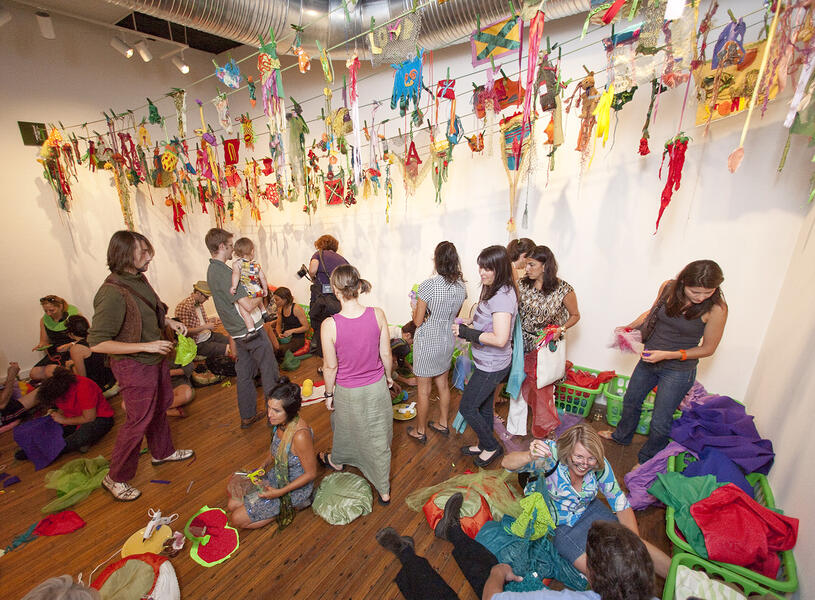 Temporary Nature_S33_04.jpg
Temporary Nature_S33_04.jpg -
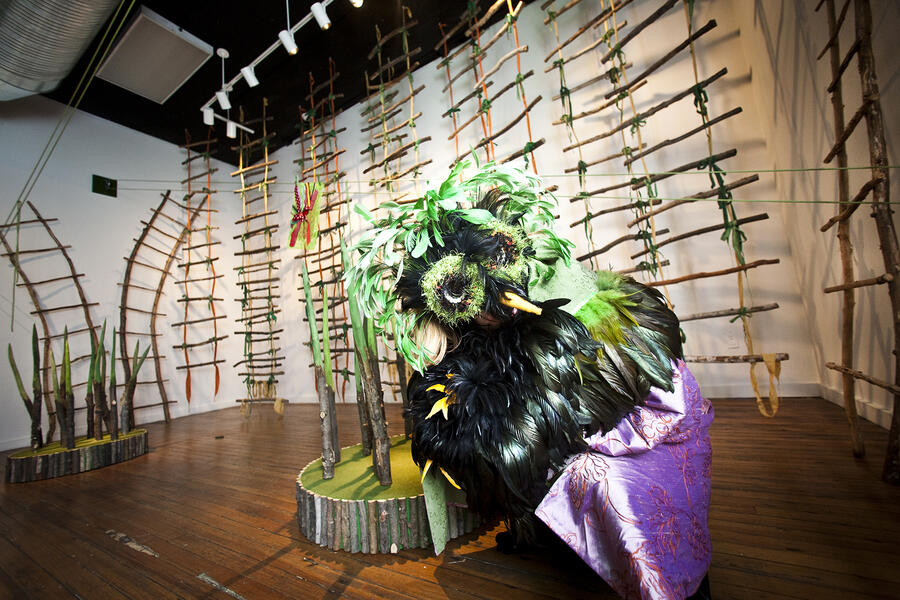 Temporary Nature_S33_07.jpg
Temporary Nature_S33_07.jpg -
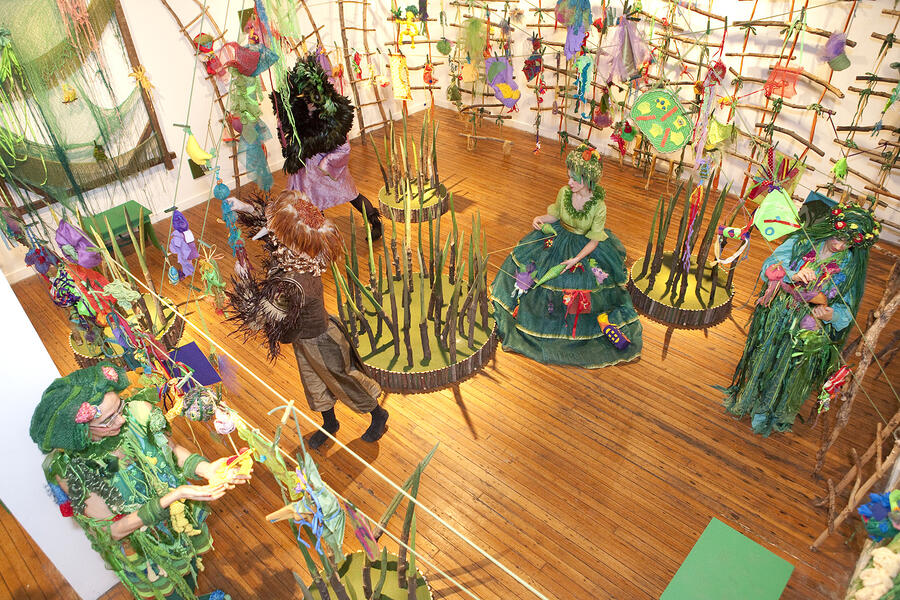 Temporary Nature_S33_05.jpg
Temporary Nature_S33_05.jpg -
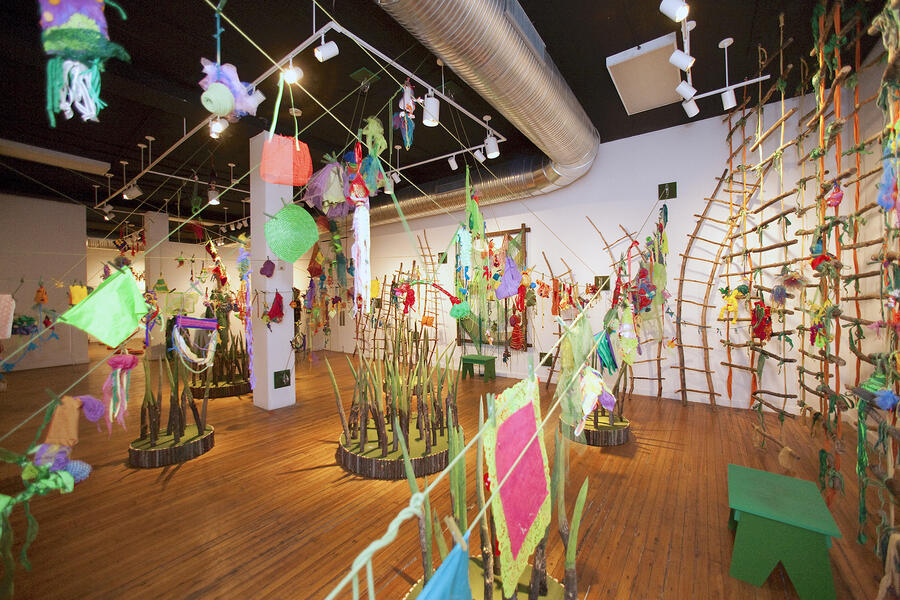 Temporary Nature_S33_03.jpg
Temporary Nature_S33_03.jpg -
 Temporary Nature Transmod_01.jpg
Temporary Nature Transmod_01.jpg -
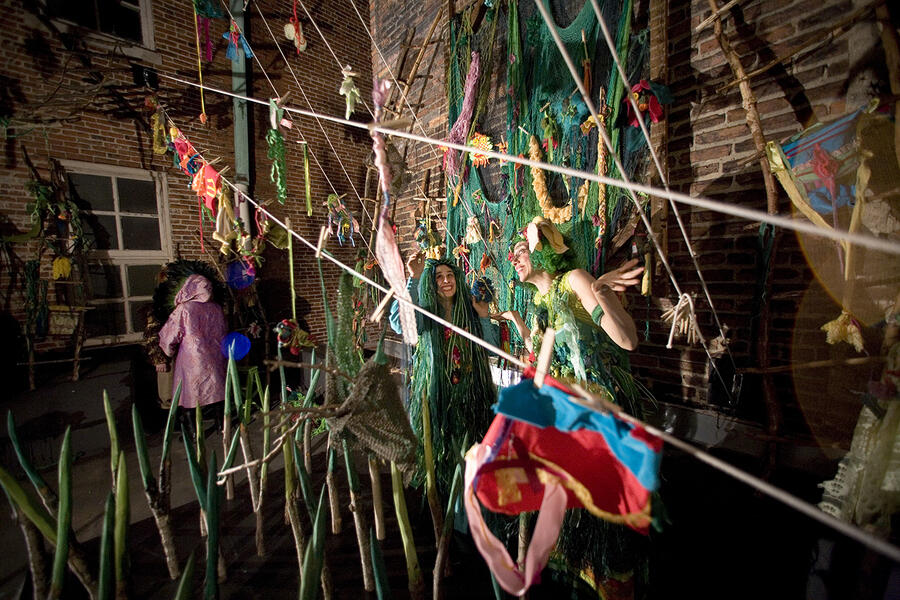 Temporary Nature_Transmod_02.jpg
Temporary Nature_Transmod_02.jpg -
 Temporary Nature_Transmod_6.jpg
Temporary Nature_Transmod_6.jpg -
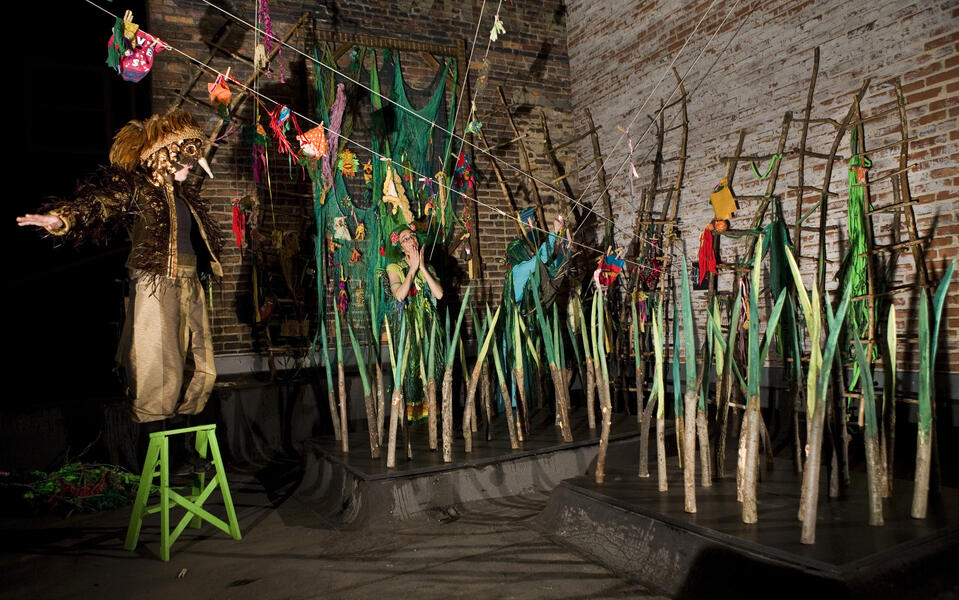 Temporary Nature_Transmod_03.jpg
Temporary Nature_Transmod_03.jpg -
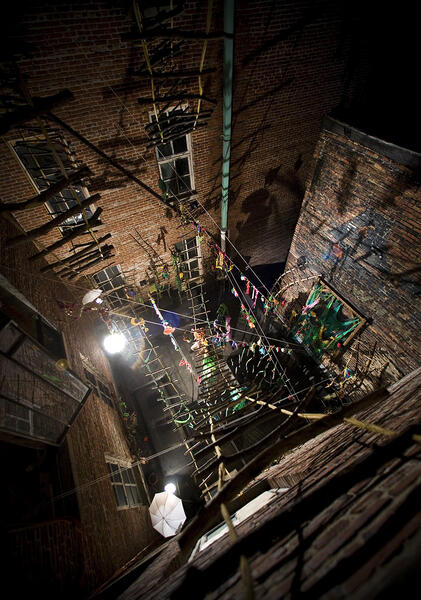 Temporary Nature_Transmod_04.jpg
Temporary Nature_Transmod_04.jpg
Uppity Ladies
A live performance for the 2007 Transmodern Festival . Created by Melissa Webb, M. Jane Taylor, and Company.
In the original living installation, stilted ladies in turn of the century dress sip tea, sniff flowers, eat cupcakes, and open gifts at their tall table. Hard-laboring garden gnomes provide them this luxurious lifestyle.
At first the gnomes work happily, but soon become disgruntled due to decreased break-times and excessive use of their bodies for croquet wickets. A passionate protest ensues.
The ladies' loyal butler tries to moderate to no avaiL until they are offered peace in the form of cupcakes.
Satisfied (for now) they get back to their work. And so the cycle continues...
"Opulent overlings and unprepossessing underlings glide and tromp forth in a frolicsomeâ?¦ yet begrudging display. A highbrow coterie of long-legged, albeit dainty darlings shares a stilted co-existence with a lowbrow crew of the submissive stripe. A walk in the park with the Chic She's and Shabby He's of yester-year..".
Photos by Uli Loskot and Alexander Webb
In the original living installation, stilted ladies in turn of the century dress sip tea, sniff flowers, eat cupcakes, and open gifts at their tall table. Hard-laboring garden gnomes provide them this luxurious lifestyle.
At first the gnomes work happily, but soon become disgruntled due to decreased break-times and excessive use of their bodies for croquet wickets. A passionate protest ensues.
The ladies' loyal butler tries to moderate to no avaiL until they are offered peace in the form of cupcakes.
Satisfied (for now) they get back to their work. And so the cycle continues...
"Opulent overlings and unprepossessing underlings glide and tromp forth in a frolicsomeâ?¦ yet begrudging display. A highbrow coterie of long-legged, albeit dainty darlings shares a stilted co-existence with a lowbrow crew of the submissive stripe. A walk in the park with the Chic She's and Shabby He's of yester-year..".
Photos by Uli Loskot and Alexander Webb
-
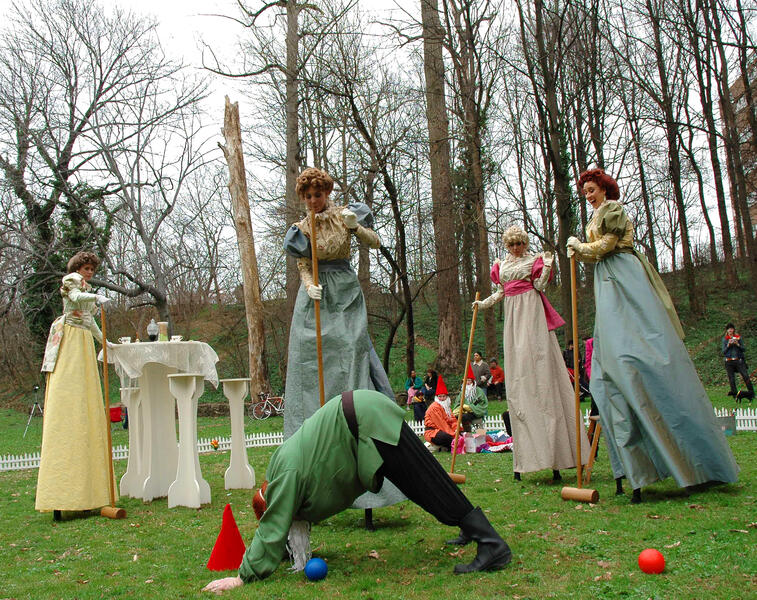 The Uppity LadiesA Garden Gnome character acts as a wicket for the Uppity Ladies' game of croquet. photo by Uli Loskot
The Uppity LadiesA Garden Gnome character acts as a wicket for the Uppity Ladies' game of croquet. photo by Uli Loskot -
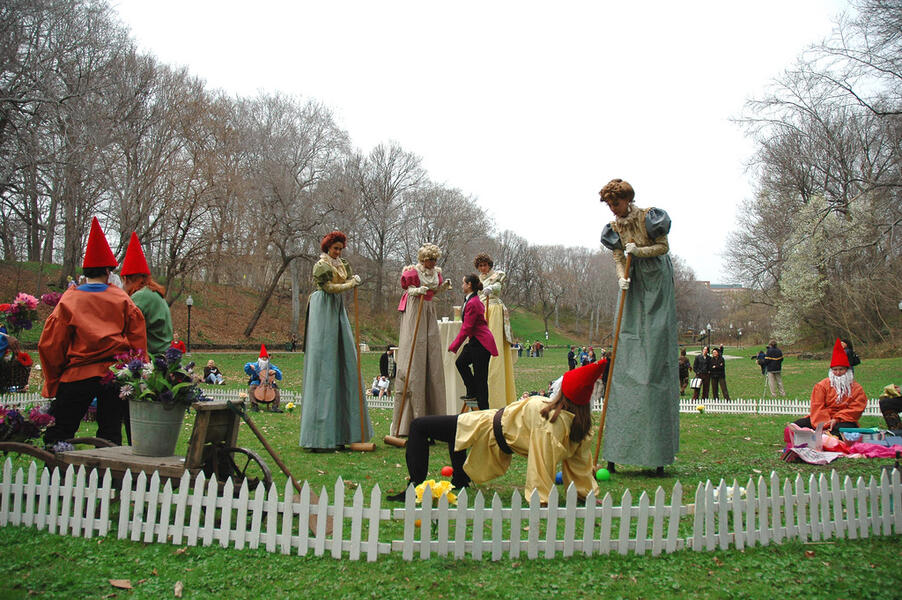 The Uppity Ladies (Performance detail)
The Uppity Ladies (Performance detail) -
 The Uppity Ladies (Performance detail)
The Uppity Ladies (Performance detail) -
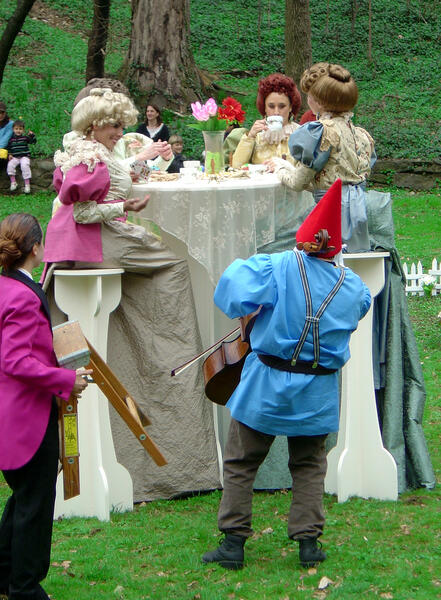 Light EntertainmentOne of the Gnomes (played by Bonnie Obel) plays music for the Ladies. photo by Uli Loskot
Light EntertainmentOne of the Gnomes (played by Bonnie Obel) plays music for the Ladies. photo by Uli Loskot -
 Chaos EnsuesThe Gnome protest gets well out of the Ladies' control despite furious bell-ringing. Photo by Uli Loskot
Chaos EnsuesThe Gnome protest gets well out of the Ladies' control despite furious bell-ringing. Photo by Uli Loskot -
 Control is LostThe Ladies pout because there is no one left to make them tea... Photo by Alexander Webb
Control is LostThe Ladies pout because there is no one left to make them tea... Photo by Alexander Webb -
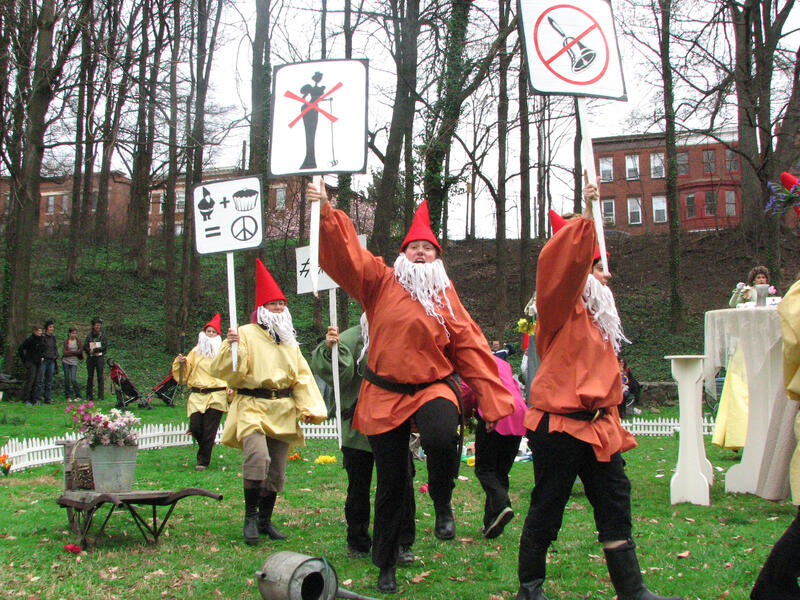 The Gnomes Protest
The Gnomes Protest -
 Gnome + Cupcake = PeaceA gnome gets his wish and naps happily... Performer: Spoon Popkin, Photo by Alexander Webb
Gnome + Cupcake = PeaceA gnome gets his wish and naps happily... Performer: Spoon Popkin, Photo by Alexander Webb -
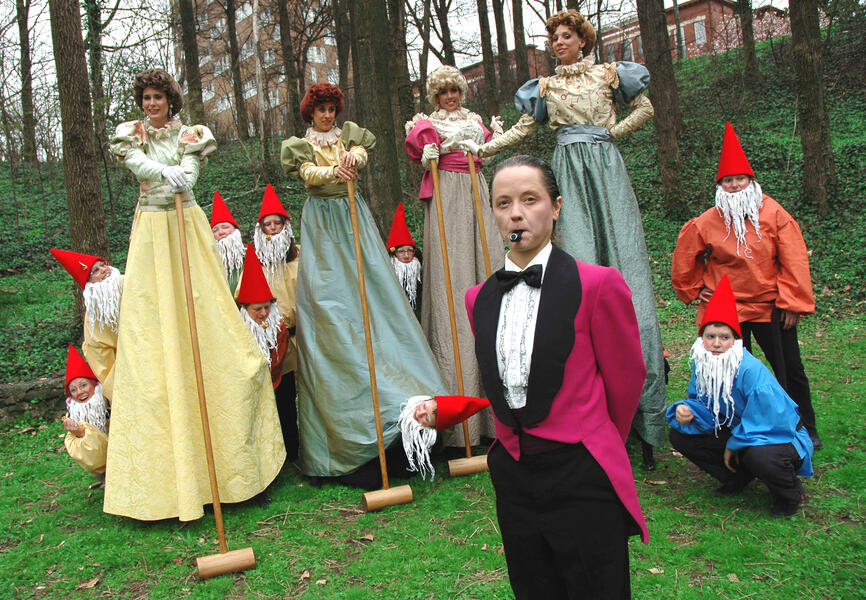 Uppity Family PhotoA set up shot of all the characters in the "Uppity Ladies" photo by Uli Loskot
Uppity Family PhotoA set up shot of all the characters in the "Uppity Ladies" photo by Uli Loskot


